VEGA Grieshaber KG PS60XK2 Pulse Radar Sensors for Continuous Level Measurement User Manual TYPE CERTIFICATION REPORT
VEGA Grieshaber KG Pulse Radar Sensors for Continuous Level Measurement TYPE CERTIFICATION REPORT
Users Manual Rev 0.2
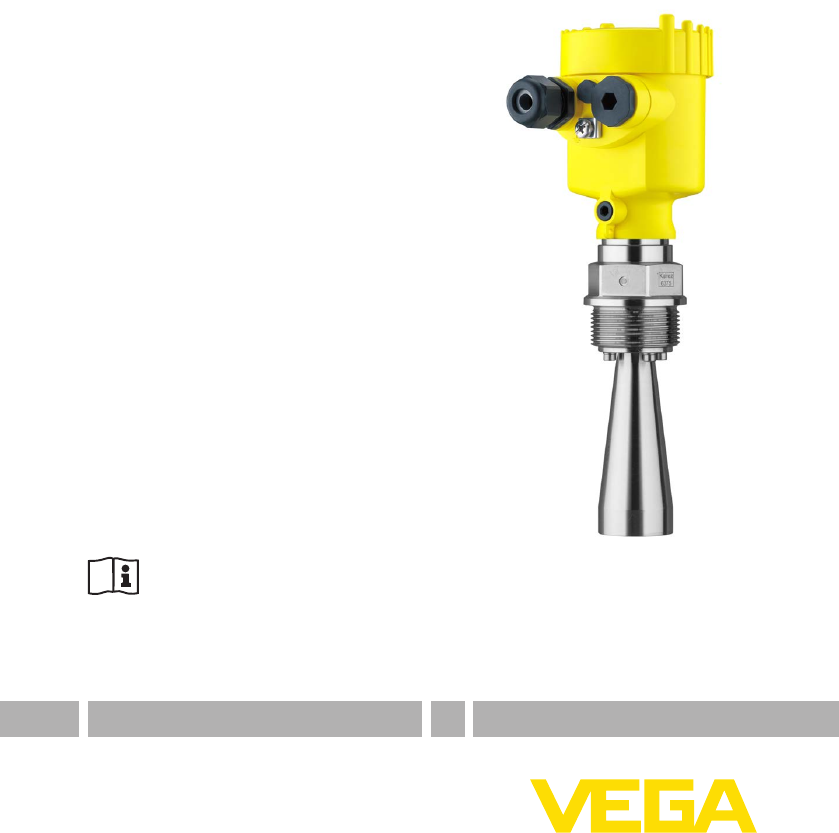
Operating Instructions
Radar sensor for continuous level
measurement of liquids
VEGAPULS 62
4 … 20 mA/HART - two-wire
Document ID: 36503

2
Contents
VEGAPULS 62 • 4 … 20 mA/HART - two-wire
36503-EN-161221
Contents
1 About this document
1.1 Function ........................................................................................................................... 4
1.2 Target group ..................................................................................................................... 4
1.3 Symbols used................................................................................................................... 4
2 For your safety
2.1 Authorised personnel ....................................................................................................... 5
2.2 Appropriate use ................................................................................................................ 5
2.3 Warning about incorrect use ............................................................................................. 5
2.4 General safety instructions ............................................................................................... 5
2.5 CE conformity ................................................................................................................... 6
2.6 NAMUR recommendations .............................................................................................. 6
2.7 Radio license for Europe .................................................................................................. 6
2.8 Radio license for USA ...................................................................................................... 7
2.9 Radio license for Canada ................................................................................................. 7
2.10 Environmental instructions ............................................................................................... 9
3 Product description
3.1 Conguration .................................................................................................................. 11
3.2 Principle of operation...................................................................................................... 12
3.3 Packaging, transport and storage ................................................................................... 13
3.4 Accessories and replacement parts ............................................................................... 13
4 Mounting
4.1 General instructions ....................................................................................................... 16
4.2 Mounting preparations ................................................................................................... 17
4.3 Mounting instructions ..................................................................................................... 19
4.4 Measurement setup - Pipes ........................................................................................... 24
4.5 Measurement setup - Flow ............................................................................................. 29
5 Connecting to power supply
5.1 Preparing the connection ............................................................................................... 31
5.2 Connecting ..................................................................................................................... 32
5.3 Wiring plan, single chamber housing.............................................................................. 34
5.4 Wiring plan, double chamber housing ............................................................................ 34
5.5 Wiring plan, double chamber housing Ex d ia ................................................................ 36
5.6 Double chamber housing with DISADAPT ..................................................................... 37
5.7 Wiring plan - version IP 66/IP 68, 1 bar ........................................................................... 38
5.8 Switch-on phase............................................................................................................. 38
6 Set up with the display and adjustment module
6.1 Insert display and adjustment module ............................................................................ 39
6.2 Adjustment system ......................................................................................................... 40
6.3 Measured value indication - Selection national language ............................................... 41
6.4 Parameter adjustment .................................................................................................... 42
6.5 Saving the parameter adjustment data ........................................................................... 60
7 Setup with PACTware
7.1 Connect the PC .............................................................................................................. 61
7.2 Parameter adjustment .................................................................................................... 62
7.3 Saving the parameter adjustment data ........................................................................... 63

3
Contents
VEGAPULS 62 • 4 … 20 mA/HART - two-wire
36503-EN-161221
8 Set up with other systems
8.1 DD adjustment programs ............................................................................................... 64
8.2 Field Communicator 375, 475 ........................................................................................ 64
9 Diagnosis, asset management and service
9.1 Maintenance .................................................................................................................. 65
9.2 Diagnosis memory ......................................................................................................... 65
9.3 Asset Management function ........................................................................................... 66
9.4 Rectify faults ................................................................................................................... 69
9.5 Exchanging the electronics module ................................................................................ 73
9.6 Software update ............................................................................................................. 74
9.7 How to proceed if a repair is necessary .......................................................................... 74
10 Dismount
10.1 Dismounting steps.......................................................................................................... 75
10.2 Disposal ......................................................................................................................... 75
11 Supplement
11.1 Technical data ................................................................................................................ 76
11.2 Dimensions .................................................................................................................... 85
11.3 Industrial property rights ................................................................................................. 95
11.4 Trademark ...................................................................................................................... 95
Safety instructions for Ex areas
TakenoteoftheExspecicsafetyinstructionsforExapplications.
These instructions are attached as documents to each instrument
with Ex approval and are part of the operating instructions manual.
Editing status: 2016-01-29
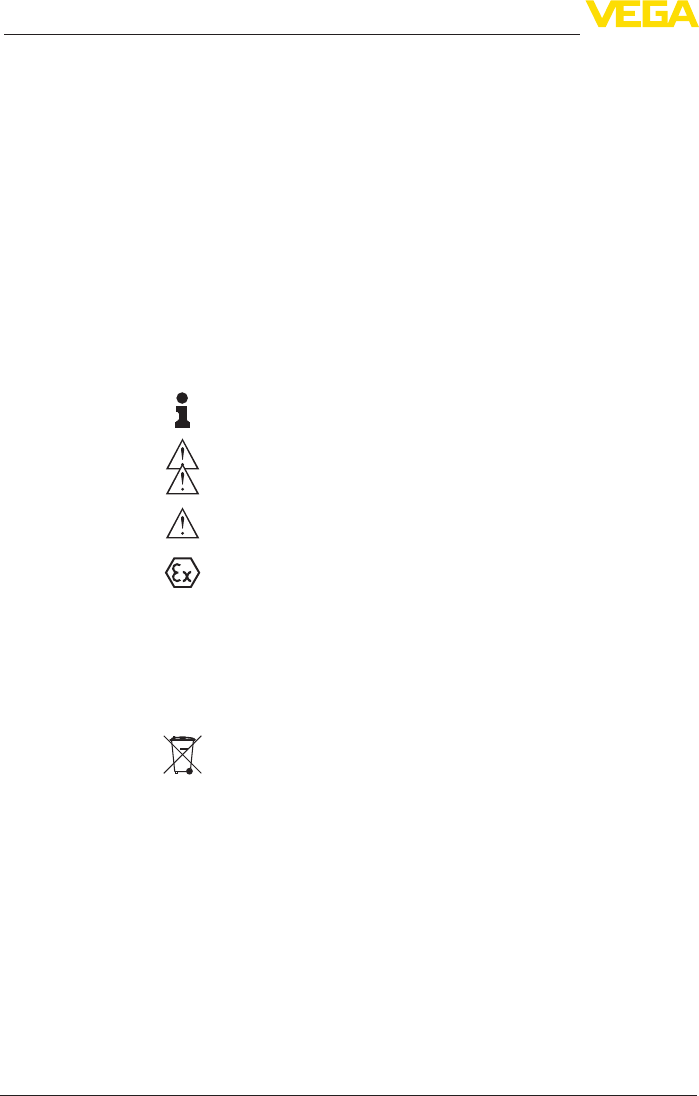
4
1 About this document
VEGAPULS 62 • 4 … 20 mA/HART - two-wire
36503-EN-161221
1 About this document
1.1 Function
This operating instructions manual provides all the information you
need for mounting, connection and setup as well as important instruc-
tionsformaintenanceandfaultrectication.Pleasereadthisinforma-
tion before putting the instrument into operation and keep this manual
accessible in the immediate vicinity of the device.
1.2 Target group
This operating instructions manual is directed to trained specialist
personnel. The contents of this manual should be made available to
these personnel and put into practice by them.
1.3 Symbols used
Information, tip, note
This symbol indicates helpful additional information.
Caution: If this warning is ignored, faults or malfunctions can result.
Warning: If this warning is ignored, injury to persons and/or serious
damage to the instrument can result.
Danger: If this warning is ignored, serious injury to persons and/or
destruction of the instrument can result.
Ex applications
This symbol indicates special instructions for Ex applications.
• List
The dot set in front indicates a list with no implied sequence.
→ Action
This arrow indicates a single action.
1 Sequence of actions
Numbers set in front indicate successive steps in a procedure.
Battery disposal
This symbol indicates special information about the disposal of bat-
teries and accumulators.

5
2 For your safety
VEGAPULS 62 • 4 … 20 mA/HART - two-wire
36503-EN-161221
2 For your safety
2.1 Authorised personnel
All operations described in this operating instructions manual must
be carried out only by trained specialist personnel authorised by the
plant operator.
During work on and with the device the required personal protective
equipment must always be worn.
2.2 Appropriate use
VEGAPULS 62 is a sensor for continuous level measurement.
Youcannddetailedinformationabouttheareaofapplicationin
chapter "Product description".
Operational reliability is ensured only if the instrument is properly
usedaccordingtothespecicationsintheoperatinginstructions
manual as well as possible supplementary instructions.
2.3 Warning about incorrect use
Inappropriate or incorrect use of the instrument can give rise to
application-specichazards,e.g.vesseloverllordamagetosystem
components through incorrect mounting or adjustment. Also the pro-
tectivecharacteristicsoftheinstrumentcanbeinuenced.
2.4 General safety instructions
This is a state-of-the-art instrument complying with all prevailing
regulations and guidelines. The instrument must only be operated in a
technicallyawlessandreliablecondition.Theoperatorisresponsible
for the trouble-free operation of the instrument.
During the entire duration of use, the user is obliged to determine the
compliance of the necessary occupational safety measures with the
current valid rules and regulations and also take note of new regula-
tions.
The safety instructions in this operating instructions manual, the na-
tional installation standards as well as the valid safety regulations and
accident prevention rules must be observed by the user.
For safety and warranty reasons, any invasive work on the device
beyond that described in the operating instructions manual may be
carried out only by personnel authorised by the manufacturer. Arbi-
traryconversionsormodicationsareexplicitlyforbidden.
The safety approval markings and safety tips on the device must also
be observed.
Depending on the instrument version, the emitting frequencies are in
the C, K or W band range. The low emitting frequencies are far below
the internationally approved limit values. When used correctly, the
device poses no danger to health.

6
2 For your safety
VEGAPULS 62 • 4 … 20 mA/HART - two-wire
36503-EN-161221
2.5 CE conformity
ThedevicefullsthelegalrequirementsoftheapplicableECguide-
lines.ByaxingtheCEmarking,weconrmsuccessfultestingofthe
product.
YoucanndtheCECerticateofConformityinthedownloadsection
of our homepage.
Electromagnetic compatibility
Instruments in four-wire or Ex-d-ia version are designed for use in an
industrial environment. Nevertheless, electromagnetic interference
from electrical conductors and radiated emissions must be taken into
account, as is usual with class A instruments according to EN 61326-
1.Iftheinstrumentisusedinadierentenvironment,theelectromag-
netic compatibility to other instruments must be ensured by suitable
measures.
2.6 NAMUR recommendations
NAMUR is the automation technology user association in the process
industry in Germany. The published NAMUR recommendations are
acceptedasthestandardineldinstrumentation.
ThedevicefullstherequirementsofthefollowingNAMURrecom-
mendations:
•NE 21 – Electromagnetic compatibility of equipment
•NE 43 – Signal level for malfunction information from measuring
transducers
•NE53–Compatibilityofelddevicesanddisplay/adjustment
components
•NE107–Self-monitoringanddiagnosisofelddevices
For further information see www.namur.de.
2.7 Radio license for Europe
The instrument meets the legal requirements of the EU directive
1999/5/EC(R&TTED)andwastestedacc.totheharmonizedstand-
ard EN 302372-1/2 V1.2.1 (2011-02) (Tank Level Probing Radar) and
is approved for use within closed vessels.
For operation inside of closed vessels, the following conditions must
befullled:
•The instrument must be permanently mounted on a closed vessel
made of metal, reinforced concrete, or comparable attenuating
materials
•Flanges,processttingsandmountingaccessoriesmustensure
the microwave impermeability of the vessel and not let the radar
signal escape to the outside
•If necessary, existing viewing windows in the vessel must be
coated with a microwave impermeable material (e.g. electrically
conductive coating)
•Manholesandangesonthevesselmustbeclosedandsealedto
avoid penetration of the radar signal

7
2 For your safety
VEGAPULS 62 • 4 … 20 mA/HART - two-wire
36503-EN-161221
•The instrument should be preferably mounted on top of the vessel
with antenna orientation downward
•The instrument must only be installed and maintained by appropri-
atelyqualiedsta
2.8 Radio license for USA
This approval is only valid for USA. Hence the following text is only
available in the English language.
This device complies with Part 15 of the FCC Rules. Operation is
subject to the following two conditions:
•This device may not cause interference, and
•This device must accept any interference, including interference
that may cause undesired operation of the device
This device is approved for unrestricted use only inside closed, sta-
tionaryvesselsmadeofmetal,concrete,andreinforcedberglass.
For operation outside of closed vessels, the following conditions must
befullled:
•This device shall be installed and maintained to ensure a verti-
cally downward orientation of the transmit antenna's main beam.
Furthermore, the use of any mechanism that does not allow the
main beam of the transmitter to be mounted vertically downward
is prohibited.
•Operation of the instrument with horn antennas ø 40 mm and ø 48
mm is only permitted within closed vessels.
•Thisdeviceshallbeinstalledonlyatfixedlocations.TheLPR
device shall not operate while being moved or while inside a mov-
ing container.
•Hand-held applications are prohibited.
•Marketing to residential consumers is prohibited.
Changesormodicationsnotexpresslyapprovedbythemanufac-
turer could void the user’s authority to operate this equipment.
2.9 Radio license for Canada
This approval is only valid for Canada. Hence the following texts are
only available in the English/French language.
This device complies with Industry Canada's license-exempt RSS
standards. Operation is subject to the following conditions:
•This device may not cause interference, and
•This device must accept any interference, including interference
that may cause undesired operation of the device
This device has been approved for both closed containers and open-
air environments with the following limitations:
•ClosedContainers:Forinstallationsutilizingatiltduringinstalla-
tion: This device is limited to installation in a completely enclosed

8
2 For your safety
VEGAPULS 62 • 4 … 20 mA/HART - two-wire
36503-EN-161221
containermadeofmetal,concrete,andreinforcedberglassto
prevent RF emissions, which can otherwise interfere with aeronau-
tical navigation, the maximum approved tilt angel is 10°.
•Open Air Environment: For operation outside of closed vessels,
thefollowingconditionmustbefulfilled:Thisdevixeshallbe
installed and maintained to ensure a vertically downward orienta-
tion of the transmit antenna's main beam. Furthermore, the use of
any mechanism that does not allow the main beam of the
transmit-ter to be mounted vertically downward is prohibited.
•Operation of the instrument with horn antennas ø 40 mm and ø 48
mm is only permitted within closed vessels
The installation of the LPR/TLPR device shall be done by trained
installers, in strict compliance with the manufacture's instructions.
Thisdeviceshallbeinstalledonlyatxedlocations.TheLPRdevice
shall not operate while being moved or while inside a moving con-
tainer.
Hand-held applications are prohibited.
Marketing to residential consumers is prohibited.
The use of this device is on a "no-interference, no-protection" basis.
That ist, the user shall accept operatings of high-powered radar in the
same frequency band which may interfere with or damage this device.
However, devices found to interfere with primary licensing operations
will be required to be removed at the user's expense.
The installer/user of this device shall ensure that it is at least 10 km
from the Dominion Astrophysical Radio Observatory (DRAO) near
Penticton, British Columbia. The coordinates of the DRAO are latitude
49°19′15″Nandlongitude119°37′12″W.Fordevicesnotmeeting
this 10 km separation (e.g., those in the Okanagan Valley, British Co-
lumbia,) the installer/user must coordinate with, and obtain the written
concurrence of, the Director of the DRAO before the equipment can
be installed or operated. The Director of the DRAO may be contacted
at 250-497-2300 (tel.)or 250-497-2355 (fax). (Alternatively, the Man-
ager, Regulatory Standards, Industry Canada, may be contacted.)
Le présent appareil est conforme aux CNR d’Industrie Canada ap-
plicables aux appareils radio exempts de licence. L’exploitation est
autorisée aux conditions suivantes:
•L’appareil ne doit pas produire de brouillage; et
•L’utilisateur de l’appareil doit accepter tout brouillage radioélect-
rique subi, même si le brouillage est susceptible d’en compromet-
tre le fonctionnement.
Cet appareil est homologué pour une utilisation dans les cuves fer-
mées et les environnements ouverts avec les restrictions suivantes :
•Cuves fermées : Pour les installations impliquant une inclinaison
lors de l'installation : cet appareil ne doit être installé que dans
une cuve totalement fermée en métal, en béton ou en matière

9
2 For your safety
VEGAPULS 62 • 4 … 20 mA/HART - two-wire
36503-EN-161221
plastiquerenforcéedebresdeverre,pourempêcherlesémis-
sions RF susceptibles d'interférer avec la navigation aéronautique.
L'angle d'inclinaison maximum autorisé est de 10°.
• Environnement ouvert : Pour l'utilisation hors des cuves
fermées, la condition suivante doit être remplie : L'appareil doit
être installé et entretenu de manière à garantir une orientation
verticale vers le bas du faisceau principal de l’antenne émettrice.
De plus, l’utilisation de tout mécanisme ne permettant pas
l’orientation ver-ticale vers le bas du faisceau principal de
l’émetteur est interdite
•Il est uniquement autorisé d'exploiter l'appareil avec les
antennes cônes ø 40 mm et ø 48 mm dans des boîtiers fermés.
L’installationd’undispositifLPRouTLPRdoitêtreeectuéepardes
installateursqualiés,enpleineconformitéaveclesinstructionsdu
fabricant.
Cetappareilnedoitêtreinstalléqu'àdesemplacementsxes.
L’appareil LPR ne doit pas être utilisé pendant qu’il est en train d’être
déplacé ou se trouve dans un conteneur en mouvement.
Les applications portables sont interdites.
La vente à des particuliers est interdite
Ce dispositif ne peut être exploité qu'en régime de non-brouillage
et de non-protection, c'est-à-dire que l'utilisateur doit accepter que
des radars de haute puissance de la même bande de fréquences
puissent brouiller ce dispositif ou même l'endommager. D'autre part,
les capteurs de niveau qui perturbent une exploitation autorisée par
licence de fonctionnement principal doivent être enlevés aux frais de
leur utilisateur.
La personne qui installe/utilise ce capteur de niveau doit s'assurer
qu'il se trouve à au moins 10 km de l'Observatoire fédéral de radioas-
trophysique (OFR) de Penticton en Colombie-Britannique. Les coor-
donnéesdel'OFRsont:latitudeN49°19′15″,longitudeO119°37′
12″.Lapersonnequiinstalle/utiliseundispositifnepouvantrespecter
cette distance de 10km (p. ex. dans la vallée de l'Okanagan [Colom-
bie-Britannique])doitseconcerteravecledirecteurdel'OFRan
d’obtenir de sa part une autorisation écrite avant que l'équipement
ne puisse être installé ou mis en marche. Le directeur de l'OFR peut
être contacté au 250-497-2300 (tél.) ou au 250-497-2355 (fax). (Le
Directeur des Normes réglementaires d'Industrie Canada peut égale-
ment être contacté).
2.10 Environmental instructions
Protection of the environment is one of our most important duties.
That is why we have introduced an environment management system
with the goal of continuously improving company environmental pro-
tection.Theenvironmentmanagementsystemiscertiedaccording
to DIN EN ISO 14001.

10
2 For your safety
VEGAPULS 62 • 4 … 20 mA/HART - two-wire
36503-EN-161221
Pleasehelpusfullthisobligationbyobservingtheenvironmental
instructions in this manual:
•Chapter "Packaging, transport and storage"
•Chapter "Disposal"
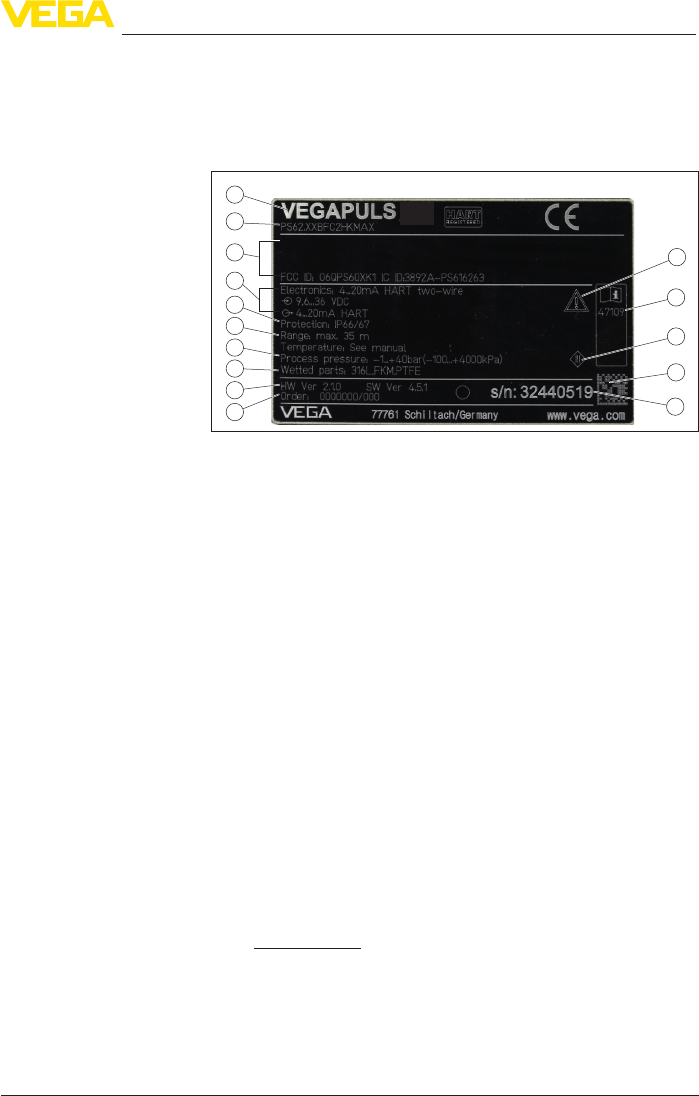
11
3 Product description
VEGAPULS 62 • 4 … 20 mA/HART - two-wire
36503-EN-161221
3 Product description
3.1 Conguration
Thetypelabelcontainsthemostimportantdataforidenticationand
use of the instrument:
2
1
15
13
14
12
11
5
3
6
4
7
8
10
9
Fig. 1: Layout of the type label (example)
1 Instrument type
2 Product code
3 Approvals
4 Power supply and signal output, electronics
5 Protection rating
6 Measuring range
7 Process and ambient temperature, process pressure
8 Material, wetted parts
9 Hardware and software version
10 Order number
11 Serial number of the instrument
12 Data-Matrix-Code for smartphone app
13 Symbol of the device protection class
14 ID number, instrument documentation
15 Reminder to observe the instrument documentation
The type label contains the serial number of the instrument. With it
youcanndthefollowinginstrumentdataonourhomepage:
•Product code (HTML)
•Delivery date (HTML)
•Order-specicinstrumentfeatures(HTML)
•Operating instructions and quick setup guide at the time of ship-
ment (PDF)
•Order-specicsensordataforanelectronicsexchange(XML)
•Testcerticate(PDF)-optional
Go to www.vega.com "VEGA Tools" and "Instrument search". Enter
the serial number.
Alternatively, you can access the data via your smartphone:
•Download the smartphone app "VEGA Tools" from the "Apple App
Store" or the "Google Play Store"
•Scan the Data Matrix code on the type label of the instrument or
•Enter the serial number manually in the app
Type label
Serial number - Instru-
ment search

12
3 Product description
VEGAPULS 62 • 4 … 20 mA/HART - two-wire
36503-EN-161221
This operating instructions manual applies to the following instrument
versions:
• Hardware version from 2.1.0
• Software version from 4.5.1
Theinstrumentisavailableintwodierentelectronicsversions.Each
versioncanbeidentiedviatheproductcodeonthetypelabelas
well as on the electronics.
• Standard electronics type PS60HK.-
• Electronics with increased sensitivity type PS60HS.-
The scope of delivery encompasses:
• Radar sensor
• Documentation
– Quick setup guide VEGAPULS 62
– Instructions for optional instrument features
– Ex-specic"Safety instructions" (with Ex versions)
– Ifnecessary,furthercerticates
• DVD "Software & Documents", containing
– Operating instructions
– Safety instructions
– PACTware/DTM Collection
– Driver software
Information:
In the operating instructions manual, the optional instrument features
are described. The respective scope of delivery results from the order
specication.
3.2 Principle of operation
The VEGAPULS 62 radar sensor can be used in a wide variety of ap-
plications for continuous level measurement of liquids. It is suitable for
applications in storage vessels, reactors and process vessels, even
underextremelydicultprocessconditions.
Dependentontheapplicationrange,dierentversionsareused:
• Antenna
– Small tanks and process vessels, measurement of virtually all
products: Horn antenna ø 40 mm
– Storage tanks and process vessels, measurement of products
such as solvents, hydrocarbons and fuels under extremely dif-
cultprocessconditions:Horn antenna ø 48 … 95 mm
– Productswithlowεr value with large measuring distances:
Parabolic antenna
• Electronics
– Productswithanεrvalue≥1.8:Standard electronics
– Productswithanεrvalue<1.8,≥1.5;applicationswithverybad
reectiveproperties:Electronics with increased sensitivity
The actual values that can be reached depend on the measurement
conditions, the antenna system or the standpipe or bypass.
Scope of this operating
instructions manual
Versions
Scope of delivery
Application area

13
3 Product description
VEGAPULS 62 • 4 … 20 mA/HART - two-wire
36503-EN-161221
The antenna of the radar sensor emits short radar pulses with a
durationofapprox.1ns.Thesepulsesarereectedbytheproduct
and received by the antenna as echoes. The transit time of the radar
pulses from emission to reception is proportional to the distance and
hence to the level. The determined level is converted into an appropri-
ate output signal and outputted as measured value.
3.3 Packaging, transport and storage
Your instrument was protected by packaging during transport. Its
capacity to handle normal loads during transport is assured by a test
based on ISO 4180.
The packaging of standard instruments consists of environment-
friendly, recyclable cardboard. For special versions, PE foam or PE
foil is also used. Dispose of the packaging material via specialised
recycling companies.
Transport must be carried out in due consideration of the notes on the
transport packaging. Nonobservance of these instructions can cause
damage to the device.
The delivery must be checked for completeness and possible transit
damage immediately at receipt. Ascertained transit damage or con-
cealed defects must be appropriately dealt with.
Up to the time of installation, the packages must be left closed and
stored according to the orientation and storage markings on the
outside.
Unless otherwise indicated, the packages must be stored only under
the following conditions:
• Not in the open
• Dry and dust free
• Not exposed to corrosive media
• Protected against solar radiation
• Avoiding mechanical shock and vibration
• Storage and transport temperature see chapter "Supplement -
Technical data - Ambient conditions"
• Relative humidity 20 … 85 %
3.4 Accessories and replacement parts
The display and adjustment module PLICSCOM is used for measured
value indication, adjustment and diagnosis. It can be inserted into the
sensor and removed at any time.
Youcanndfurtherinformationintheoperatinginstructions"Display
and adjustment module PLICSCOM" (Document-ID 27835).
The interface adapter VEGACONNECT enables the connection of
communication-capable instruments to the USB interface of a PC. For
parameter adjustment of these instruments, the adjustment software
PACTware with VEGA-DTM is required.
Functional principle
Packaging
Transport
Transport inspection
Storage
Storage and transport
temperature
PLICSCOM
VEGACONNECT

14
3 Product description
VEGAPULS 62 • 4 … 20 mA/HART - two-wire
36503-EN-161221
Youcanndfurtherinformationintheoperatinginstructions"Interface
adapter VEGACONNECT" (Document-ID 32628).
The VEGADIS 81 is an external display and adjustment unit for VEGA
plics® sensors.
For sensors with double chamber housing the interface adapter
"DISADAPT" is also required for VEGADIS 81.
Youcanndfurtherinformationintheoperatinginstructions
"VEGADIS 81" (Document-ID 43814).
The adapter "DISADAPT" is an accessory part for sensors with dou-
ble chamber housings. It enables the connection of VEGADIS 81 to
the sensor housing via an M12 x 1 plug.
Youcanndfurtherinformationinthesupplementaryinstructions
"Adapter DISADAPT" (Document-ID 45250).
VEGADIS 82 is suitable for measured value indication and adjustment
of sensors with HART protocol. It is looped into the 4 … 20 mA/HART
signal cable.
Youcanndfurtherinformationintheoperatinginstructions
"VEGADIS 82" (Document-ID 45300).
PLICSMOBILE T61 is an external GSM/GPRS radio unit for transmis-
sion of measured values and for remote parameter adjustment of
plics® sensors. Adjustment is carried out via PACTware/DTM and the
integrated USB connection.
Youcanndfurtherinformationinthesupplementaryinstructions
"PLICSMOBILE T61" (Document-ID 37700).
PLICSMOBILE is an internal GSM/GPRS radio unit for transmission
ofmeasuredvaluesandforremotecongurationofplics® sensors.
Adjustment is carried out via PACTware/DTM and the integrated USB
connection.
Youcanndfurtherinformationinthesupplementaryinstructions
"PLICSMOBILE GSM/GPRS radio module" (Document-ID 36849).
The protective cover protects the sensor housing against soiling and
intense heat from solar radiation.
Youwillndadditionalinformationinthesupplementaryinstructions
manual "Protective cover" (Document-ID 34296).
Screwedangesareavailableindierentversionsaccordingtothe
following standards: DIN 2501, EN 1092-1, BS 10, ASME B 16.5,
JIS B 2210-1984, GOST 12821-80.
Youcanndadditionalinformationinthesupplementaryinstructions
manual "Flanges according to DIN-EN-ASME-JIS".
Electronics module "VEGAPULS series 60" is a replacement part for
radarsensorsofVEGAPULSseries60.Adierentversionisavailable
for each type of signal output.
VEGADIS 81
DISADAPT
VEGADIS 82
PLICSMOBILE T61
PLICSMOBILE
Protective cap
Flanges
Electronics module

15
3 Product description
VEGAPULS 62 • 4 … 20 mA/HART - two-wire
36503-EN-161221
Youcanndfurtherinformationintheoperatinginstructions"Elec-
tronics module VEGAPULS series 60" (Document-ID 36801).
The supplementary electronics is a replacement part for sensors with
double chamber housing and 4 … 20 mA/HART - two-wire.
Youcanndfurtherinformationintheoperatinginstructions"Supple-
mentary electronics for 4 … 20 mA/HART - two-wire" (Document-ID
42764).
The antenna impedance cone is a replacement part used for optimum
transmission of microwaves and for sealing against the process.
Youndfurtherinformationintheoperatinginstructions"Antenna
impedance cone VEGAPULS 62 and 68" (Document-ID 31381).
Supplementary electron-
ics for double chamber
housing
Antenna impedance cone

16
4 Mounting
VEGAPULS 62 • 4 … 20 mA/HART - two-wire
36503-EN-161221
4 Mounting
4.1 General instructions
Oninstrumentswiththreadedprocesstting,thehexagonmustbe
tightenedwithasuitablewrench.Fortheproperwrenchsizesee
chapter "Dimensions".
Warning:
The housing must not be used to screw the instrument in! Applying
tightening force can damage internal parts of the housing.
Protect your instrument against moisture ingress through the following
measures:
• Use the recommended cable (see chapter "Connecting to power
supply")
• Tighten the cable gland
• Whenmountinghorizontally,turnthehousingsothatthecable
gland points downward
• Loop the connection cable downward in front of the cable gland
This applies mainly to outdoor installations, in areas where humidity is
expected (e.g. through cleaning processes) and on cooled or heated
vessels.
Make sure that all parts of the instrument exposed to the process are
suitable for the existing process conditions.
These are mainly:
• Active measuring component
• Processtting
• Process seal
Process conditions are particularly:
• Process pressure
• Process temperature
• Chemical properties of the medium
• Abrasionandmechanicalinuences
Youcannddetailedinformationontheprocessconditionsinchapter
"Technical data" as well as on the type label.
Metric threads
In the case of instrument housings with metric thread, the cable
glands are screwed in at the factory. They are sealed with plastic
plugs as transport protection.
You have to remove these plugs before electrical connection.
NPT thread
In the case of instrument housings with self-sealing NPT threads, it is
not possible to have the cable entries screwed in at the factory. The
free openings for the cable glands are therefore covered with red dust
protection caps as transport protection. The dust protection caps do
notprovidesucientprotectionagainstmoisture.
Screwing in
Protection against mois-
ture
Suitability for the process
conditions
Cable glands
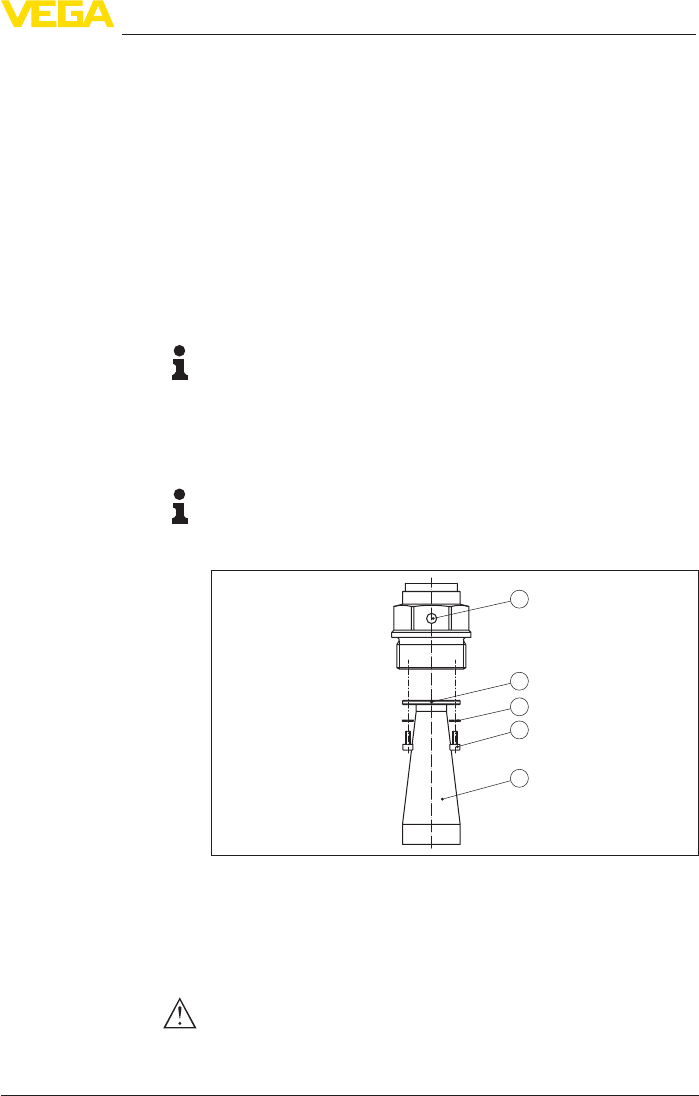
17
4 Mounting
VEGAPULS 62 • 4 … 20 mA/HART - two-wire
36503-EN-161221
Prior to setup you have to replace these protective caps with ap-
proved cable glands or close the openings with suitable blind plugs.
4.2 Mounting preparations
The instrument is also available in versions with an antenna whose
diameterislargerthantheprocesstting(thread,ange).Insuch
casestheantennamustbedisconnectedfromtheprocesstting
before mounting.
Proceed as follows:
1. Loosen the hexagon socket screws (3) on the antenna socket
withanAllenwrench(size3)
2. Remove the antenna (4)
Note:
The plastic cone may not be pulled out of the antenna socket.
3. Insert the antenna from below into the vessel socket and secure it
againstfallingo
4. Retighten the antenna with hexagon screws to the antenna
socket; max. torque see chapter "Technical data"
Note:
The radar sensor with rinsing air connection or with antenna exten-
sionhasanotchontheantennasocketforpolarization.Thisnotch
mustbealignedwiththemarkingontheprocesstting.
4
3
5
1
2
Fig. 2: Dismounting of the horn antenna
1 Markingontheprocesstting
2 Marking at the antenna socket
3 Screw locking device
4 Hexagon socket screws
5 Antenna
Caution:
A secure hold of the antenna is only ensured with the untwist guard.
The untwist guards inserted on site must hence be used again.
Depending on temperature range and antenna material, these are
Horn antenna
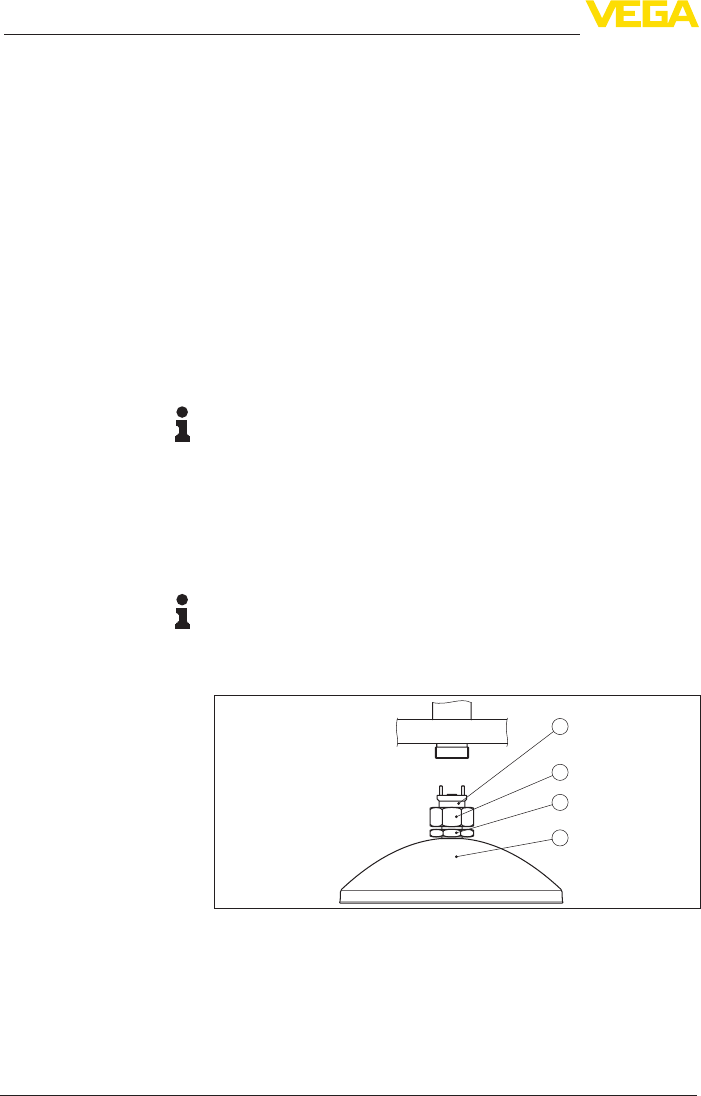
18
4 Mounting
VEGAPULS 62 • 4 … 20 mA/HART - two-wire
36503-EN-161221
spring rings according to DIN 217 or wedge lock washers according
to DIN 25 201.
Proceed as follows:
1. ClampVEGAPULS62withtheange,e.g.inabenchvice
2. Holdtheconnectionpiece(1)withawrenchontheatsurfaces
(widthacrossats22mm)
3. Loosen counter nut (3) completely with a wrench (width across
ats36mm)inthedirectionoftheantenna
4. Loosen compression nut (2) completely with a wrench (width
acrossats41mm)inthedirectionoftheantenna
5. Remove the parabolic antenna (4) axially
6. Mountsensorangeontheadapterangeandfastenittightly
7. Check if the O-ring seal is present on the connection piece and
make sure it is not damaged.
Note:
A damaged O-ring seal must be replaced: FKM (SHS FPM 70C3
GLT),FFKM(Kalrez6375)
8. Remount the parabolic antenna (4)
9. Fastencompressionnut(2)withawrench(widthacrossats41),
max. torque see chapter "Technical data"
10. Fastencounternut(3)withawrench(widthacrossats36),max.
torque see chapter "Technical data"
Note:
On the version with rinsing air connection, make sure that the holes
intheantennaandintheprocessttingcoincide.Thisensuresasuf-
cientairow(theairisledthroughtheholestothefeedsystem.A
rinsing of the whole parabolic antenna is not intended).
1
2
3
4
Fig. 3: Dismounting, parabolic antenna
1 Connection piece
2 Compression nut
3 Counter nut
4 Parabolic antenna
Parabolic antenna
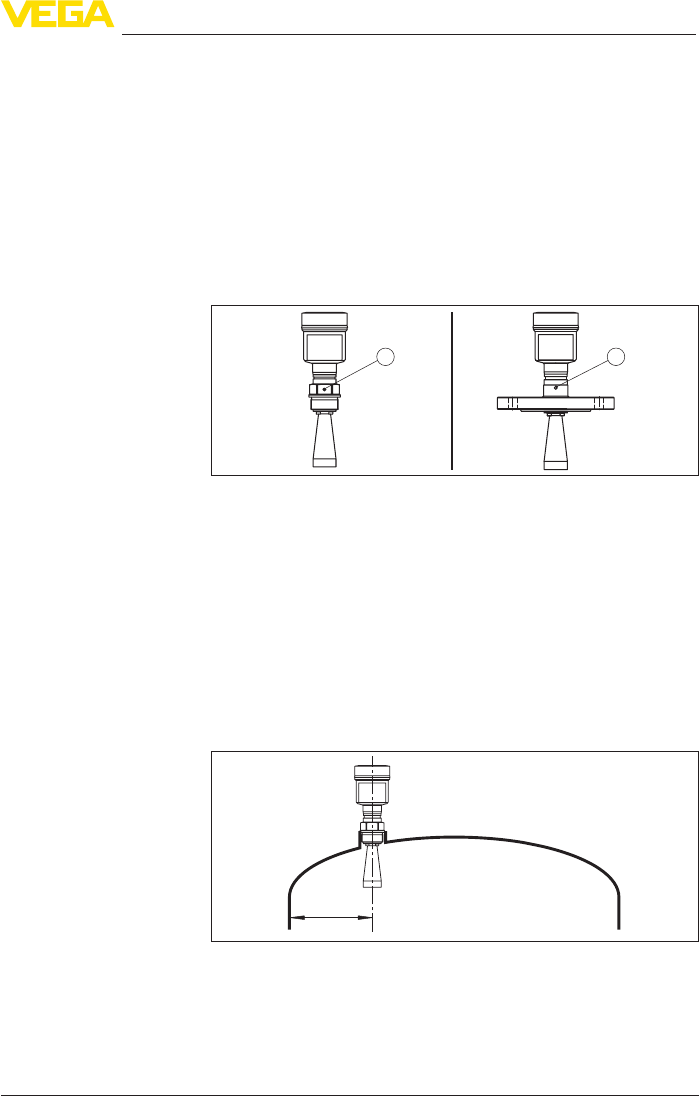
19
4 Mounting
VEGAPULS 62 • 4 … 20 mA/HART - two-wire
36503-EN-161221
4.3 Mounting instructions
The illustrations with the following mounting instructions show a radar
sensor with horn antenna. The mounting instructions apply analo-
gously also to the version with parabolic antenna.
The emitted radar impulses of the radar sensor are electromagnetic
waves. The polarisation is the direction of the electrical wave compo-
nent.Byturningtheinstrumentintheconnectionangeormounting
boss,thepolarisationcanbeusedtoreducetheeectsoffalse
echoes.
Thepositionofthepolarisationismarkedontheprocessttingofthe
instrument.
12
Fig. 4: Position of the polarisation
1 Marking with screwed version
2 Markingwithangeversion
When mounting the sensor, keep a distance of at least 200 mm
(7.874 in) from the vessel wall. If the sensor is installed in the center
of dished or round vessel tops, multiple echoes can arise. However,
these can be suppressed by an appropriate adjustment (see chapter
"Setup").
If you cannot maintain this distance, you should carry out a false
signal storage during setup. This applies particularly if buildup on the
vessel wall is expected. In such cases, we recommend repeating the
false signal storage at a later date with existing buildup.
> 200 mm
(7.87
")
Fig. 5: Mounting of the radar sensor on round vessel tops
In vessels with conical bottom it can be advantageous to mount the
sensor in the center of the vessel, as measurement is then possible
down to the lowest point of the vessel bottom.
Horn and parabolic
antenna
Polarisation
Installation position
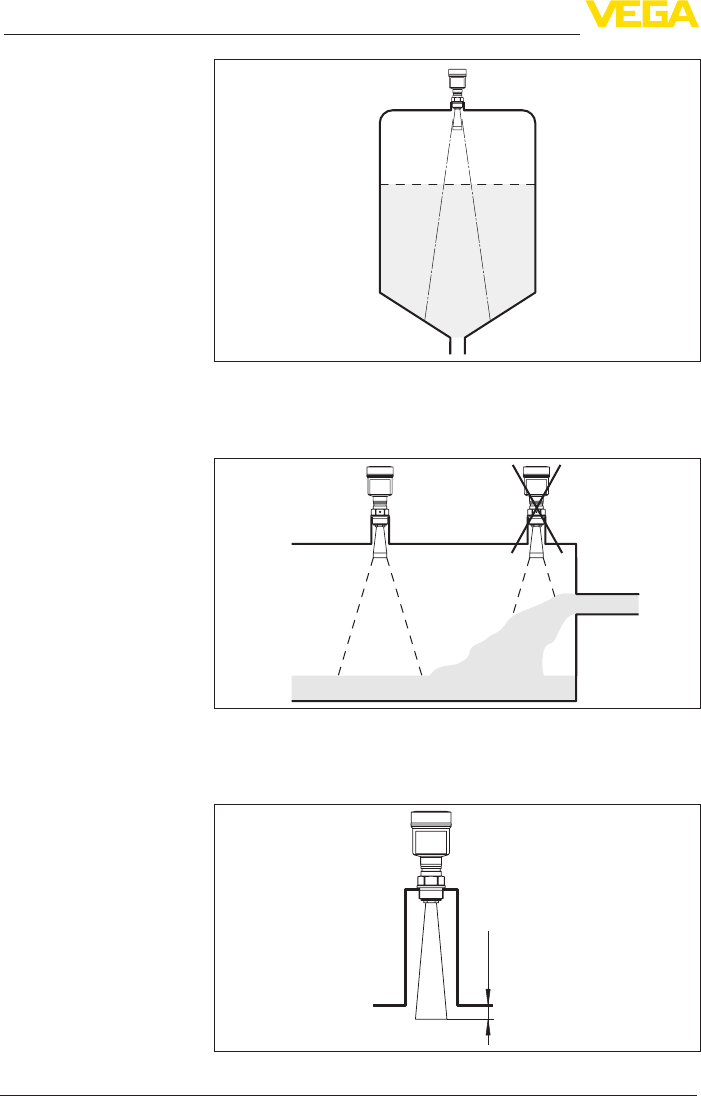
20
4 Mounting
VEGAPULS 62 • 4 … 20 mA/HART - two-wire
36503-EN-161221
Fig. 6: Mounting of the radar sensor on vessels with conical bottom
Donotmounttheinstrumentsinorabovethellingstream.Makesure
thatyoudetecttheproductsurface,nottheinowingproduct.
Fig.7:Mountingoftheradarsensorwithinowingmedium
The socket piece should be dimensioned in such a way that the
antenna end protrudes slightly out of the socket.
ca. 10 mm
Fig. 8: Recommended socket mounting with horn antenna
Inowingmedium
Mounting socket
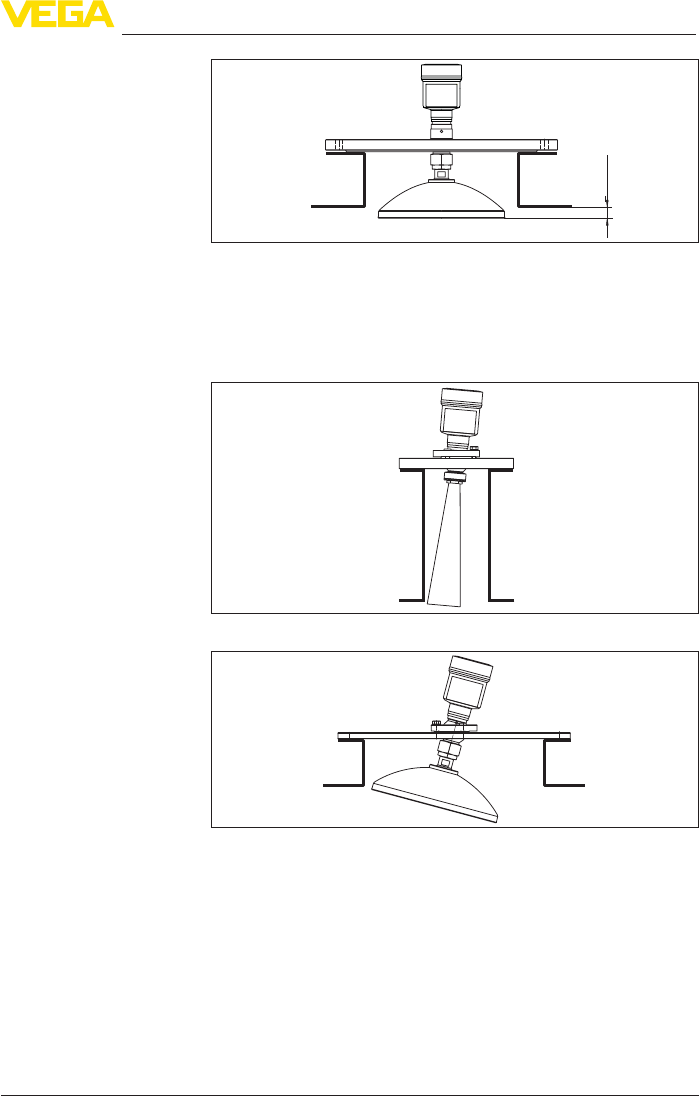
21
4 Mounting
VEGAPULS 62 • 4 … 20 mA/HART - two-wire
36503-EN-161221
> 10 mm
(0.39")
Fig. 9: Recommended socket mounting with parabolic antenna
When using a swivelling holder, keep in mind that the distance
between antenna and socket gets smaller as the inclination of the
sensorincreases.Additionalfalsereectionsmaybegeneratedwhich
caninuencethemeasuringresultatcloserange.Max.torquesee
chapter "Technical data"
Fig. 10: Distance between antenna and socket with horn antenna
Fig. 11: Distance between antenna and socket with parabolic antenna
Ifthemediumhasgoodreectiveproperties,VEGAPULS62with
horn antenna can also be mounted on a longer socket piece. Rec-
ommendedvaluesforsocketheightsarespeciedinthefollowing
illustration. You must carry out a false echo storage afterwards.
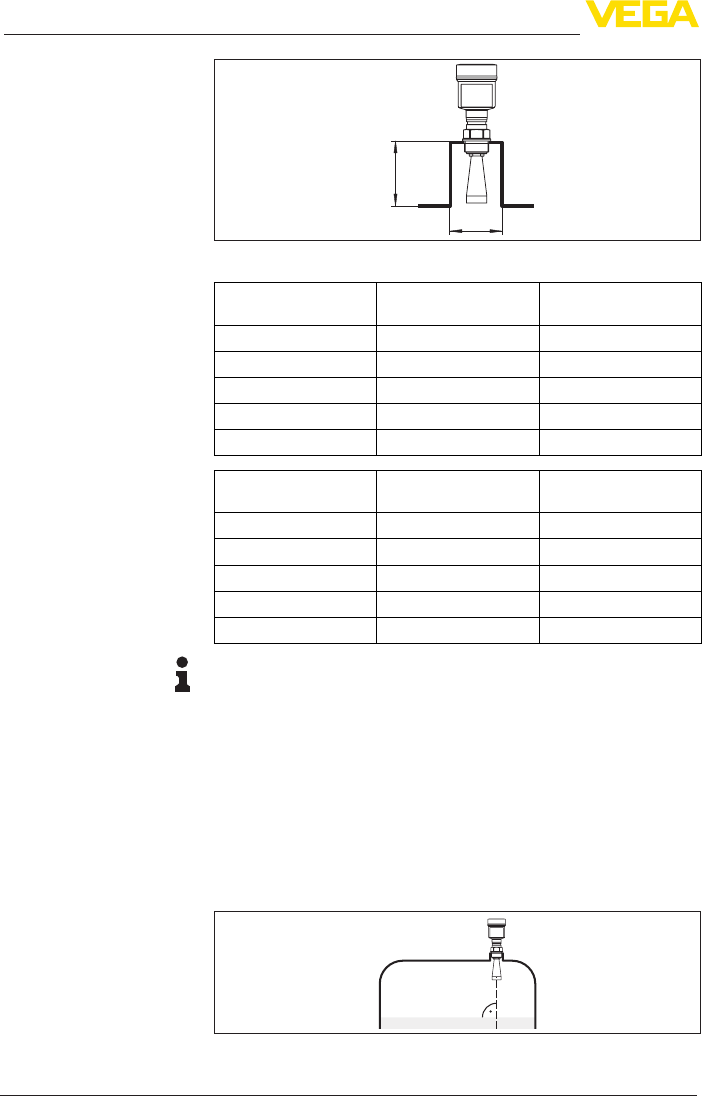
22
4 Mounting
VEGAPULS 62 • 4 … 20 mA/HART - two-wire
36503-EN-161221
d
hmax.
Fig. 12: Deviating socket dimensions
Socket diameter d Socket length h Recommended anten-
na diameter
40 mm ≤100mm 40 mm
50 mm ≤150mm 48 mm
80 mm ≤250mm 75 mm
100 mm ≤500mm 95 mm
150 mm ≤800mm 95 mm
Socket diameter d Socket length h Recommended anten-
na diameter
1½" ≤3.9in 1½"
2" ≤5.9in 2"
3" ≤9.8in 3"
4" ≤19.7in 4"
6" ≤31.5in 4"
Tip:
The instrument is also optionally available with an antenna extension.
The antenna length can be selected (either ex works or later) to allow
the antenna to protrude slightly out of the end of the mounting socket.
Duetotheantennaextensionhowever,disturbingreectionsare
generated in the close-up range. This can lead to an increase in the
requiredminimumdistance,especiallywithpoorlyreectingmedia
such as plastic powder. In practice, a cleanly constructed mounting
socket, if necessary with rounded edges, introduces fewer disturbing
inuencesthananantennaextension.
In liquids, direct the sensor as perpendicular as possible to the prod-
uct surface to achieve optimum measurement results.
Fig. 13: Alignment in liquids
Sensor orientation
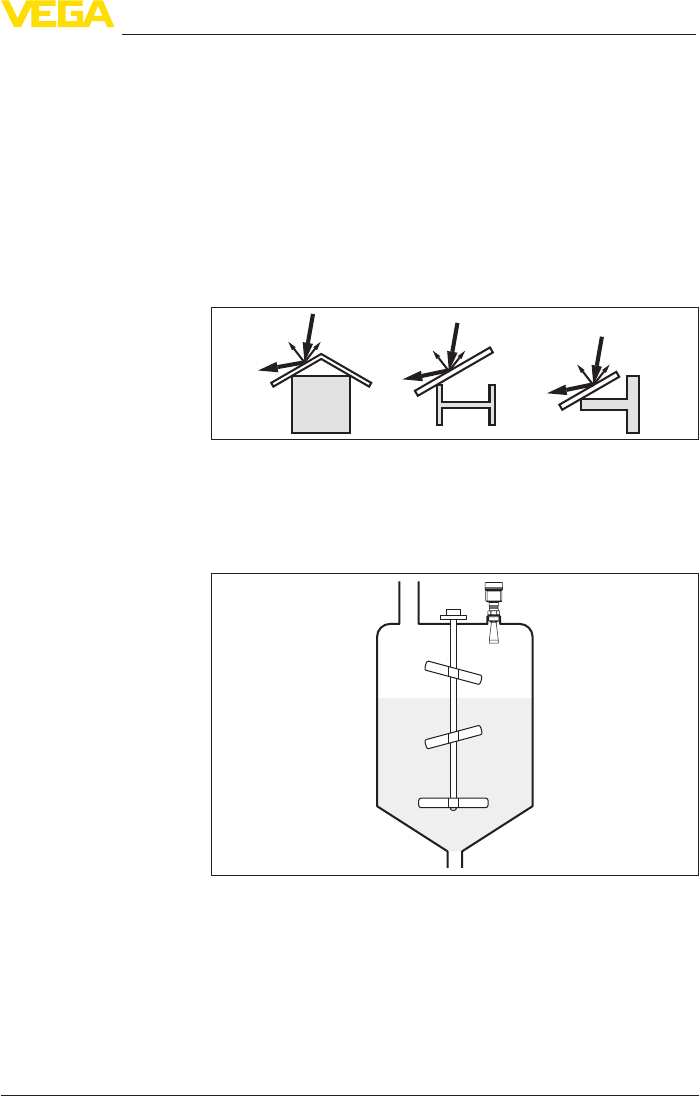
23
4 Mounting
VEGAPULS 62 • 4 … 20 mA/HART - two-wire
36503-EN-161221
The mounting location of the radar sensor should be a place where no
otherequipmentorxturescrossthepathoftheradarsignals.
Vessel installations, such as e.g. ladders, limit switches, heating spi-
rals, struts, etc., can cause false echoes and impair the useful echo.
Make sure when planning your measuring point that the radar sensor
has a "clear view" to the measured product.
In case of existing vessel installations, a false echo storage should be
carried out during setup.
If large vessel installations such as struts or supports cause false
echoes, these can be attenuated through supplementary measures.
Small,inclinedsheetmetalbaesabovetheinstallationsscatterthe
radarsignalsandpreventdirectinterferingreections.
Fig.14:Coverat,large-areaproleswithdeectors
If there are agitators in the vessel, a false signal suppression should
be carried out with the agitators in motion. This ensures that the
interferingreectionsfromtheagitatorsaresavedwiththebladesin
dierentpositions.
Fig. 15: Agitators
Throughtheactionoflling,stirringandotherprocessesinthevessel,
compact foam can form on the product surface, damping the emitted
signals considerably.
If foams are causing measurement errors, the biggest possible radar
antennas, the electronics with increased sensitivity or low frequency
radar sensors (C band) should be used.
Vessel installations
Agitators
Foam generation
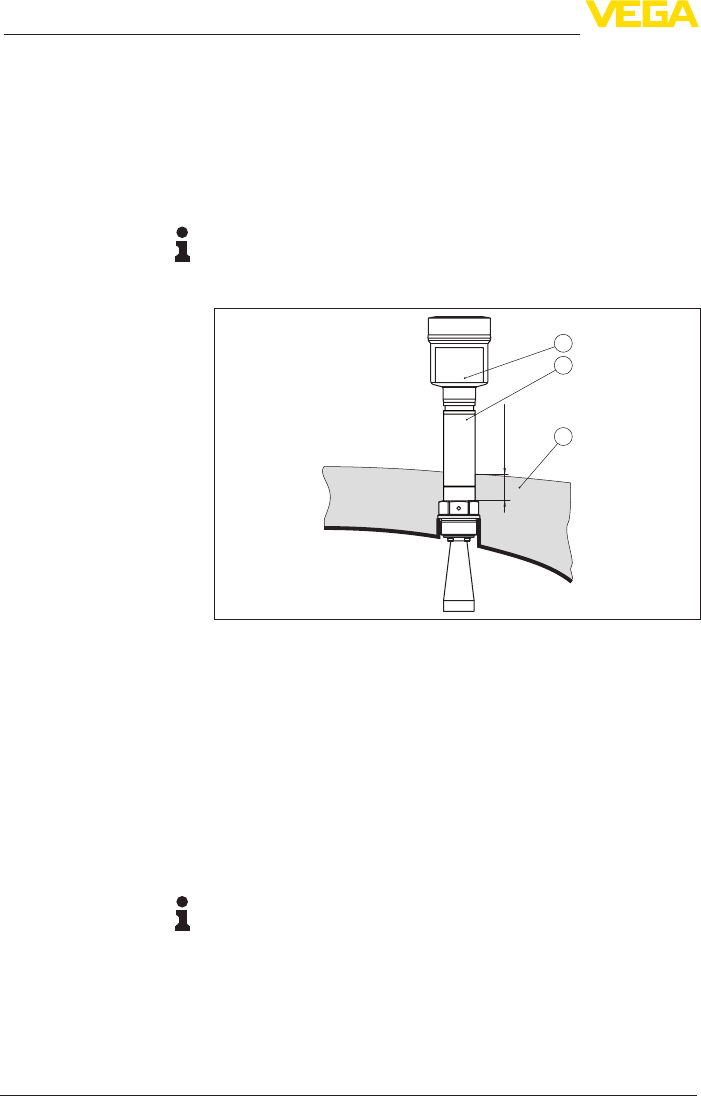
24
4 Mounting
VEGAPULS 62 • 4 … 20 mA/HART - two-wire
36503-EN-161221
As an alternative, sensors with guided microwave can be used. These
areunaectedbyfoamgenerationandarebestsuitedforsuchap-
plications.
Instruments for a temperature range up to 250 °C or up to 450 °C
haveadistancepiecebetweenprocessttingandelectronicshous-
ing. Ths distance piece is used for thermal decoupling of the electron-
ics against high process temperatures.
Information:
The spacer may only be incorporated up to a maximum of 50 mm into
the vessel insulation. Only then is a reliable temperature decoupling
guaranteed.
max. 50 mm
(1.97")
1
2
3
Fig. 16: Mounting the instrument on insulated vessels.
1 Electronics housing
2 Spacer
3 Vessel insulation
4.4 Measurement setup - Pipes
Byusingasurgepipeinthevessel,theinuenceofvesselinstalla-
tions and turbulence can be excluded. Under these prerequisites, the
measurementofproductswithlowdielectricvalues(εrvalue≤1.6)is
possible.
Note the following illustrations and instructions for measurement in a
surge pipe.
Information:
Measurement in a surge pipe is not recommended for extremely
adhesive products.
Mounting in the vessel
insulation
Measurement in a surge
pipe
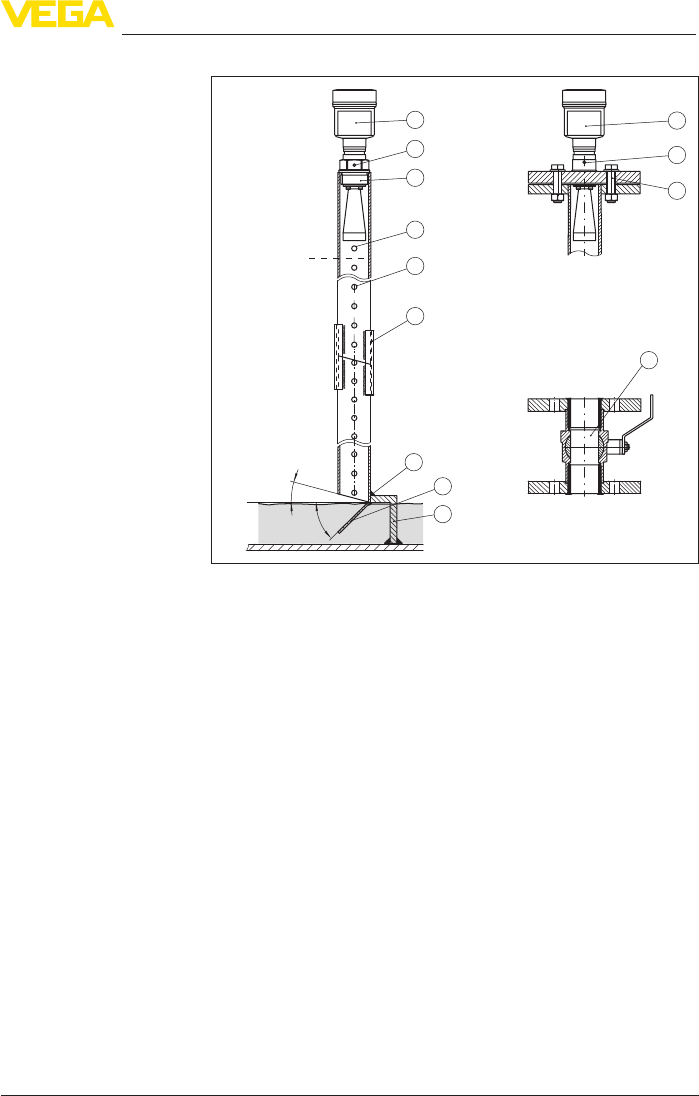
25
4 Mounting
VEGAPULS 62 • 4 … 20 mA/HART - two-wire
36503-EN-161221
100%
1
2
3
4
5
6
7
1
2
3
9
8
9
9
10
15°
45°
0%
Fig.17:CongurationsurgepipeVEGAPULS62
1 Radar sensor
2 Polarisation marking
3 Threadorangeontheinstrument
4 Vent hole
5 Holes
6 WeldingconnectionthroughU-prole
7 Ball valve with complete opening
8 Surge pipe end
9 Reectorsheet
10 Fastening of the surge pipe
Congurationsurgepipe
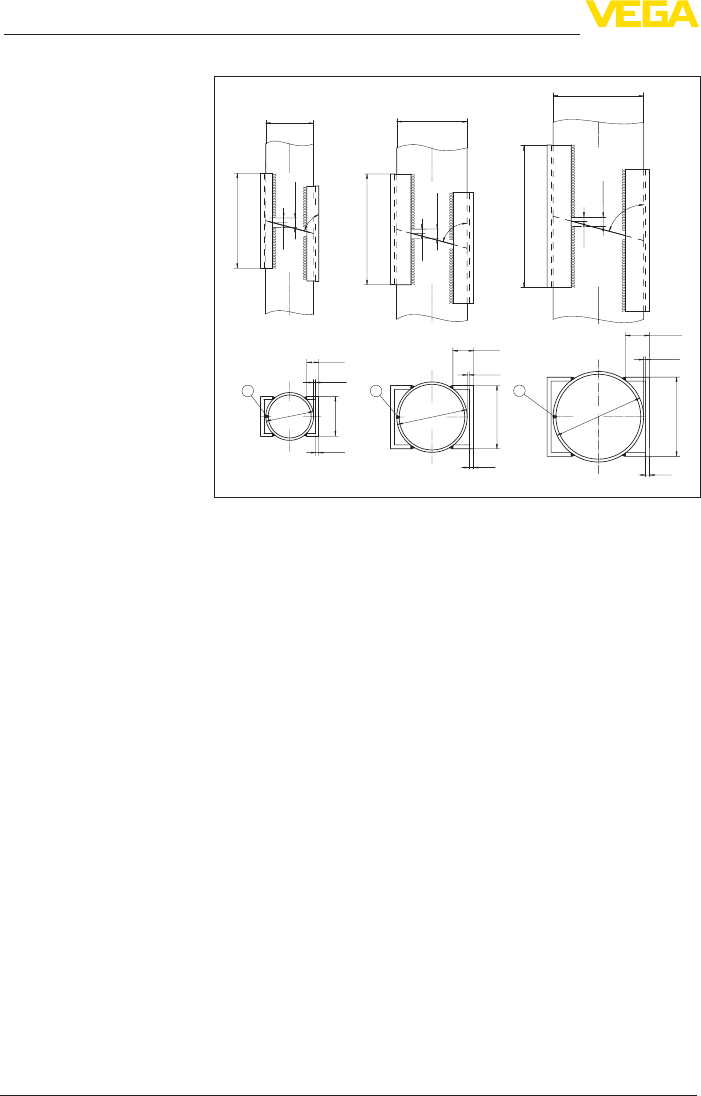
26
4 Mounting
VEGAPULS 62 • 4 … 20 mA/HART - two-wire
36503-EN-161221
5 mm
(0.20")
ø 60,3 mm
(2.37")
ø 88,9 mm
(3.5")
ø 114,3 mm
(4.5")
4 mm
(0.16")
8 mm
(0.32")
d x 2
d x 2
30,5 mm
(1.20")
26 mm
(1.02")
15 mm
(0.59")
2 mm
(0.08")
2 mm
(0.08")
2 mm
(0.08")
5 mm
(0.20")
4 mm
(0.16")
100 mm
(3.94")
80 mm
(3.15")
80 mm
(3.15")
ø 114,3mm
(4.5")
75°
75°
4 mm
(0.16") 8 mm
(0.32")
75°
4 mm
(0.16") 8 mm
(0.32")
d x 2
ø 88,9 mm
(3.5")
ø 60,3 mm
(2.37")
1
11
Fig.18:Weldingconnectionwithsurgepipeextensionfordierentexample
diameters
1 Position of the welded joint with longitudinally welded pipes
Instructions of orientation of the polarisation:
• Note marking of the polarisation on the sensor
• Withthreadedversions,themarkingisonthehexagon,withange
versionsbetweentwoangeholes
• The marking must be in one plane with the holes in the surge pipe
Instructions for the measurement:
• The 100 % point must be below the upper vent hole and the
antenna edge
• The 0 % point is the end of the surge pipe
• During parameter adjustment, select "Application standpipe" and
enter the tube diameter to compensate for errors due to running
time shift
• A false signal suppression with the installed sensor is recom-
mended but not mandatory
• The measurement through a ball valve with unrestricted channel
is possible
Constructive requirements:
• Material metal, smooth inner surface
• Preferably pultruded or straight beaded stainless steel tube
• Welded joint should be straight and lie in one axis with the holes
• Flanges are welded to the tube according to the orientation of the
polarisation
Surge pipe extension
Instructions and require-
ments, surge pipe

27
4 Mounting
VEGAPULS 62 • 4 … 20 mA/HART - two-wire
36503-EN-161221
• Whenusingaballvalves,alignthetransitionsontheinsideandx
accurately
• Gapsizewithjunctions≤0.1mm
• Surge pipes must extend all the way down to the requested min.
level, as measurement is only possible within the tube
• Diameterofholes≤5mm,anynumberOK,ononesideorcom-
pletely through
• The antenna diameter of the sensor should correspond to the
inner diameter of the tube
• Diameter should be constant over the complete length
Instructions for surge pipe extension:
• The ends of the extension tubes must be bevelled and exactly
aligned
• WeldedconnectionviaexternalUprolesaccordingtoillustration
above.LengthoftheUprolesshouldbeatleastdoublethetube
diameter
• Do not weld through the pipe wall. The surge pipe must remain
smooth inside. Roughness and beads on the inside caused by
unintentional penetration should be removed since they cause
strong false echoes and encourage buildup
• Anextensionviaweldingneckangesorpipecollarsisnotrecom-
mended.
An alternative to measurement in a surge pipe is measurement in a
bypass tube outside of the vessel.
Measurement in the
bypass tube
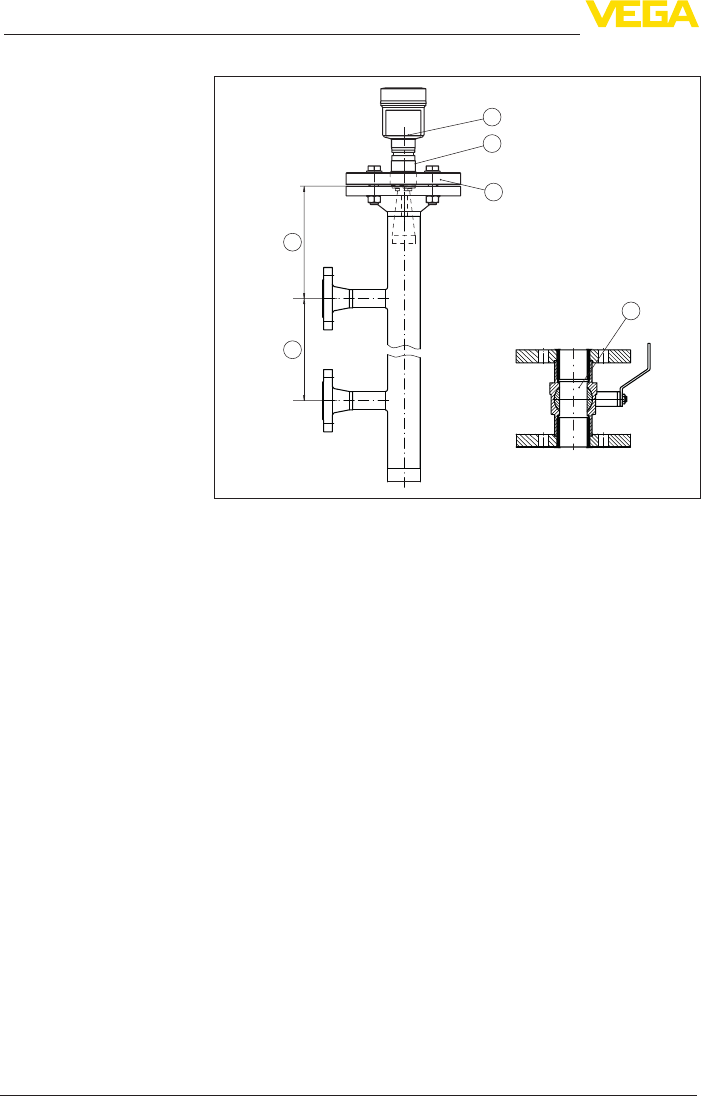
28
4 Mounting
VEGAPULS 62 • 4 … 20 mA/HART - two-wire
36503-EN-161221
0 %
100 %
1
2
5
4
3
6
Fig.19:Congurationbypass
1 Radar sensor
2 Polarisation marking
3 Instrumentange
4 Distance sensor reference plane to upper tube connection
5 Distance of the tube connections
6 Ball valve with complete opening
Instructions of orientation of the polarisation:
• Note marking of the polarisation on the sensor
• Withthreadedversions,themarkingisonthehexagon,withange
versionsbetweentwoangeholes
• The marking must be in one plane with the tube connections to the
vessel
Instructions for the measurement:
• The 100 % point may not be above the upper tube connection to
the vessel
• The 0 % point may not be below the lower tube connection to the
vessel
• Min. distance, sensor reference plane to upper edge of upper tube
connection > 300 mm
• During parameter adjustment, select "Application standpipe" and
enter the tube diameter to compensate for errors due to running
time shift
• A false signal suppression with the installed sensor is recom-
mended but not mandatory
• The measurement through a ball valve with unrestricted channel
is possible
Congurationbypass
Instructions and require-
ments, bypass
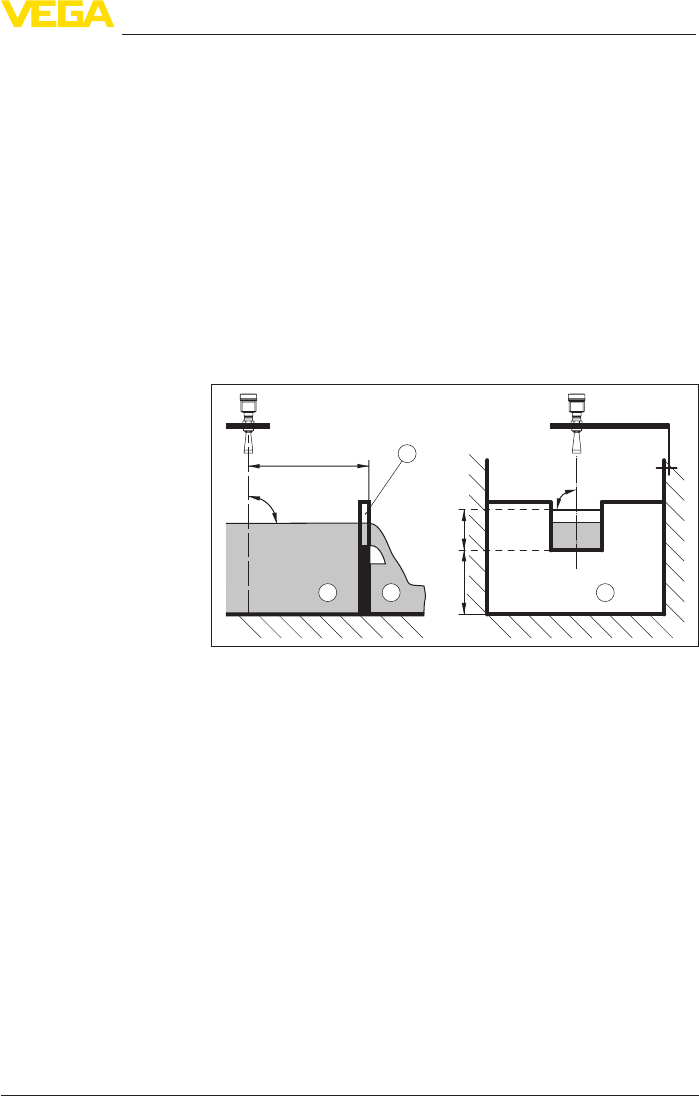
29
4 Mounting
VEGAPULS 62 • 4 … 20 mA/HART - two-wire
36503-EN-161221
Constructional requirements on the bypass pipe:
• Material metal, smooth inner surface
• In case of an extremely rough tube inner surface, use an inserted
tube (tube in tube) or a radar sensor with tube antenna
• Flanges are welded to the tube according to the orientation of the
polarisation
• Gapsizewithjunctions≤0.1mm,forexample,whenusingaball
valveorintermediateangeswithsinglepipesections
• The antenna diameter of the sensor should correspond to the
inner diameter of the tube
• Diameter should be constant over the complete length
4.5 Measurement setup - Flow
Theshortexamplesgiveyouintroductoryinformationonow
measurement.Detailedplanninginformationisavailablefromume
manufacturers and in special literature.
3 ... 4 hmax
90°
23
1
hmax
≥ 2 x hmax
90°
42 3
Fig. 20: Flow measurement with rectangular overfall: dmin. = min. distance of
the sensor (see chapter "Technical data"); hmax.=max.llingoftherectangular
spillway
1 Overoworice(sideview)
2 Headwater
3 Tailwater
4 Overfallorice(viewfromtailwater)
In general, the following points must be observed:
• Install the sensor on the headwater side
• Installationinthecentreoftheumeandverticaltotheliquid
surface
• Distancetotheoverfallorice
• Distanceoforiceopeningaboveground
• Min.distanceoftheoriceopeningtotailwater
• Min. distance of the sensor to max. storage level
Flow measurement with
rectangular overfall
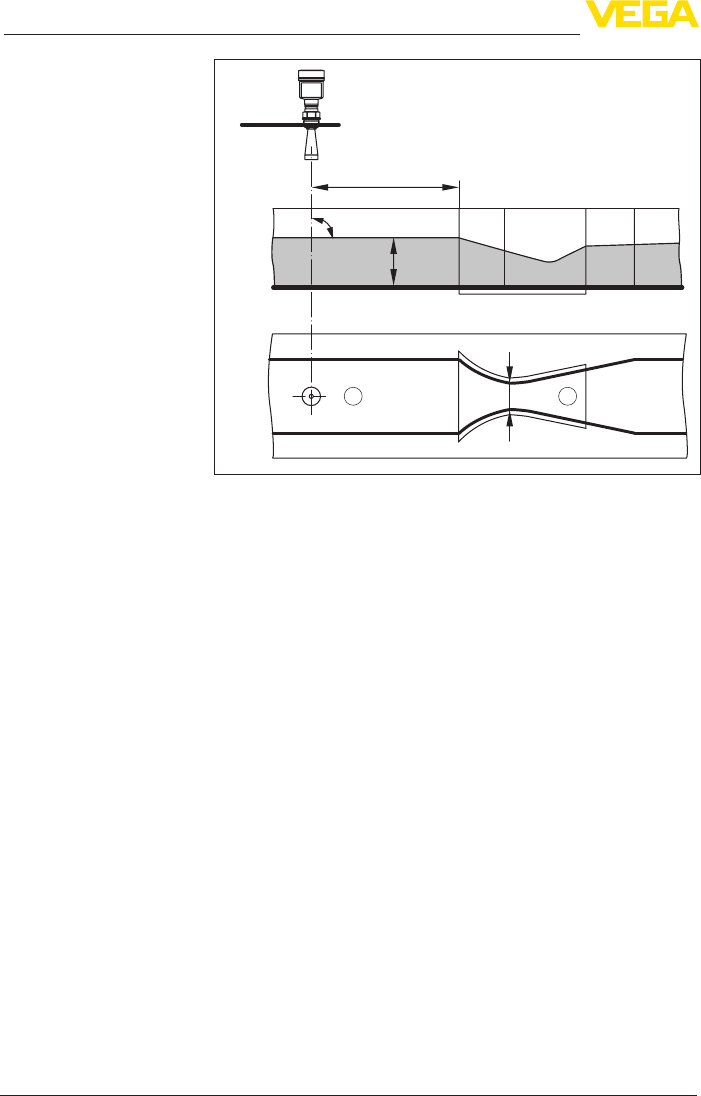
30
4 Mounting
VEGAPULS 62 • 4 … 20 mA/HART - two-wire
36503-EN-161221
2
3 ... 4 x hmax
90°
hmax
B
1
Fig.21:FlowmeasurementwithKhafagi-Venturiume:hmax.=max.llingofthe
ume;B=tightestconstrictionintheume
1 Position sensor
2 Venturiume
In general, the following points must be observed:
• Installation of the sensor at the inlet side
• Installationinthecentreoftheumeandverticaltotheliquid
surface
• DistancetotheVenturiume
• Min. distance of the sensor to max. storage level
Flow measurement with
KhafagiVenturiume

31
5 Connecting to power supply
VEGAPULS 62 • 4 … 20 mA/HART - two-wire
36503-EN-161221
5 Connecting to power supply
5.1 Preparing the connection
Always keep in mind the following safety instructions:
Warning:
Connect only in the complete absence of line voltage.
• The electrical connection must only be carried out by trained
personnel authorised by the plant operator.
• If overvoltage surges are expected, overvoltage arresters should
be installed.
Power supply and current signal are carried on the same two-wire
cable.Theoperatingvoltagecandierdependingontheinstrument
version.
Thedataforpowersupplyarespeciedinchapter"Technical data".
Provide a reliable separation between the supply circuit and the
mains circuits according to DIN EN 61140 VDE 0140-1.
Keepinmindthefollowingadditionalfactorsthatinuencetheoperat-
ing voltage:
• Lower output voltage of the power supply unit under nominal load
(e.g. with a sensor current of 20.5 mA or 22 mA in case of fault)
• Inuenceofadditionalinstrumentsinthecircuit(seeloadvaluesin
chapter "Technical data")
The instrument is connected with standard two-wire cable without
screen. If electromagnetic interference is expected which is above the
test values of EN 61326-1 for industrial areas, screened cable should
be used.
Use cable with round cross section for instruments with housing and
cablegland.Toensurethesealeectofthecablegland(IPprotection
rating),ndoutwhichcableouterdiameterthecableglandissuitable
for.
Useacableglandttingthecablediameter.
We generally recommend the use of screened cable for HART multi-
drop mode.
Metric threads
In the case of instrument housings with metric thread, the cable
glands are screwed in at the factory. They are sealed with plastic
plugs as transport protection.
You have to remove these plugs before electrical connection.
NPT thread
In the case of instrument housings with self-sealing NPT threads, it is
not possible to have the cable entries screwed in at the factory. The
free openings for the cable glands are therefore covered with red dust
protection caps as transport protection.
Safety instructions
Voltage supply
Connection cable
Cable glands
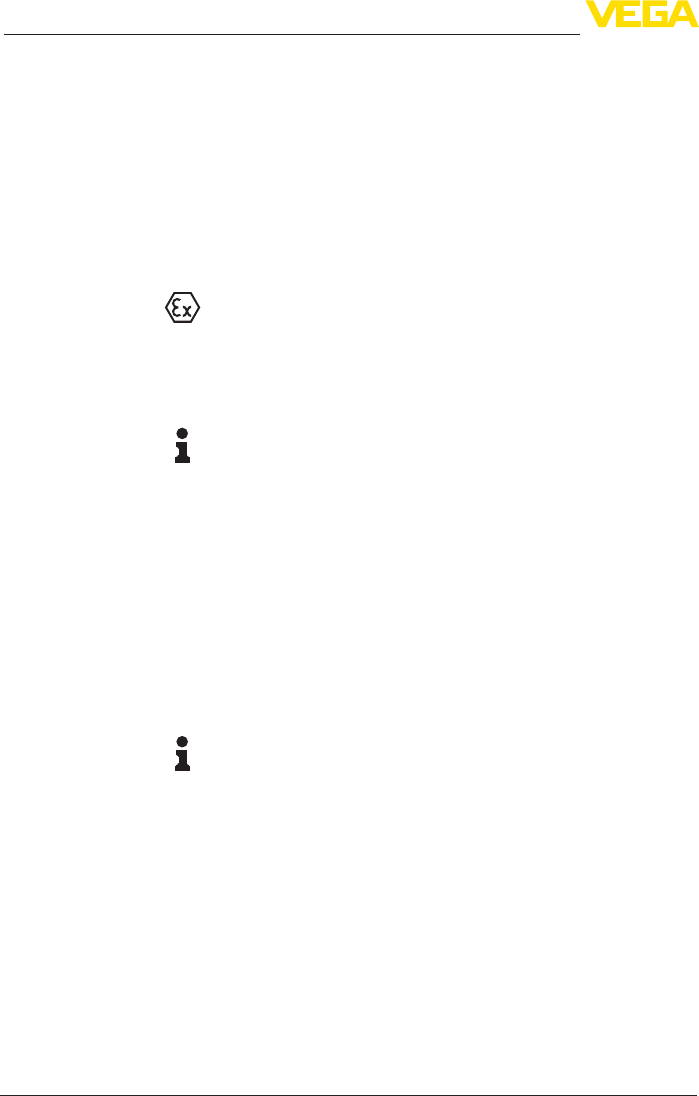
32
5 Connecting to power supply
VEGAPULS 62 • 4 … 20 mA/HART - two-wire
36503-EN-161221
Prior to setup you have to replace these protective caps with ap-
proved cable glands or close the openings with suitable blind plugs.
With plastic housing, the NPT cable gland or the Conduit steel tube
must be screwed without grease into the threaded insert.
Max. torque for all housings, see chapter "Technical data".
If screened cable is required, we recommend connecting the cable
screen on both ends to ground potential. In the sensor, the screen
should be connected directly to the internal ground terminal. The
ground terminal on the outside of the housing must be connected to
the ground potential (with low impedance).
In Ex systems, the grounding is carried out according to the installa-
tion regulations.
In electroplating and CCP systems (cathodic corrosion protection) it
mustbetakenintoaccountthatsignicantpotentialdierencesexist.
This can lead to unacceptably high currents in the cable screen if it is
grounded at both ends.
Information:
Themetallicpartsoftheinstrument(processtting,sensor,concen-
tric tube, etc.) are connected with the internal and external ground
terminal on the housing. This connection exists either directly via
the conductive metallic parts or, in case of instruments with external
electronics, via the screen of the special connection cable.
Youcanndspecicationsonthepotentialconnectionsinsidethe
instrument in chapter "Technical data".
5.2 Connecting
The voltage supply and signal output are connected via the spring-
loaded terminals in the housing.
Connection to the display and adjustment module or to the interface
adapter is carried out via contact pins in the housing.
Information:
The terminal block is pluggable and can be removed from the
electronics. To do this, lift the terminal block with a small screwdriver
and pull it out. When reinserting the terminal block, you should hear it
snap in.
Proceed as follows:
1. Unscrew the housing lid
2. If a display and adjustment module is installed, remove it by turn-
ing it slightly to the left.
3. Loosen compression nut of the cable gland and remove blind
plug
4. Remove approx. 10 cm (4 in) of the cable mantle, strip approx.
1 cm (0.4 in) of insulation from the ends of the individual wires
5. Insert the cable into the sensor through the cable entry
Cable screening and
grounding
Connection technology
Connection procedure
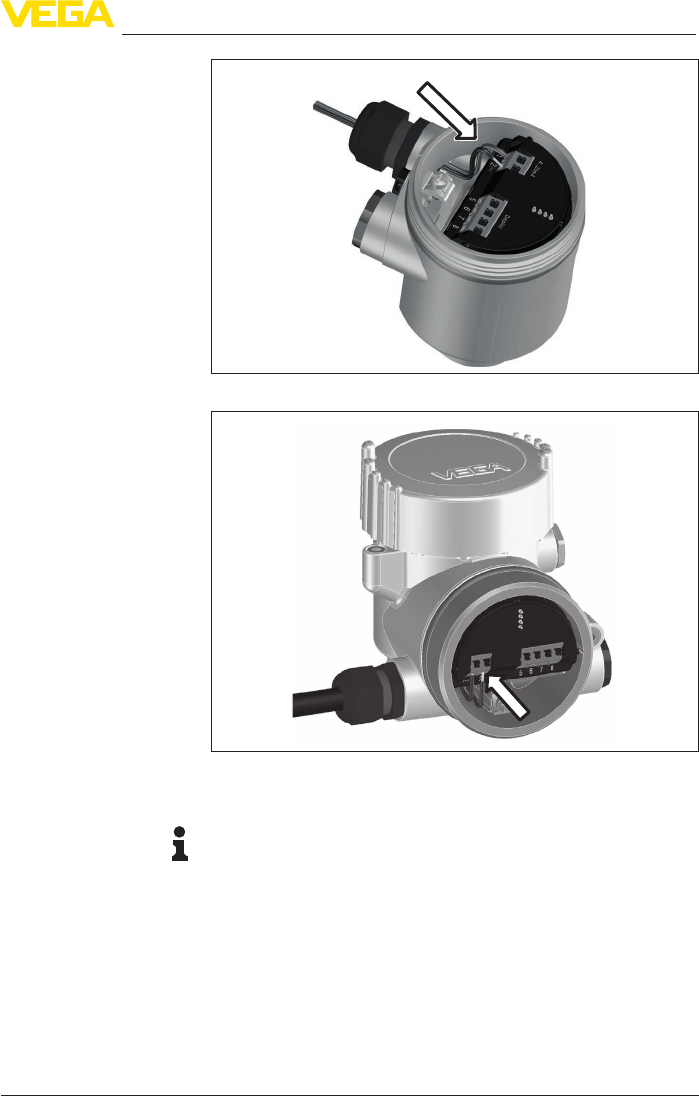
33
5 Connecting to power supply
VEGAPULS 62 • 4 … 20 mA/HART - two-wire
36503-EN-161221
Fig. 22: Connection steps 5 and 6 - Single chamber housing
Fig. 23: Connection steps 5 and 6 - Double chamber housing
6. Insert the wire ends into the terminals according to the wiring plan
Information:
Solidcoresaswellasexiblecoreswithwireendsleevesareinsert-
eddirectlyintotheterminalopenings.Incaseofexiblecoreswithout
end sleeves, press the terminal from above with a small screwdriver,
the terminal opening is then free. When the screwdriver is released,
the terminal closes again.
Youcanndfurtherinformationonthemax.wirecross-sectionunder
"Technical data - Electromechanical data"
7. Check the hold of the wires in the terminals by lightly pulling on
them
8. Connect the screen to the internal ground terminal, connect the
external ground terminal to potential equalisation
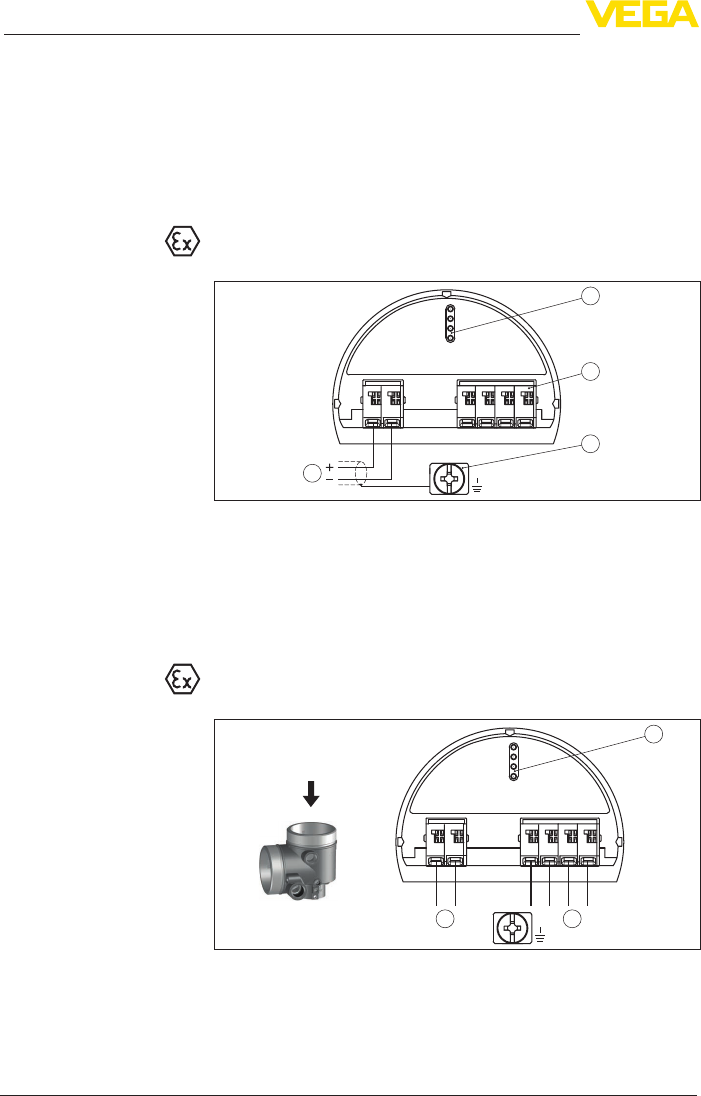
34
5 Connecting to power supply
VEGAPULS 62 • 4 … 20 mA/HART - two-wire
36503-EN-161221
9. Tighten the compression nut of the cable entry gland. The seal
ring must completely encircle the cable
10. Reinsert the display and adjustment module, if one was installed
11. Screw the housing lid back on
Theelectricalconnectionisnished.
5.3 Wiring plan, single chamber housing
The following illustration applies to the non-Ex as well as to the Ex-ia
version.
5
12
+
( ) (-)
678
4...20mA
2
3
4
1
Fig. 24: Electronics and terminal compartment, single chamber housing
1 Voltage supply, signal output
2 For display and adjustment module or interface adapter
3 For external display and adjustment unit
4 Ground terminal for connection of the cable screen
5.4 Wiring plan, double chamber housing
The following illustrations apply to the non-Ex as well as to the Ex-ia
version.
5678
4...20mA
12
+
( ) (-)
2
1 1
Fig. 25: Electronics compartment, double chamber housing
1 Internal connection to the terminal compartment
2 For display and adjustment module or interface adapter
Electronics and terminal
compartment
Electronics compartment
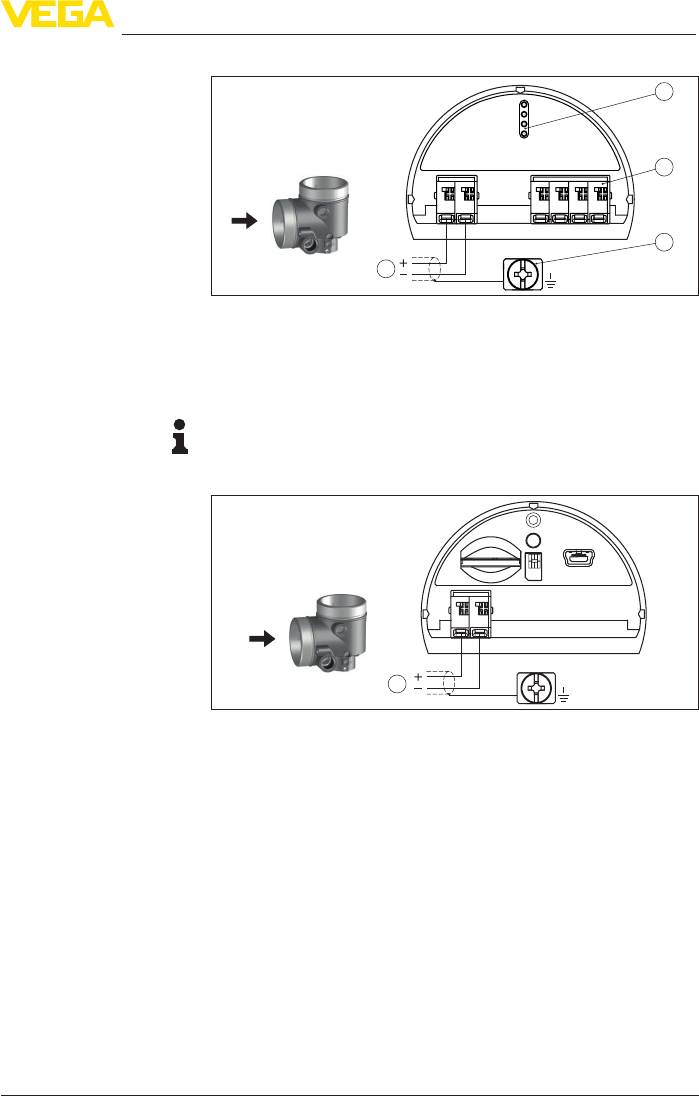
35
5 Connecting to power supply
VEGAPULS 62 • 4 … 20 mA/HART - two-wire
36503-EN-161221
5
12
+
( ) (-)
678
4...20mADisplay
2
3
4
1
Fig. 26: Terminal compartment, double chamber housing
1 Voltage supply, signal output
2 For display and adjustment module or interface adapter
3 For external display and adjustment unit
4 Ground terminal for connection of the cable screen
Information:
Parallel use of an external display and adjustment unit and a display
and adjustment module in the terminal compartment is not supported.
1
USB
Status
Te st
SIM-Card
12
+
( ) (-)
Fig. 27: Terminal compartment, radio module PLICSMOBILE
1 Voltage supply
Youcannddetailedinformationonconnectioninthesupplementary
instructions "PLICSMOBILE GSM/GPRS radio module".
Terminal compartment
Terminal compart-
ment - Radio module
PLICSMOBILE
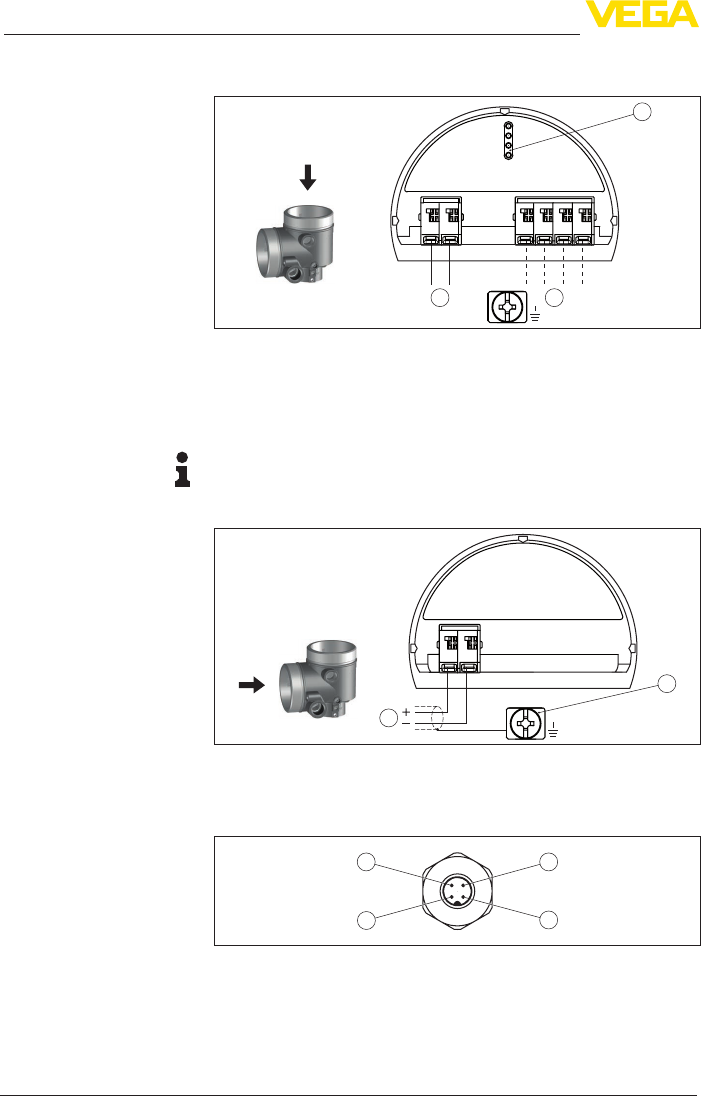
36
5 Connecting to power supply
VEGAPULS 62 • 4 … 20 mA/HART - two-wire
36503-EN-161221
5.5 Wiring plan, double chamber housing Ex d ia
31
2
5678
12
( ) (-)
+
4...20mA
Fig. 28: Electronics compartment, double chamber housing Ex d ia
1 Internal connection to the terminal compartment
2 For display and adjustment module or interface adapter
3 Internal connection to the plug connector for external display and adjust-
ment unit (optional)
Note:
HART multidrop mode is not possible when using an Ex-d-ia instru-
ment.
4...20mA
12
+
( ) (-)
2
1
Fig. 29: Terminal compartment, double chamber housing Ex d ia
1 Voltage supply, signal output
2 Ground terminal for connection of the cable screen
34
12
Fig. 30: Top view of the plug connector
1 Pin 1
2 Pin 2
3 Pin 3
4 Pin 4
Electronics compartment
Terminal compartment
Plug M12 x 1 for external
display and adjustment
unit
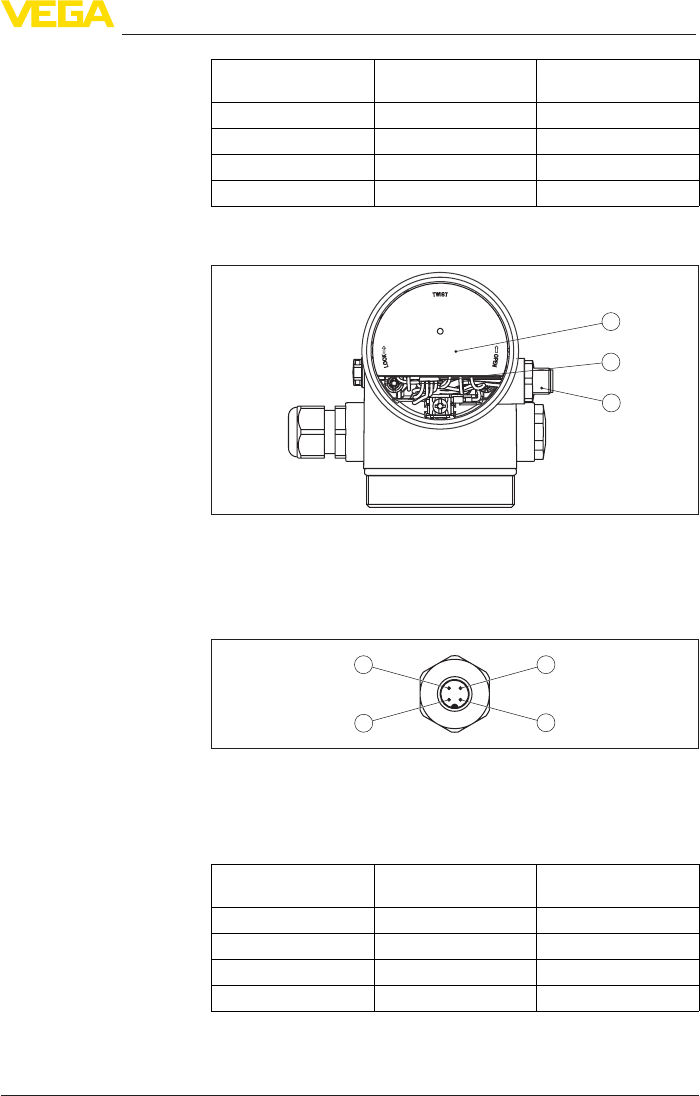
37
5 Connecting to power supply
VEGAPULS 62 • 4 … 20 mA/HART - two-wire
36503-EN-161221
Contact pin Colour connection ca-
ble in the sensor
Terminal, electronics
module
Pin 1 Brown 5
Pin 2 White 6
Pin 3 Blue 7
Pin 4 Black 8
5.6 Double chamber housing with DISADAPT
3
1
2
Fig. 31: View to the electronics compartment with DISADAPT for connection of
the external display and adjustment unit
1 DISADAPT
2 Internal plug connection
3 Plug connector M12 x 1
34
12
Fig. 32: View to the plug connector M12 x 1
1 Pin 1
2 Pin 2
3 Pin 3
4 Pin 4
Contact pin Colour connection ca-
ble in the sensor
Terminal, electronics
module
Pin 1 Brown 5
Pin 2 White 6
Pin 3 Blue 7
Pin 4 Black 8
Electronics compartment
Assignment of the plug
connector
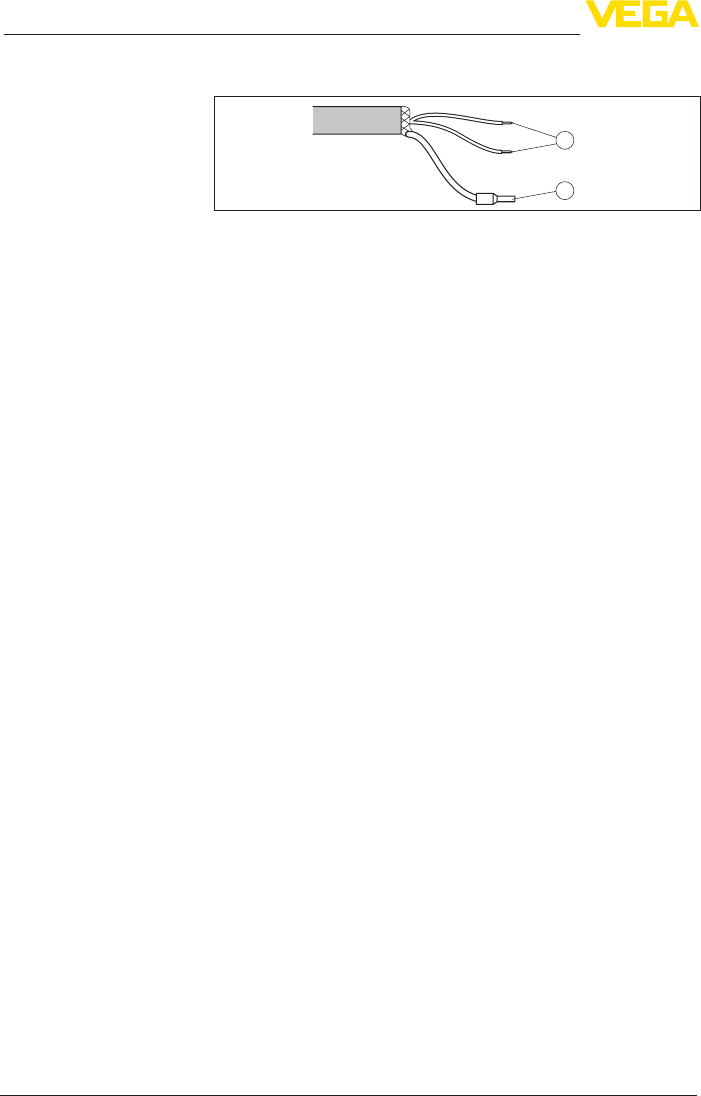
38
5 Connecting to power supply
VEGAPULS 62 • 4 … 20 mA/HART - two-wire
36503-EN-161221
5.7 Wiring plan - version IP 66/IP 68, 1 bar
1
2
Fig. 33: Wire assignment in permanently connected connection cable
1 brown (+) and blue (-) to power supply or to the processing system
2 Shielding
5.8 Switch-on phase
After connecting the instrument to power supply or after a voltage
recurrence, the instrument carries out a self-check for approx. 30 s:
• Internal check of the electronics
• Indication of the instrument type, hardware and software version,
measurement loop name on the display or PC
• Indication of the status message "F 105 Determine measured
value" on the display or PC
• The output signal jumps to the set fault current
As soon as a plausible measured value is found, the corresponding
current is outputted to the signal cable. The value corresponds to the
actual level as well as the settings already carried out, e.g. factory
setting.
Wire assignment, con-
nection cable
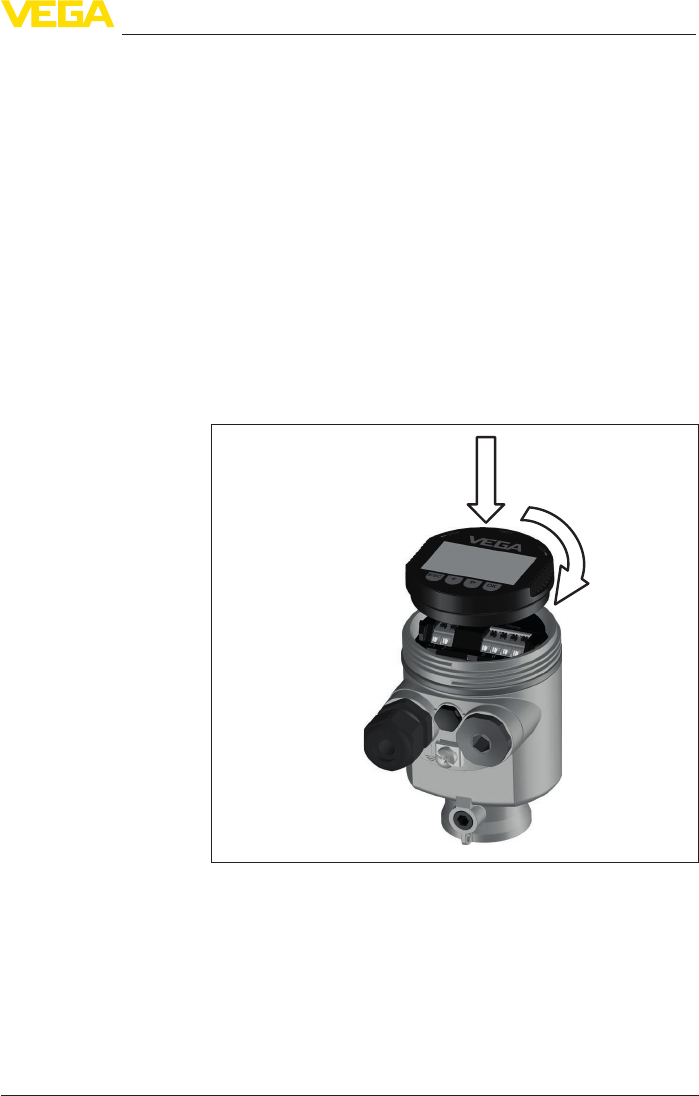
39
6 Set up with the display and adjustment module
VEGAPULS 62 • 4 … 20 mA/HART - two-wire
36503-EN-161221
6 Set up with the display and adjustment
module
6.1 Insert display and adjustment module
The display and adjustment module can be inserted into the sensor
andremovedagainatanytime.Youcanchooseanyoneoffourdier-
ent positions - each displaced by 90°. It is not necessary to interrupt
the power supply.
Proceed as follows:
1. Unscrew the housing lid
2. Place the display and adjustment module on the electronics in the
desired position and turn it to the right until it snaps in.
3. Screw housing lid with inspection window tightly back on
Disassembly is carried out in reverse order.
The display and adjustment module is powered by the sensor, an ad-
ditional connection is not necessary.
Fig. 34: Installing the display and adjustment module in the electronics compart-
ment of the single chamber housing
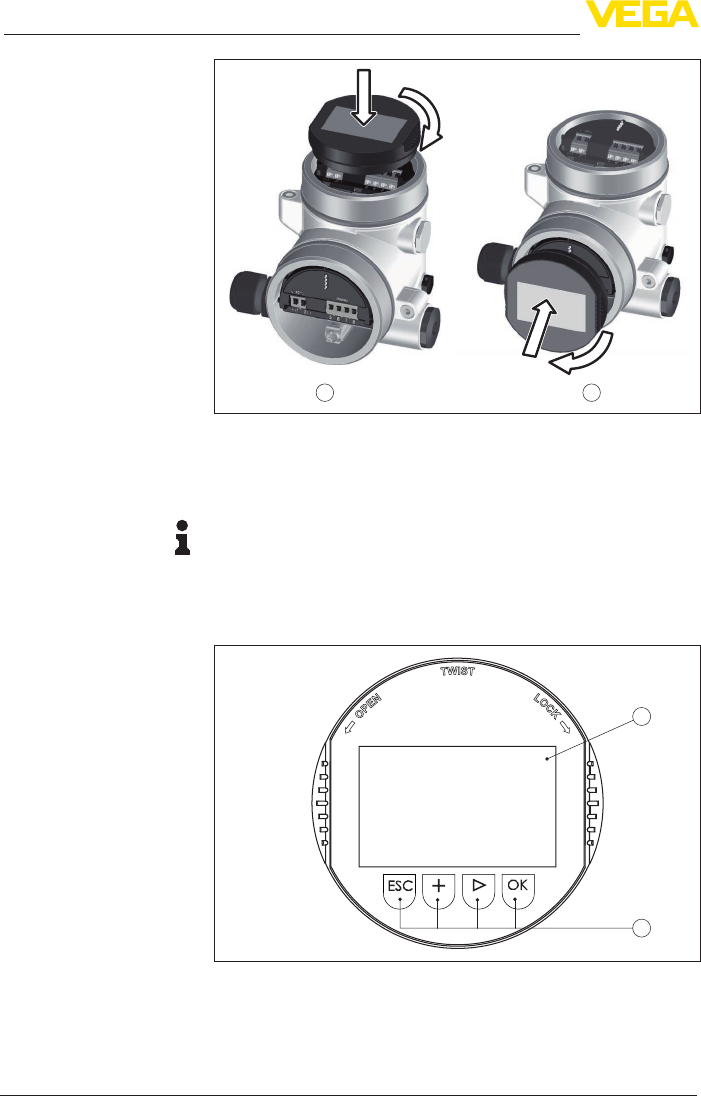
40
6 Set up with the display and adjustment module
VEGAPULS 62 • 4 … 20 mA/HART - two-wire
36503-EN-161221
1 2
Fig. 35: Installing the display and adjustment module in the double chamber
housing
1 In the electronics compartment
2 In the terminal compartment
Note:
Ifyouintendtoretrottheinstrumentwithadisplayandadjustment
module for continuous measured value indication, a higher lid with an
inspection glass is required.
6.2 Adjustment system
1
2
Fig. 36: Display and adjustment elements
1 LC display
2 Adjustment keys
• [OK] key:Key functions
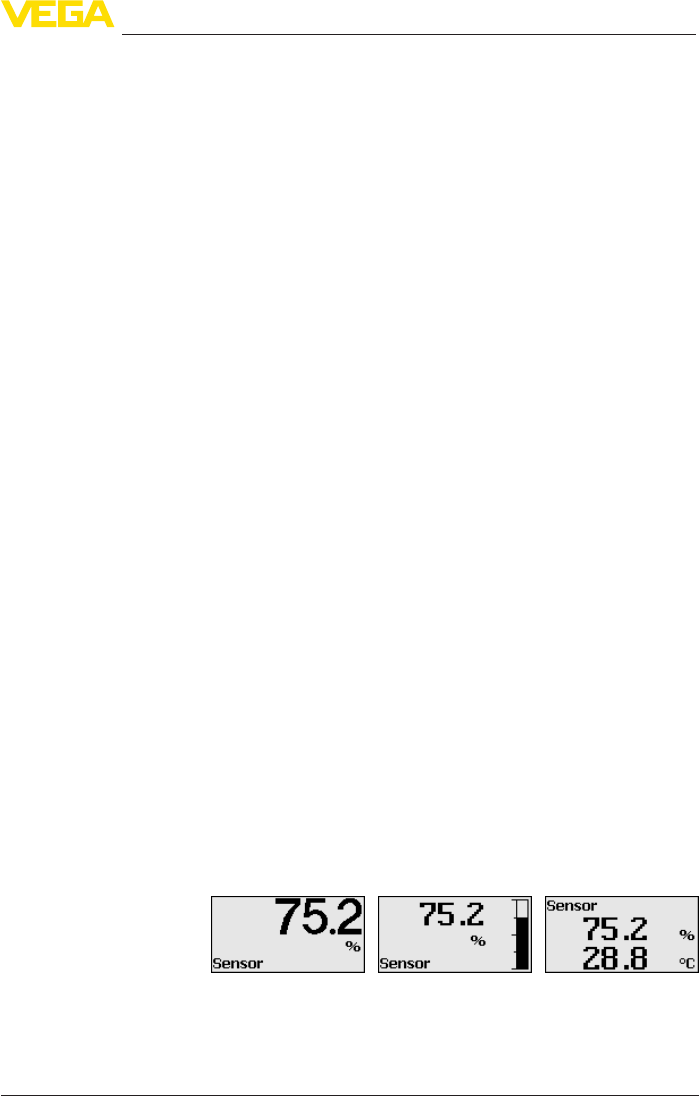
41
6 Set up with the display and adjustment module
VEGAPULS 62 • 4 … 20 mA/HART - two-wire
36503-EN-161221
– Move to the menu overview
– Conrmselectedmenu
– Edit parameter
– Save value
• [->] key:
– Change measured value presentation
– Select list entry
– Select menu items in the quick setup menu
– Select editing position
• [+] key:
– Change value of the parameter
• [ESC] key:
– Interrupt input
– Jump to next higher menu
The instrument is operated via the four keys of the display and adjust-
ment module. The individual menu items are shown on the LC display.
Youcanndthefunctionsoftheindividualkeysintheprevious
illustration.
When the [+] and [->] keys are pressed quickly, the edited value,
or the cursor, changes one value or position at a time. If the key is
pressed longer than 1 s, the value or position changes continuously.
When the [OK] and [ESC] keys are pressed simultaneously for more
than 5 s, the display returns to the main menu. The menu language is
then switched over to "English".
Approx. 60 minutes after the last pressing of a key, an automatic reset
tomeasuredvalueindicationistriggered.Anyvaluesnotconrmed
with [OK] will not be saved.
6.3 Measured value indication - Selection
national language
With the [->]keyyoumovebetweenthreedierentindicationmodes.
Intherstview,theselectedmeasuredvalueisdisplayedinlarge
digits.
In the second view, the selected measured value and a correspond-
ing bar graph presentation are displayed.
In the third view, the selected measured value as well as a second se-
lectable value, e.g. the temperature of the electronics, are displayed.
During the initial setup of an instrument shipped Ex works, use the
"OK" key to get to the menu "National language".
Adjustment system
Time functions
Measured value indica-
tion
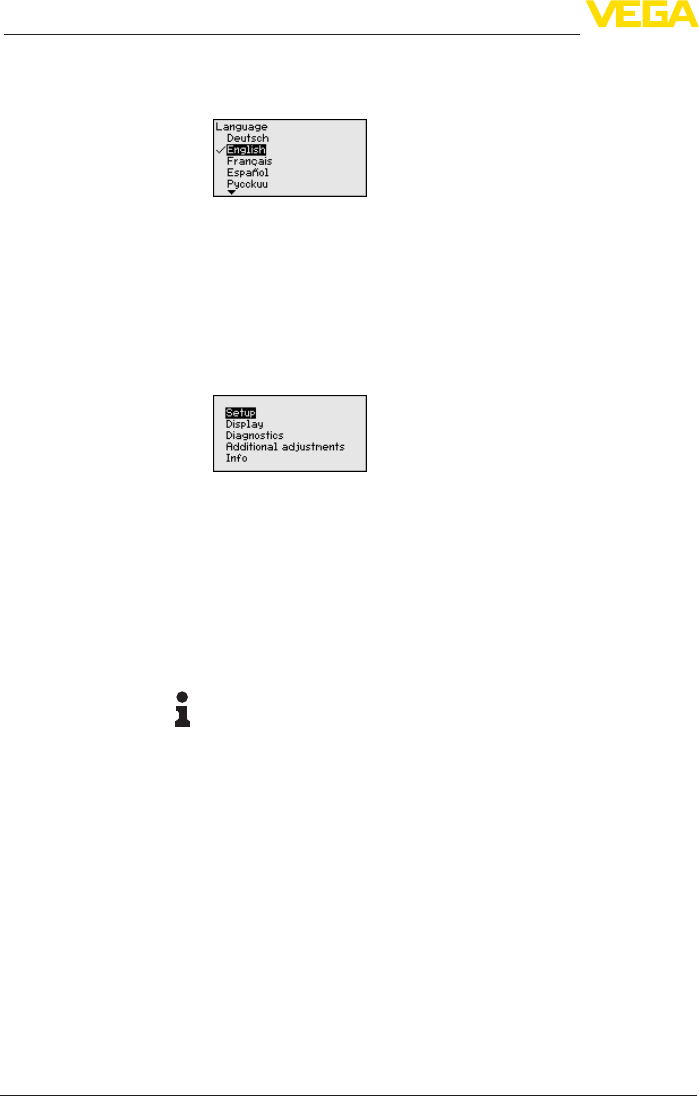
42
6 Set up with the display and adjustment module
VEGAPULS 62 • 4 … 20 mA/HART - two-wire
36503-EN-161221
This menu item is used to select the national language for further pa-
rameter adjustment. You can change the selection via the menu item
"Setup - Display, Menu language".
With the "OK" key you move to the main menu.
6.4 Parameter adjustment
The instrument is adapted to the application conditions via the pa-
rameter adjustment. The parameter adjustment is carried out with an
adjustment menu.
Themainmenuisdividedintovesectionswiththefollowingfunc-
tions:
Setup: Settings, e.g., for measurement loop name, medium, applica-
tion, vessel, adjustment, signal output
Display: Settings, e.g., for language, measured value display, lighting
Diagnosis: Information, e.g. on instrument status, pointer, measure-
ment certainty, simulation, echo curve
Further settings: Instrument unit, false signal suppression, linearisa-
tion curve, reset, date/time, reset, copy function
Info: Instrument name, hardware and software version, date of manu-
facture, instrument features
Information:
Inthisoperatinginstructionsmanual,theinstrument-specicparam-
eters in the menu sections "Setup", "Diagnosis" and "Additional set-
tings" are described. The general parameters in these menu section
are described in the operating instructions manual "Indicating and
adjustment module".
Youcanndintheoperatinginstructionsmanual"Display and adjust-
ment module" also the description of the menu sections "Display" and
"Info".
In the main menu item "Setup", the individual submenu items
should be selected one after the other and provided with the correct
parameters to ensure optimum adjustment of the measurement. The
procedure is described in the following.
In the menu item "Sensor TAG" you edit a twelve digit measurement
loop designation label.
You can enter an unambiguous designation for the sensor, e.g. the
measurement loop name or the tank or product designation. In digital
systems and in the documentation of larger plants, a singular desig-
Selection of national
language
Main menu
Setup - Measurement
loop name
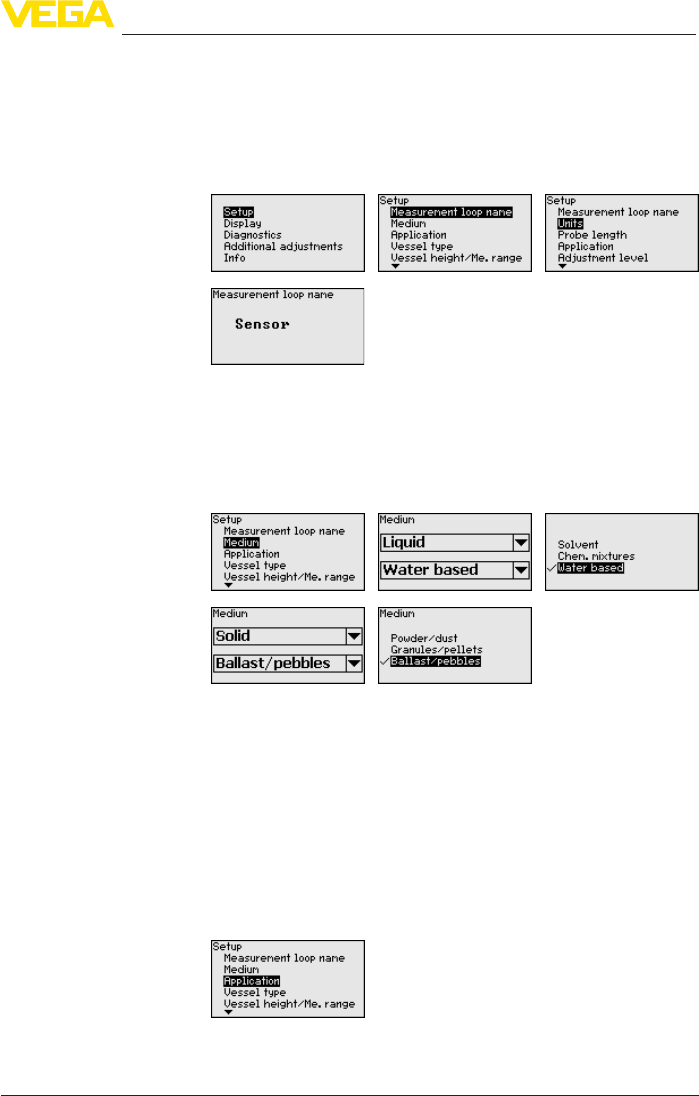
43
6 Set up with the display and adjustment module
VEGAPULS 62 • 4 … 20 mA/HART - two-wire
36503-EN-161221
nationmustbeenteredforexactidenticationofindividualmeasuring
points.
The available digits comprise:
• Letters from A … Z
• Numbers from 0 … 9
• Special characters +, -, /, -
Eachmediumhasdierentreectionproperties.Withliquids,further
interferingfactorsareuctuationproductsurfaceandfoamgenera-
tion. With bulk solids, these are dust generation, material cone and
additional echoes from the vessel wall.
Toadaptthesensortothesedierentmeasuringconditions,the
selection "Liquid" or "Bulk solid" should be made in this menu item.
Through this selection, the sensor is adapted perfectly to the product
andmeasurementreliability,particularlyinproductswithpoorreec-
tive properties, is considerably increased.
Enter the requested parameters via the appropriate keys, save your
settings with [OK] and jump to the next menu item with the [ESC] and
the [->] key.
In addition to the medium, also the application, i.e. the measuring site,
caninuencethemeasurement.
With this menu item, the sensor can be adapted to the applications.
The adjustment possibilities depend on the selection "Liquid" or "Bulk
solid" under "Medium".
The following options are available when "Liquid" is selected:
Setup - Medium
Setup - Application
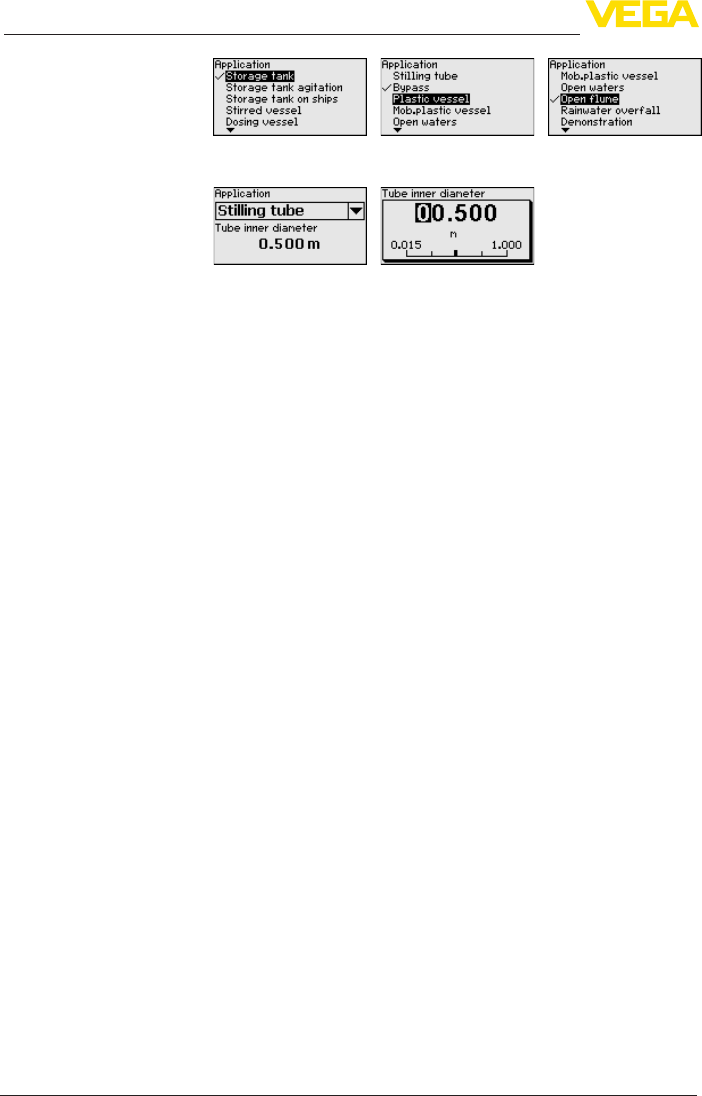
44
6 Set up with the display and adjustment module
VEGAPULS 62 • 4 … 20 mA/HART - two-wire
36503-EN-161221
The selection "Standpipe" opens a new window in which the inner
diameter of the applied standpipe is entered.
The following features form the basis of the applications:
Storage tank:
• Setup: large-volumed, upright cylindrical, spherical
• Productspeed:slowllingandemptying
• Process/measurement conditions:
– Condensation
– Smooth product surface
– High requirements on measurement accuracy
• Properties, sensor:
– Low sensitivity to sporadic false echoes
– Stable and reliable measured values through averaging
– High accuracy
– Short reaction time of the sensor not required
Storage tank with product circulation:
• Setup: large-volumed, upright cylindrical, spherical
• Productspeed:slowllingandemptying
• Installations: small laterally mounted or large top mounted stirrer
• Process/measurement conditions:
– Relatively smooth product surface
– High requirements on measurement accuracy
– Condensation
– Slight foam generation
– Overllingpossible
• Properties, sensor:
– Low sensitivity to sporadic false echoes
– Stable and reliable measured values through averaging
– High accuracy, because not set for max. speed
– False signal suppression recommended
Storage tank on ships (Cargo Tank):
• Productspeed:slowllingandemptying
• Vessel:
– Installations in the bottom section (bracers, heating spirals)
– High sockets 200 … 500 mm, also with large diameters
• Process/measurement conditions:
– Condensation, buildup by movement
– Max. requirement on measurement accuracy from 95 %
• Properties, sensor:
– Low sensitivity to sporadic false echoes
– Stable and reliable measured values through averaging

45
6 Set up with the display and adjustment module
VEGAPULS 62 • 4 … 20 mA/HART - two-wire
36503-EN-161221
– High accuracy
– False signal suppression required
Stirrer vessel (reactor):
• Setup:allvesselsizespossible
• Product speed:
– Fasttoslowllingpossible
– Vesselislledandemptiedveryoften
• Vessel:
– Socket available
– Large agitator blades of metal
– Vortex breakers, heating spirals
• Process/measurement conditions:
– Condensation, buildup by movement
– Strong spout generation
– Very agitated surface, foam generation
• Properties, sensor:
– Higher measurement speed through less averaging
– Sporadic false echoes are suppressed
Dosing vessel:
• Setup:allvesselsizespossible
• Product speed:
– Fastllingandemptying
– Vesselislledandemptiedveryoften
• Vessel: tight installation situation
• Process/measurement conditions:
– Condensation, buildup on the antenna
– Foam generation
• Properties, sensor:
– Measurementspeedoptimizedbyvirtuallynoaveraging
– Sporadic false echoes are suppressed
– False signal suppression recommended
Standpipe:
• Productspeed:veryfastllingandemptying
• Vessel:
– Vent hole
– Joinslikeanges,weldjoints
– Shifting of the running time in the tube
• Process/measurement conditions:
– Condensation
– Buildup
• Properties, sensor:
– Measurementspeedoptimizedthroughlittleaveraging
– Entering the tube inside diameter takes the running time shift
into consideration
– Echo detection sensitivity reduced
Bypass:
• Product speed:
– Fastuptoslowllingwithshortuptolongbypasstubepossible
– Often the level is hold via a control facility

46
6 Set up with the display and adjustment module
VEGAPULS 62 • 4 … 20 mA/HART - two-wire
36503-EN-161221
•Vessel:
– Lateral outlets and inlets
– Joinslikeanges,weldjoints
– Shifting of the running time in the tube
•Process/measurement conditions:
– Condensation
– Buildup
– Separation of oil and water possible
– Overllingintotheantennapossible
•Properties, sensor:
– Measurementspeedoptimizedthroughlittleaveraging
– Entering the tube inside diameter takes the running time shift
into consideration
– Echo detection sensitivity reduced
– False signal suppression recommended
Plastic tank:
Device mounting is limited to directly downward positioning only, and
cannot be operated while moving or in a ANY moving container. Only
the following antennas are approved for use in plastic containers:
75mm illedhornantenna,75mmhornantenna,75mmplastichorn
antenna, 95 mm horn antenna and 245mm parabolic dish antenna.
•Vessel:
– Instrumentxmountedorbuiltin
– Measurement through the vessel top, if appropriate to the
application
– With empty vessel, the measurement can go through the bot-
tom
•Process/measurement conditions:
– Condensation on the plastic ceiling
– In outdoor facilities, water and snow on vessel top possible
•Properties, sensor:
– False signals outside the vessel are not taken into consideration
– False signal suppression recommended
Transportable plastic tank:
Device mounting is limited to directly downward positioning only, and
cannot be operated while moving or in a ANY moving container. Only
the following antennas are approved for use in plastic containers:
75mm illedhornantenna,75mmhornantenna,75mmplastichorn
antenna, 95 mm horn antenna and 245mm parabolic dish antenna.
•Vessel:
– Materialandthicknessdierent
– Measurement through the vessel top
•Process/measurement conditions:
– Measured value jump with vessel change
•Properties, sensor:
– Quickadaptationtochangingreectionconditionsduetoves-
sel change
– False signal suppression required

47
6 Set up with the display and adjustment module
VEGAPULS 62 • 4 … 20 mA/HART - two-wire
36503-EN-161221
Open water (gauge measurement):
• Rate of level change: slow level change
• Process/measurement conditions:
– Large distance from sensor to water surface
– Extreme damping of output signal due to wave generation
– Ice and condensation on the antenna possible
– Spiders and insects build nests in the antennas
– Floating material and animals sporadically appear on water
surface
• Properties, sensor:
– Stable and reliable measured values through frequent averag-
ing
– Insensitive in the close range
Openume(owmeasurement):
• Rate of level change: slow level change
• Process/measurement conditions:
– Ice and condensation on the antenna possible
– Spiders and insects build nests in the antennas
– Smooth water surface
– Exact measurement result required
– Distance to the water surface normally relatively large
• Properties, sensor:
– Stable and reliable measured values through frequent averag-
ing
– Insensitive in the close range
Rain water overfall (weir):
• Rate of level change: slow level change
• Process/measurement conditions:
– Ice and condensation on the antenna possible
– Spiders and insects build nests in the antennas
– Turbulent water surface
– Sensoroodingpossible
• Properties, sensor:
– Stable and reliable measured values through frequent averag-
ing
– Insensitive in the close range
Demonstration:
• Adjustment for all applications which are not typically level meas-
urement
– Instrument demonstration
– Object recognition/monitoring (additional settings required)
• Properties, sensor:
– Sensor accepts all measured value changes within the measur-
ing range immediately
– High sensitivity to interference, because virtually no averaging
Caution:
Ifliquidswithdierentdielectricconstantsseparateinthevessel,for
example through condensation, the radar sensor can detect under
certain circumstances only the medium with the higher dielectric
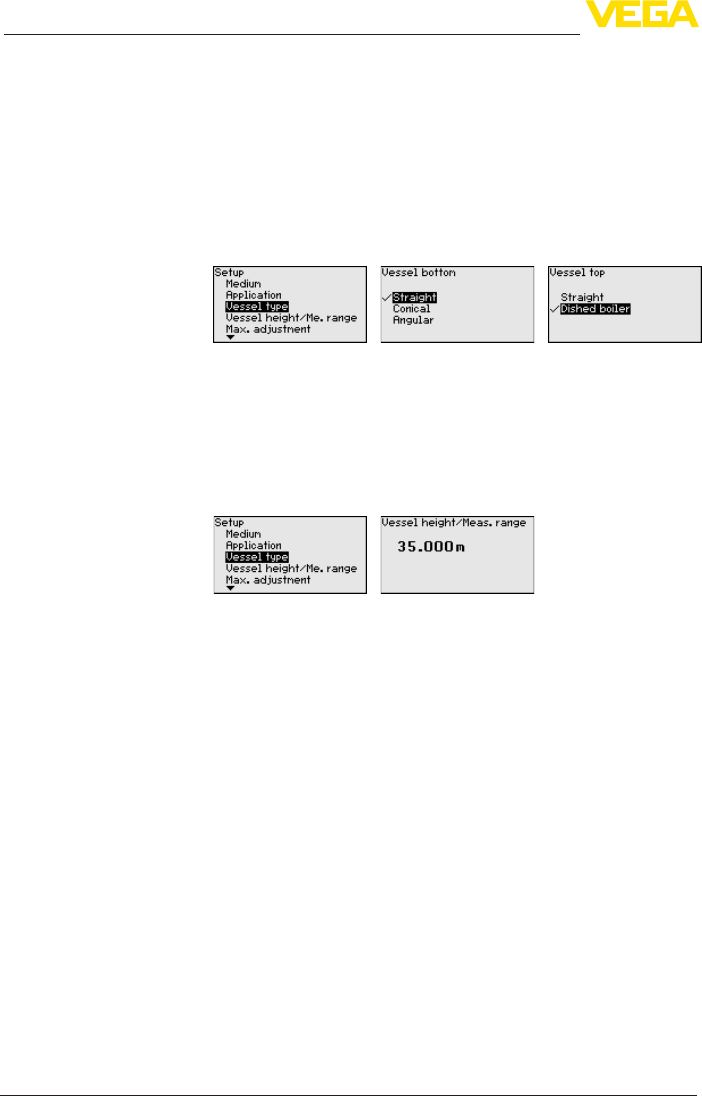
48
6 Set up with the display and adjustment module
VEGAPULS 62 • 4 … 20 mA/HART - two-wire
36503-EN-161221
constant. Keep in mind that layer interfaces can cause faulty meas-
urements.
If you want to measure the total height of both liquids reliably, please
contact our service department or use an instrument specially de-
signed for interface measurement.
Apart from the medium and the application, the vessel form itself can
inuencethemeasurement.Toadaptthesensortothesemeasuring
conditions,thismenuitemoersdierentoptionsforvesselbottom
and ceiling for certain applications.
Enter the requested parameters via the appropriate keys, save your
settings with [OK] and jump to the next menu item with the [ESC] and
the [->] key.
Through this selection the operating range of the sensor is adapted
to the vessel height, which considerably increases measurement
certaintyunderdierentbasicconditions.
The min. adjustment must be carried out independently of this.
Enter the requested parameters via the appropriate keys, save your
settings with [OK] and jump to the next menu item with the [ESC] and
the [->] key.
Since the radar sensor is a distance measuring instrument, the
distance from the sensor to the product surface is measured. To
indicate the actual level, an allocation of the measured distance to the
percentage height must be carried out.
To perform the adjustment, enter the distance with full and empty ves-
sel, see the following example:
Setup - Vessel form
Setup - Vessel height,
measuring range
Setup - Adjustment
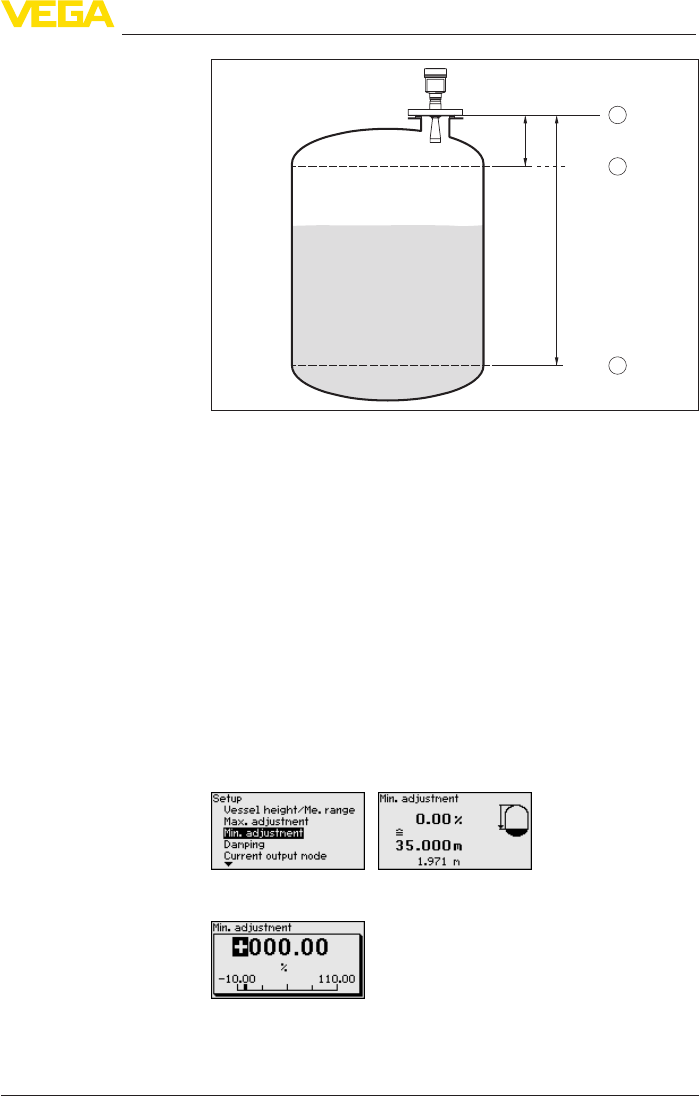
49
6 Set up with the display and adjustment module
VEGAPULS 62 • 4 … 20 mA/HART - two-wire
36503-EN-161221
100%
0%
0,5 m
(19.68
")
5 m
(196.9
")
2
1
3
Fig. 37: Parameter adjustment example min./max. adjustment
1 Min. level = max. measuring distance
2 Max. level = min. measuring distance
3 Reference plane
If these values are not known, an adjustment with the distances of e.g.
10%and90%ispossible.Startingpointforthesedistancespecica-
tionsisalwaysthesealingsurfaceofthethreadorange.Youcannd
specicationsonthereferenceplaneinchapter"Technical data". The
actual level is calculated on the basis of these settings.
The actual product level during this adjustment is not important,
because the min./max. adjustment is always carried out without
changing the product level. These settings can be made ahead of
time without the instrument having to be installed.
Proceed as follows:
1. Select the menu item "Setup" with [->]andconrmwith[OK].
Now select with [->] the menu item "Min. adjustment"andconrm
with [OK].
2. Edit the percentage value with [OK] and set the cursor to the
requested position with [->].
3. Set the requested percentage value with [+] and save with [OK].
The cursor jumps now to the distance value.
Setup - Min. adjustment
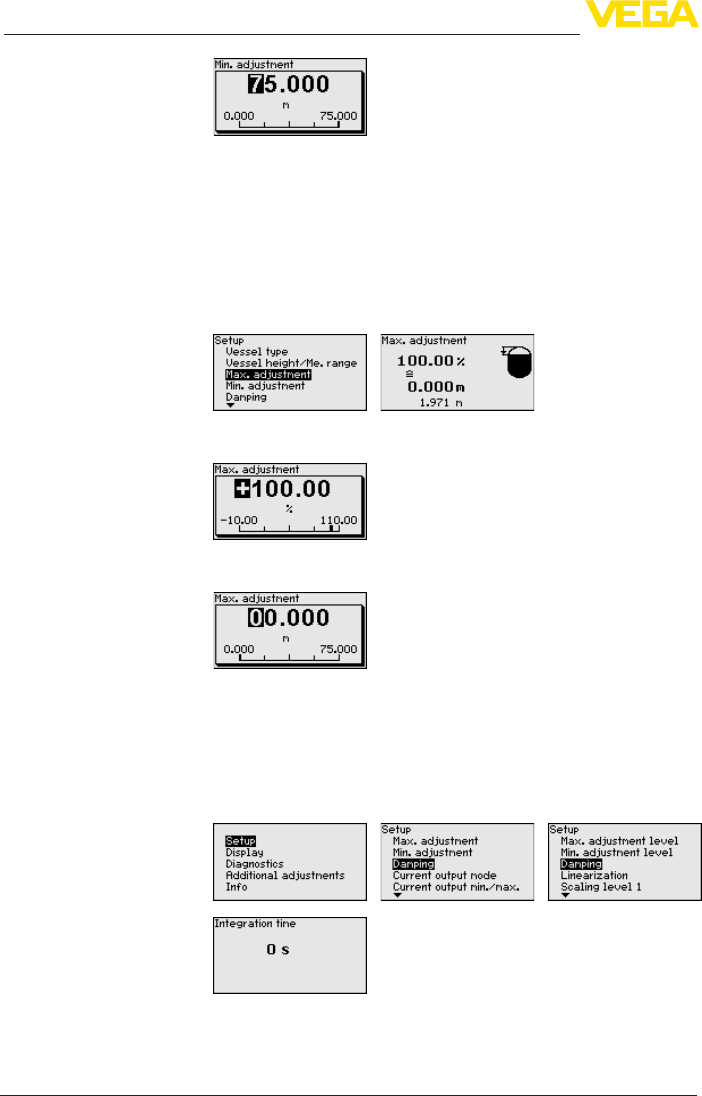
50
6 Set up with the display and adjustment module
VEGAPULS 62 • 4 … 20 mA/HART - two-wire
36503-EN-161221
4. Enter the suitable distance value in m for the empty vessel (e.g.
distance from the sensor to the vessel bottom) corresponding to
the percentage value.
5. Save settings with [OK] and move with [ESC] and [->] to the max.
adjustment.
Proceed as follows:
1. Select with [->]themenuitemMax.adjustmentandconrmwith
[OK].
2. Prepare the percentage value for editing with [OK] and set the
cursor to the requested position with [->].
3. Set the requested percentage value with [+] and save with [OK].
The cursor jumps now to the distance value.
4. Enter the appropriate distance value in m (corresponding to the
percentage value) for the full vessel. Keep in mind that the max.
level must lie below the min. distance to the antenna edge.
5. Save settings with [OK]
Todampprocess-dependentmeasuredvalueuctuations,setan
integration time of 0 … 999 s in this menu item.
Depending on the sensor type, the factory setting is 0 s or 1 s.
Setup - Max. adjustment
Setup - Damping
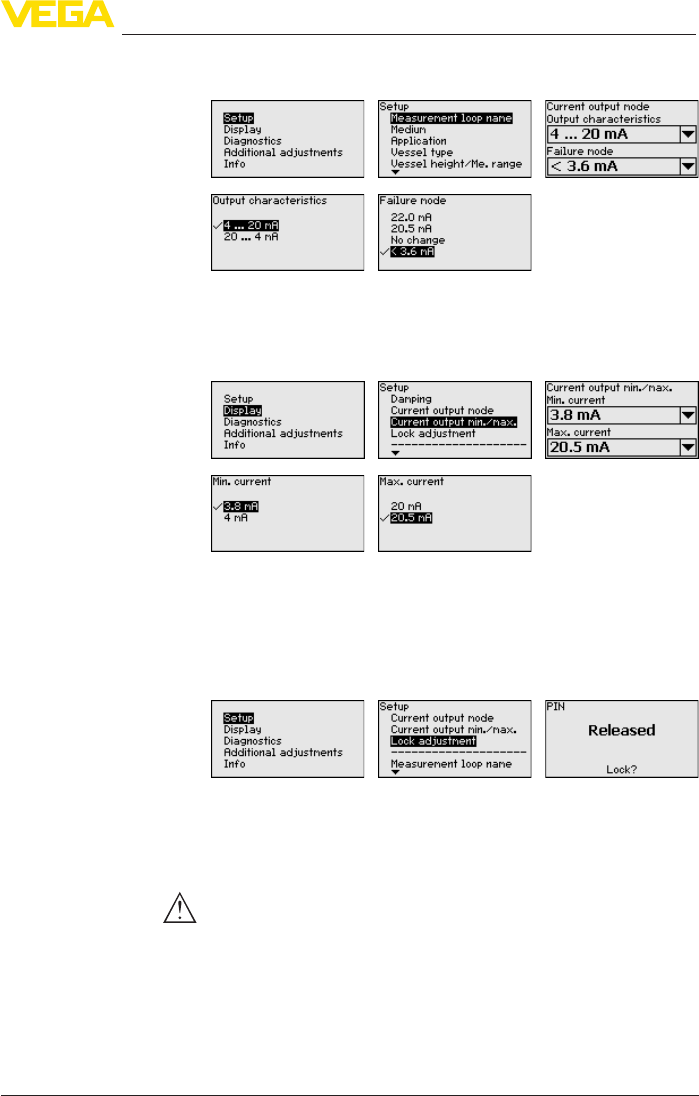
51
6 Set up with the display and adjustment module
VEGAPULS 62 • 4 … 20 mA/HART - two-wire
36503-EN-161221
In the menu item "Current output mode" you determine the output
characteristics and reaction of the current output in case of failure.
The default setting is output characteristics 4 … 20 mA, failure mode
< 3.6 mA.
In the menu item "Current output Min./Max.", you determine the reac-
tion of the current output during operation.
The default setting is min. current 3.8 mA and max. current 20.5 mA.
In this menu item, the PIN is activated/deactivated permanently.
Enteringa4-digitPINprotectsthesensordataagainstunauthorized
accessandunintentionalmodications.IfthePINisactivatedperma-
nently, it can be deactivated temporarily (i.e. for approx. 60 min.) in
any menu item.
Only the following functions are permitted with activated PIN:
• Select menu items and show data
• Read data from the sensor into the display and adjustment mod-
ule.
Caution:
With active PIN, adjustment via PACTware/DTM as well as other
systems is also blocked.
In delivery status, the PIN is "0000".
This menu item enables the setting of the requested national lan-
guage.
Setup - Current output
mode
Setup - Current output
Min./Max.
Lock setup - adjustment
Display - Language
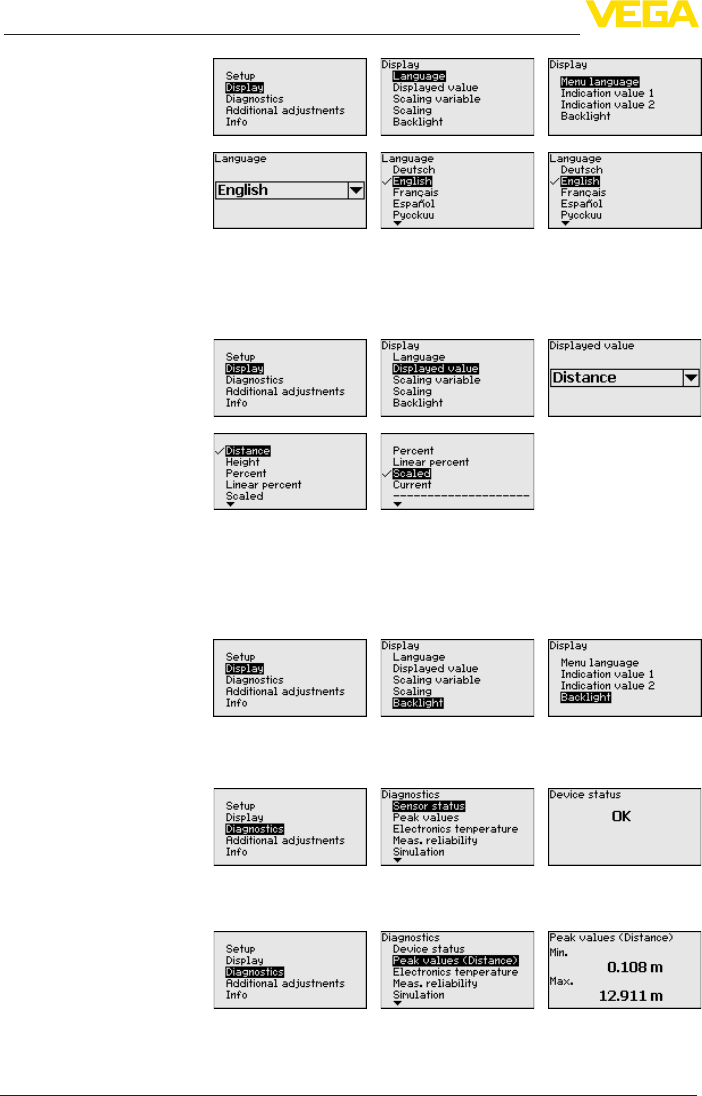
52
6 Set up with the display and adjustment module
VEGAPULS 62 • 4 … 20 mA/HART - two-wire
36503-EN-161221
In the delivery status, the sensor is set to the ordered national lan-
guage.
Inthismenuitemyoucandenetheindicationofthemeasuredvalue
on the display.
The default setting for the indication value is e.g. distance with radar
sensors.
The optionally integrated background lighting can be switched on via
the adjustment menu. This function depends on the level of the supply
voltage, see operating instructions of the respective sensor.
In delivery status, the lighting is switched on.
In this menu item, the device status is displayed.
The respective min. and max. measured value is saved in the sensor.
The values are displayed in the menu item "Peak values".
Display - Displayed value
Display - Backlight
Diagnostics - Device
status
Diagnosis - Peak value
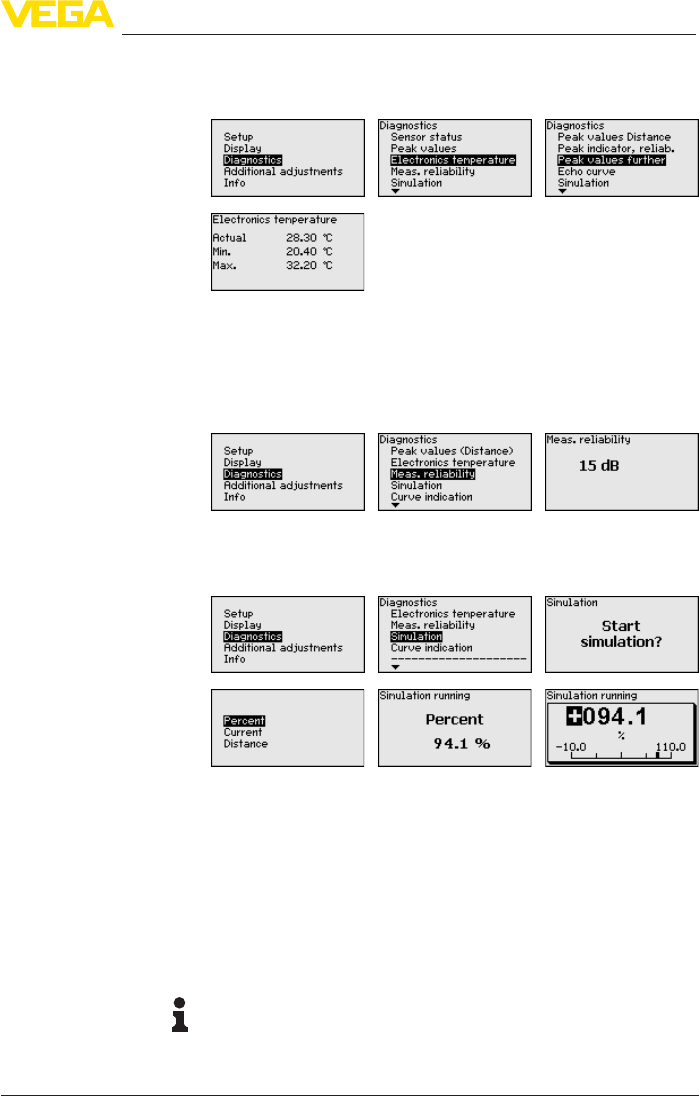
53
6 Set up with the display and adjustment module
VEGAPULS 62 • 4 … 20 mA/HART - two-wire
36503-EN-161221
The respective min. and max. measured value of the electronics
temperature is saved in the sensor. These values as well as the actual
temperature value are displayed in the menu item "Peak values".
When non-contact level sensors are used, the measurement can be
inuencedbytherespectiveprocessconditions.Inthismenuitem,
the measurement reliability of the level echo is displayed as dB value.
The measurement reliability equals signal strength minus noise. The
higher the value, the more reliable the measurement. With a function-
ing measurement, the values are > 10 dB.
In this menu item you can simulate measured values via the current
output. This allows the signal path to be tested, e.g. through down-
stream indicating instruments or the input card of the control system.
How to start the simulation:
1. Push [OK]
2. Select the requested simulation variable with [->]andconrm
with [OK].
3. With [OK]youstartthesimulation,rstofalltheactualmeasured
value is displayed in %
4. Start the editing mode with [OK]
5. Set the requested numerical value with [+] and [->].
6. Push [OK]
Note:
During simulation, the simulated value is outputted as 4 … 20 mA cur-
rent value and digital HART signal.
Diagnosis - Electronics
temperature
Diagnosis - Measurement
reliability
Diagnosis - Simulation
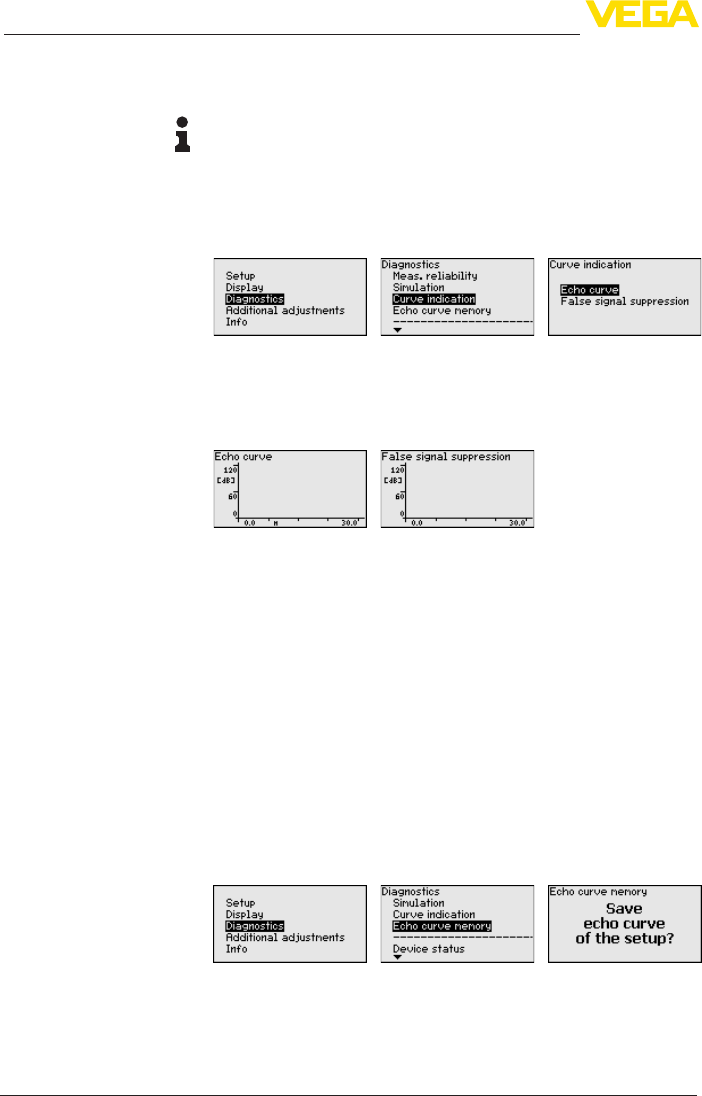
54
6 Set up with the display and adjustment module
VEGAPULS 62 • 4 … 20 mA/HART - two-wire
36503-EN-161221
How to interrupt the simulation:
→ Push [ESC]
Information:
The simulation is automatically terminated 10 minutes after the last
pressing of a key.
The "Echo curve" shows the signal strength of the echoes over the
measuring range in dB. The signal strength enables an evaluation of
the quality of the measurement.
The "False signal suppression" displays the saved false echoes (see
menu "Additional settings") of the empty vessel with signal strength in
"dB" over the measuring range.
A comparison of echo curve and false signal suppression allows a
more detailed statement of the reliability.
Theselectedcurveiscontinuouslyupdated.Asubmenuwithzoom
functions is opened with the [OK] key:
• "X-Zoom":Zoomfunctionforthemeas.distance
• "Y-Zoom":1,2,5and10xsignalmagnicationin"dB"
• "Unzoom":Resetthepresentationtothenominalmeasuringrange
withoutmagnication
The function "Echo curve memory" makes it possible to save the echo
curve at the time of setup. This is generally recommended, and it is
absolutely necessary to do this if you want to use the Asset Manage-
ment functions. If possible, the curve should be saved with a low level
in the vessel.
With the adjustment software PACTware and the PC, the high resolu-
tionechocurvecanbedisplayedandusedtorecognizesignal
changes during operation. In addition, the echo curve of setup can be
displayed in the echo curve window and compared with the current
echo curve.
In this menu item you select the measured variable of the system and
the temperature unit.
Diagnoses - Curve indica-
tion
Diagnostics - Echo curve
memory
Additional adjustments -
Instrument units
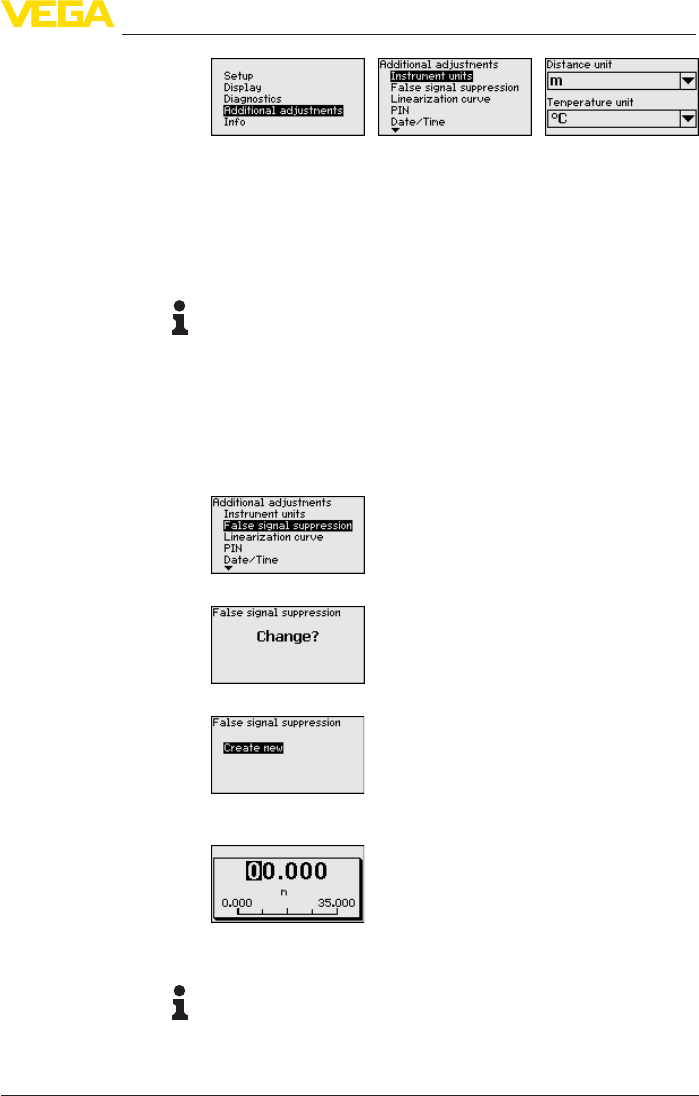
55
6 Set up with the display and adjustment module
VEGAPULS 62 • 4 … 20 mA/HART - two-wire
36503-EN-161221
Thefollowingcircumstancescauseinterferingreectionsandcan
inuencethemeasurement:
• High sockets
• Vessel internals such as struts
• Agitators
• Buildup or welded joints on vessel walls
Note:
A false signal suppression detects, marks and saves these false
signals so that they are no longer taken into account in the level
measurement.
This should be done with a low level so that all potential interfering
reectionscanbedetected.
Proceed as follows:
1. Select with [->] the menu item "False signal suppression" and
conrmwith[OK].
2. Conrmagainwith[OK].
3. Conrmagainwith[OK].
4. Conrmagainwith[OK] and enter the actual distance from the
sensor to the product surface.
5. All interfering signals in this section are detected by the sensor
andstoredafterconrmingwith[OK].
Note:
Check the distance to the product surface, because if an incorrect
(too large) value is entered, the existing level will be saved as a false
signal. The level would then no longer be detectable in this area.
Additional adjustments -
False signal suppression
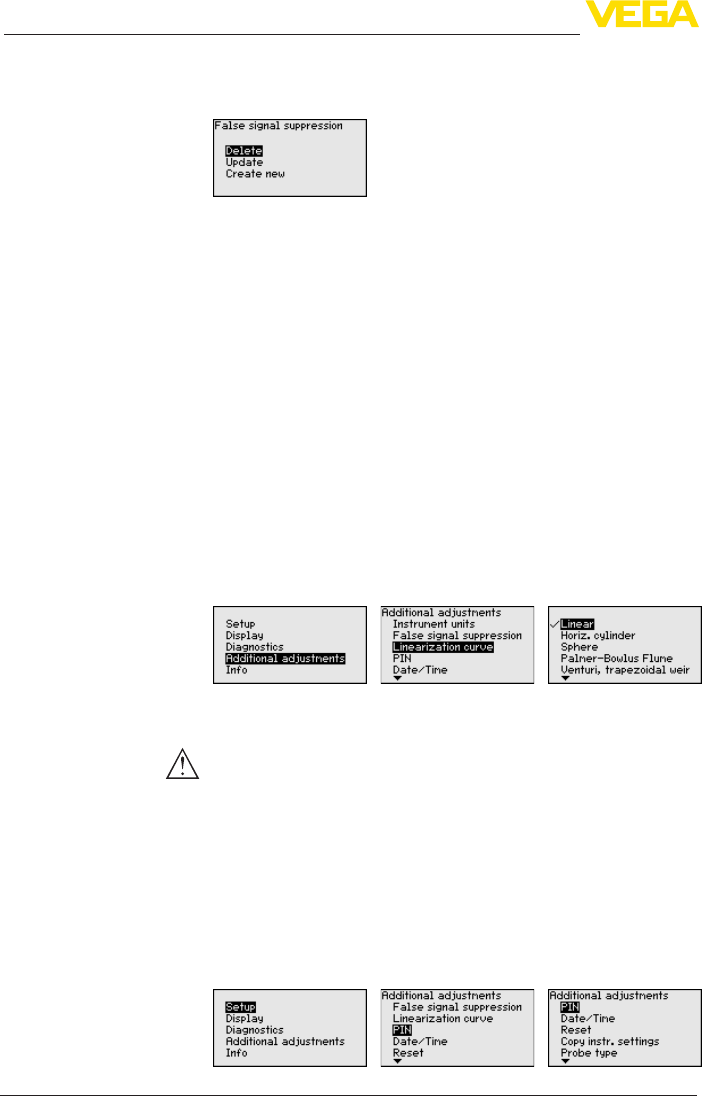
56
6 Set up with the display and adjustment module
VEGAPULS 62 • 4 … 20 mA/HART - two-wire
36503-EN-161221
If a false signal suppression has already been saved in the sensor,
the following menu window appears when selecting "False signal
suppression":
Delete: An already created false signal suppression will be com-
pletely deleted. This is useful if the saved false signal suppression no
longer matches the metrological conditions in the vessel.
Extend: is used to extend an already created false signal suppres-
sion. This is useful if a false signal suppression was carried out with
too high a level and not all false signals could be detected. When
selecting "Extend", the distance to the product surface of the created
false signal suppression is displayed. This value can now be changed
and the false signal suppression can be extended to this range.
Alinearizationisnecessaryforallvesselsinwhichthevesselvolume
doesnotincreaselinearlywiththelevel-e.g.ahorizontalcylindri-
cal or spherical tank - and the indication or output of the volume is
required.Correspondinglinearizationcurvesarepreprogrammed
for these vessels. They represent the correlation between the level
percentage and vessel volume.
By activating the appropriate curve, the volume percentage of the
vessel is displayed correctly. If the volume should not be displayed in
percent but e.g. in l or kg, a scaling can be also set in the menu item
"Display".
Enter the requested parameters via the appropriate keys, save your
settings and jump to the next menu item with the [ESC] and [->] key.
Caution:
Note the following if instruments with appropriate approval are used
aspartofanoverllprotectionsystemaccordingtoWHG:
If a linearisation curve is selected, the measuring signal is no longer
necessarilylineartothellingheight.Thismustbeconsideredbythe
user especially when adjusting the switching point on the limit signal
transmitter.
Enteringa4-digitPINprotectsthesensordataagainstunauthorized
accessandunintentionalmodication.Inthismenuitem,thePINis
displayed or edited and changed. However, this menu item is only
available if adjustment is enabled in the menu "Setup".
Additional adjustments -
Linearization curve
Additional settings - PIN
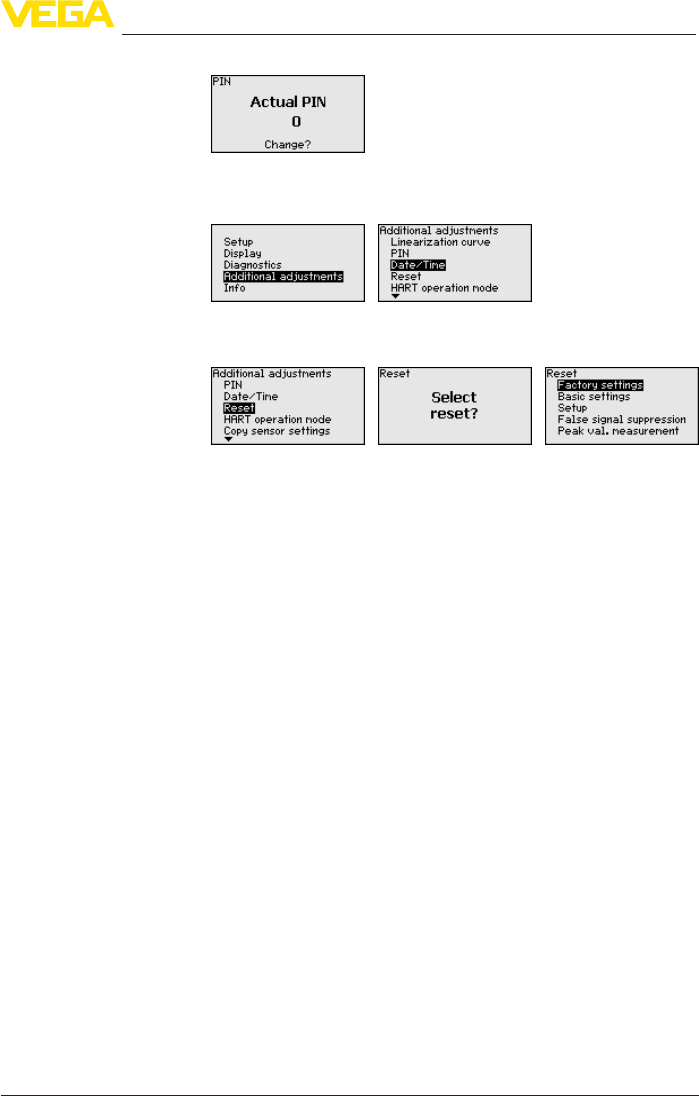
57
6 Set up with the display and adjustment module
VEGAPULS 62 • 4 … 20 mA/HART - two-wire
36503-EN-161221
In delivery status, the PIN is "0000".
In this menu item, the internal clock of the sensor is adjusted.
With a reset, certain parameter adjustments carried out by the user
are reset.
The following reset functions are available:
Delivery status: Restoring the parameter settings at the time of ship-
mentfromthefactoryincl.theorder-specicsettings.Acreatedfalse
signalsuppression,user-programmablelinearizationcurveaswellas
the measured value memory will be deleted.
Basic settings: Resetting of the parameter settings, incl. special
parameters, to the default values of the respective instrument. Any
stored false signal suppression or user programmable linearisation
curve, as well as the measured value memory, is deleted.
Setup: Resetting of the parameter settings to the default values of the
respective instrument in the menu item Setup. User-generated false
signal suppression, user-programmed linearisation curve, measured
value memory as well as event memory remain untouched. The
linearisation is set to linear.
False signal suppression: Deleting a previously created false signal
suppression. The false signal suppression created in the factory
remains active.
Peak values, measured value: Resetting of the measured min. and
max. distances to the actual measured value.
The following table shows the default values of the instrument. De-
pending on the instrument version, not all menu items are available or
somemaybedierentlyassigned:
Additional adjustments -
Date/Time
Additional adjustments
- Reset
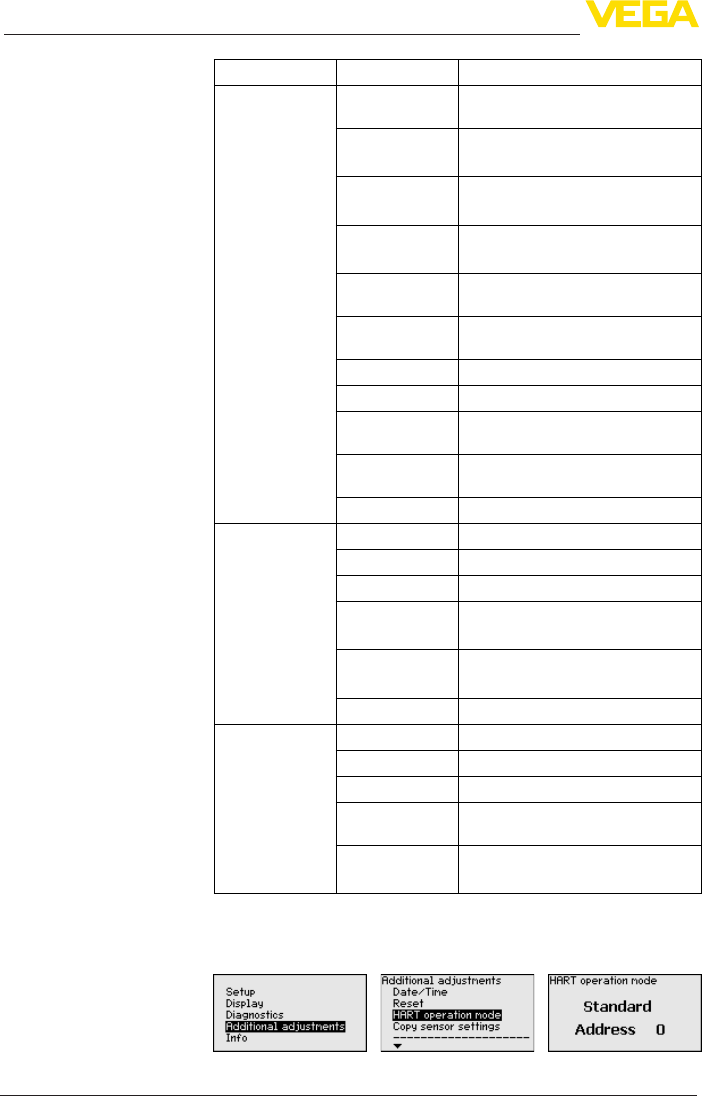
58
6 Set up with the display and adjustment module
VEGAPULS 62 • 4 … 20 mA/HART - two-wire
36503-EN-161221
Menu Menu item Default value
Setup Measurement
loop name
Sensor
Medium Liquid/Water
Bulk solids/Crushed stones, gravel
Application Storage tank
Silo
Vessel form Vessel bottom, dished form
Vessel top, dished form
Vessel height/
Measuring range
Recommended measuring range, see
"Technical data" in the supplement
Min. adjustment Recommended measuring range, see
"Technical data" in the supplement
Max. adjustment 0,000 m(d)
Damping 0.0 s
Current output
mode
4 … 20 mA, < 3.6 mA
Current output
Min./Max.
Min. current 3.8 mA, max. current
20.5 mA
Lock adjustment Released
Display Language Like order
Displayed value Distance
Display unit m
Scalingsize Volume
l
Scaling 0.00 lin %, 0 l
100.00 lin %, 100 l
Backlight Switched on
Additional adjust-
ments
Distance unit m
Temperature unit °C
Probe length Length of the standpipe Ex factory
Linearisation
curve
Linear
HART mode Standard
Address 0
ThesensoroerstheHARTmodesstandardandMultidrop.Inthis
menu item you specify the HART mode and enter the address for
Multidrop.
Additional adjustments -
HART mode
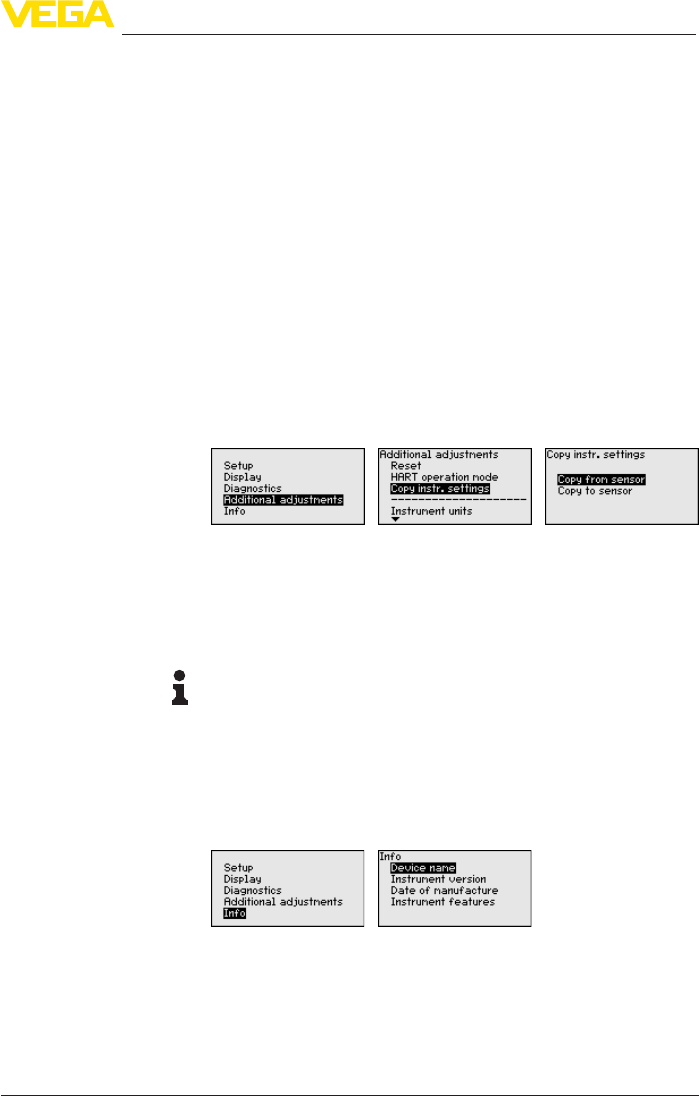
59
6 Set up with the display and adjustment module
VEGAPULS 62 • 4 … 20 mA/HART - two-wire
36503-EN-161221
Themode"standard"withthexedaddress0meansoutputtingthe
measured value as a 4 … 20 mA signal.
In Multidrop mode, up to 63 sensors can be operated on one two-wire
cable. An address between 1 and 63 must be assigned to each sen-
sor.1)
The default setting is standard with address 0.
The instrument settings are copied with this function. The following
functions are available:
• Store data from the sensor into the display and adjustment mod-
ule.
• Store data from the display and adjustment module in the sensor
The following data or settings for adjustment of the display and ad-
justment module are saved:
• All data of the menu "Setup" and "Display"
• In the menu "Additional settings" the items "Distance unit, tem-
perature unit and linearization"
• Thevaluesoftheuserprogrammablelinearizationcurve
The copied data are permanently saved in an EEPROM memory in
the display and adjustment module and remain there even in case of
power failure. From there, they can be written into one or more sen-
sors or kept as backup for a possible sensor exchange.
The type and the volume of the copied data depend on the respective
sensor.
Note:
Before the data are stored in the sensor, a check is carried out to
determineifthedatatthesensor.Ifthedatadonott,afaultsignal
is triggered or the function is blocked. When data are being written
into the sensor, the display shows which instrument type the data
originate from and which TAG-no. this sensor had.
In this menu, you read out the instrument name and the instrument
serial number:
In this menu item, the hardware and software version of the sensor is
displayed.
Additional adjustments -
Copy instrument settings
Info - Instrument name
Info - Instrument version
1) The4…20mAsignaloftheHARTsensorisswitchedo.Thesensor
consumes a constant current of 4 mA. The measuring signal is transmitted
exclusively as digital HART signal.
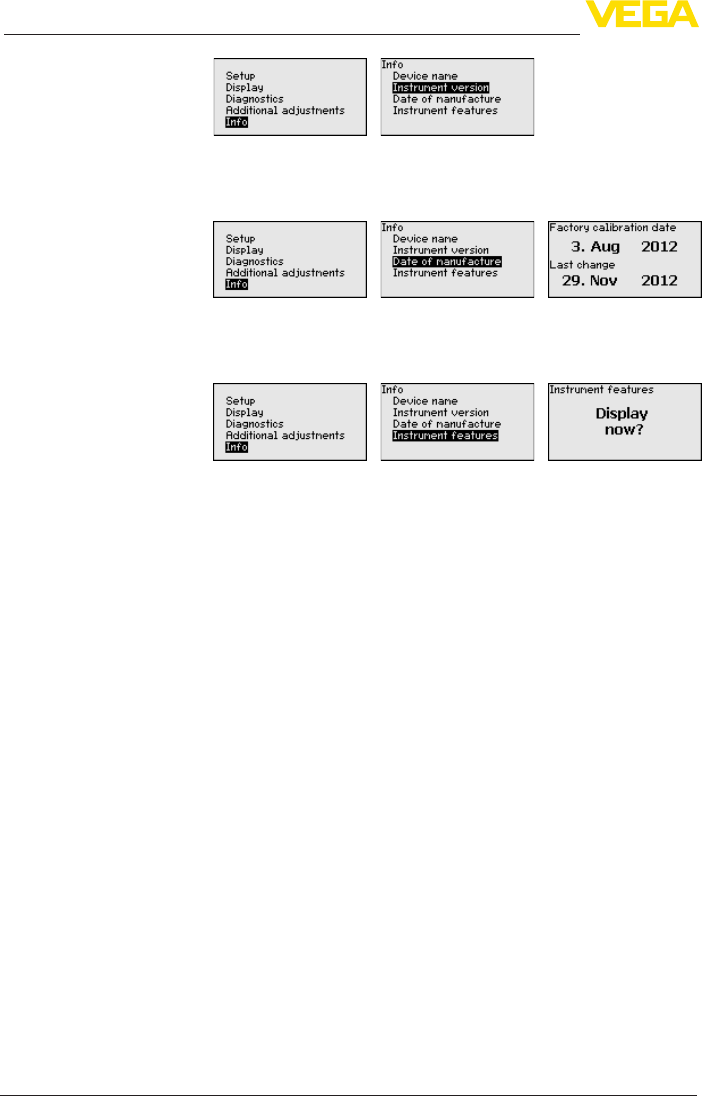
60
6 Set up with the display and adjustment module
VEGAPULS 62 • 4 … 20 mA/HART - two-wire
36503-EN-161221
In this menu item, the date of factory calibration of the sensor as well
as the date of the last change of sensor parameters are displayed via
the display and adjustment module or via the PC.
In this menu item, the features of the sensor such as approval, pro-
cesstting,seal,measuringrange,electronics,housingandothers
are displayed.
6.5 Saving the parameter adjustment data
We recommended noting the adjusted data, e.g. in this operating
instructions manual, and archiving them afterwards. They are thus
available for multiple use or service purposes.
If the instrument is equipped with a display and adjustment module,
the data in the sensor can be saved in the display and adjustment
module. The procedure is described in the menu "Additional adjust-
ments" in the menu item "Copy sensor data". The data remain there
permanently even if the sensor power supply fails.
The following data or settings for adjustment of the display and ad-
justment module are saved:
• All data of the menu "Setup" and "Display"
• In the menu "Additional settings" the items "Sensor-specicunits,
temperature unit and linearization"
• Thevaluesoftheuserprogrammablelinearizationcurve
The function can also be used to transfer settings from one instru-
ment to another instrument of the same type. If it is necessary to
exchange a sensor, the display and adjustment module is inserted
into the replacement instrument and the data are likewise written into
the sensor via the menu item "Copy sensor data".
Info - Date of manufacture
Instrument features
Backup on paper
Backup in the display and
adjustment module
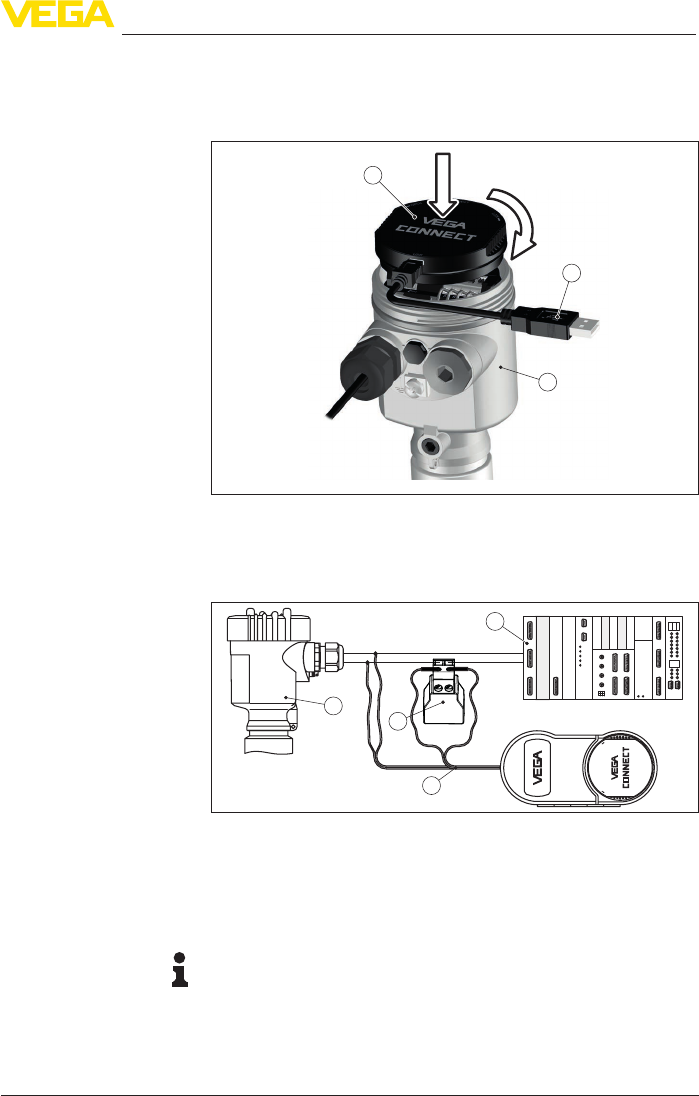
61
7 Setup with PACTware
VEGAPULS 62 • 4 … 20 mA/HART - two-wire
36503-EN-161221
7 Setup with PACTware
7.1 Connect the PC
3
1
2
Fig. 38: Connection of the PC directly to the sensor via the interface adapter
1 USB cable to the PC
2 Interface adapter VEGACONNECT
3 Sensor
12
4
3
OPEN
TWIST
USB
LOCK
Fig. 39: Connecting the PC via HART to the signal cable
1 Sensor
2 HARTresistance250Ω(optionaldependingonevaluation)
3 Connection cable with 2 mm pins and terminals
4 Processing system/PLC/Voltage supply
5 Interface adapter, for example VEGACONNECT 4
Note:
With power supply units with integrated HART resistance (internal
resistanceapprox.250Ω),anadditionalexternalresistanceisnot
necessary. This applies, e.g. to the VEGA instruments VEGATRENN
149A, VEGAMET 381, VEGAMET 391. Common Ex separators are
alsousuallyequippedwithasucientcurrentlimitingresistance.In
Via the interface adapter
directly on the sensor
Via the interface adapter
and HART
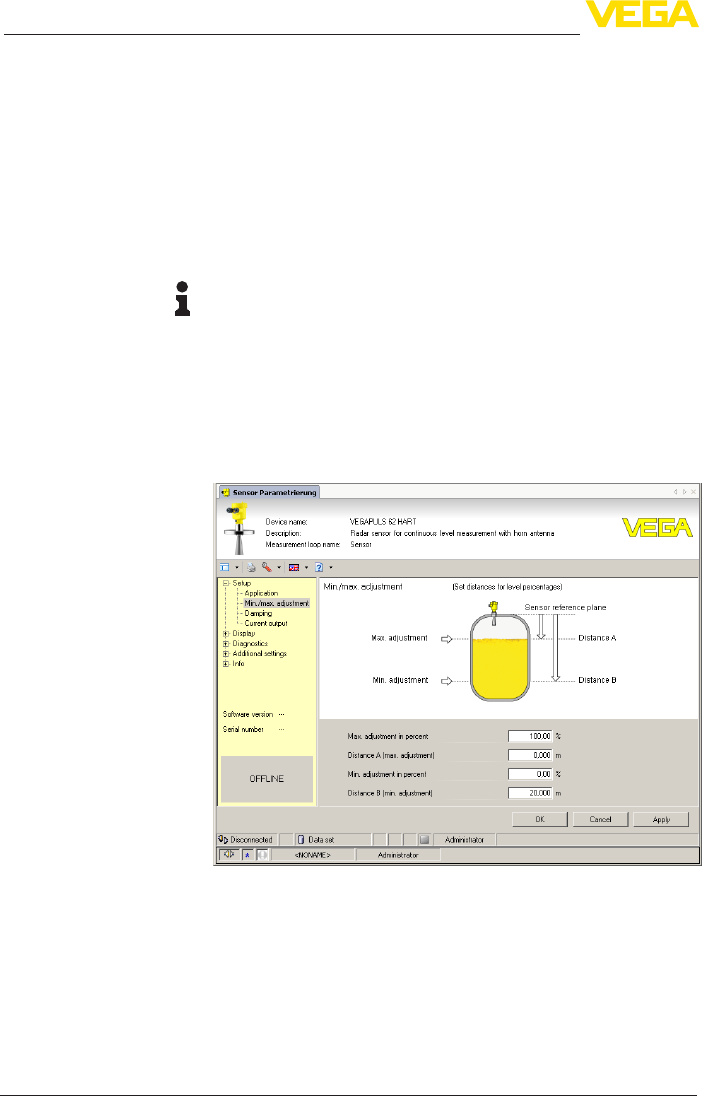
62
7 Setup with PACTware
VEGAPULS 62 • 4 … 20 mA/HART - two-wire
36503-EN-161221
such cases, the interface converter can be connected parallel to the
4 … 20 mA cable (dashed line in the previous illustration).
7.2 Parameter adjustment
For parameter adjustment of the instrument via a Windows PC, the
congurationsoftwarePACTwareandasuitableinstrumentdriver
(DTM) according to FDT standard are required. The latest PACTware
version as well as all available DTMs are compiled in a DTM Collec-
tion. The DTMs can also be integrated into other frame applications
according to FDT standard.
Note:
To ensure that all instrument functions are supported, you should
always use the latest DTM Collection. Furthermore, not all described
functionsareincludedinolderrmwareversions.Youcandownload
the latest instrument software from our homepage. A description of
the update procedure is also available in the Internet.
Further setup steps are described in the operating instructions manu-
al "DTM Collection/PACTware" attached to each DTM Collection and
which can also be downloaded from the Internet. Detailed descrip-
tions are available in the online help of PACTware and the DTMs.
Fig. 40: Example of a DTM view
All device DTMs are available as a free-of-charge standard version
and as a full version that must be purchased. In the standard version,
all functions for complete setup are already included. An assistant for
simpleprojectcongurationsimpliestheadjustmentconsiderably.
Saving/printing the project as well as import/export functions are also
part of the standard version.
In the full version there is also an extended print function for complete
project documentation as well as a save function for measured value
Prerequisites
Standard/Full version

63
7 Setup with PACTware
VEGAPULS 62 • 4 … 20 mA/HART - two-wire
36503-EN-161221
and echo curves. In addition, there is a tank calculation program as
well as a multiviewer for display and analysis of the saved measured
value and echo curves.
The standard version is available as a download under
www.vega.com/downloads and "Software". The full version is avail-
able on CD from the agency serving you.
7.3 Saving the parameter adjustment data
We recommend documenting or saving the parameter adjustment
data via PACTware. That way the data are available for multiple use or
service purposes.

64
8 Set up with other systems
VEGAPULS 62 • 4 … 20 mA/HART - two-wire
36503-EN-161221
8 Set up with other systems
8.1 DD adjustment programs
Device descriptions as Enhanced Device Description (EDD) are
available for DD adjustment programs such as, for example, AMS™
and PDM.
Thelescanbedownloadedatwww.vega.com/downloads under
"Software".
8.2 Field Communicator 375, 475
Device descriptions for the instrument are available as EDD for pa-
rameter adjustment with the Field Communicator 375 or 475.
For the integration of the EDD in the Field Communicator 375 or 475,
the software "Easy Upgrade Utility" is required which is available from
the manufacturer. This software is updated via the Internet and new
EDDs are automatically taken over into the device catalogue of this
software after they are released by the manufacturer. They can then
be transferred to a Field Communicator.

65
9 Diagnosis, asset management and service
VEGAPULS 62 • 4 … 20 mA/HART - two-wire
36503-EN-161221
9 Diagnosis, asset management and service
9.1 Maintenance
If the instrument is used correctly, no maintenance is required in
normal operation.
9.2 Diagnosis memory
The instrument has several memories which are available for
diagnostic purposes. The data remain there even in case of voltage
interruption.
Up to 100,000 measured values can be stored in the sensor in a ring
memory. Each entry contains date/time as well as the respective
measured value. Storable values are for example:
• Distance
• Filling height
• Percentage value
• Lin. percent
• Scaled
• Current value
• Meas. certainty
• Electronics temperature
When the instrument is shipped, the measured value memory is
active and stores distance, measurement certainty and electronics
temperature every 3 minutes.
The requested values and recording conditions are set via a PC with
PACTware/DTM or the control system with EDD. Data are thus read
out and also reset.
Up to 500 events are automatically stored with a time stamp in the
sensor (non-deletable). Each entry contains date/time, event type,
event description and value. Event types are for example:
• Modicationofaparameter
• Switch-onandswitch-otimes
• Status messages (according to NE 107)
• Error messages (according to NE 107)
The data are read out via a PC with PACTware/DTM or the control
system with EDD.
The echo curves are stored with date and time and the corresponding
echo data. The memory is divided into two sections:
Echo curve of the setup: This is used as reference echo curve for
the measurement conditions during setup. Changes in the measure-
ment conditions during operation or buildup on the sensor can thus
berecognized.Theechocurveofthesetupisstoredvia:
• PC with PACTware/DTM
• Control system with EDD
• Display and adjustment module
Measured value memory
Event memory
Echo curve memory
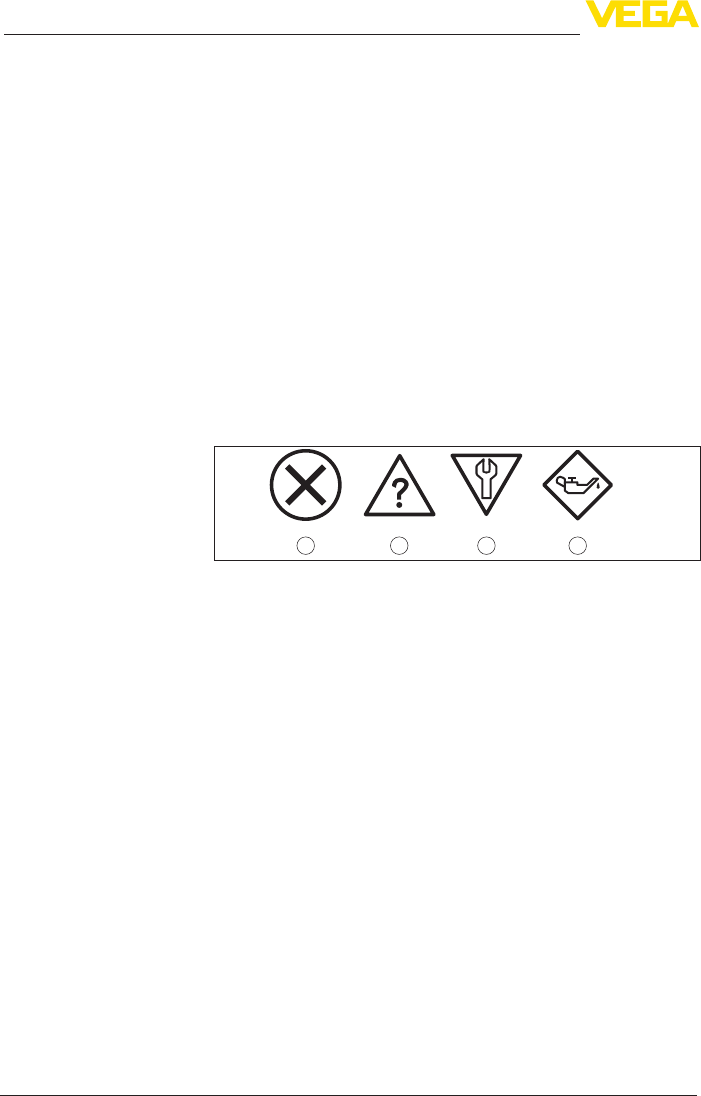
66
9 Diagnosis, asset management and service
VEGAPULS 62 • 4 … 20 mA/HART - two-wire
36503-EN-161221
Further echo curves: Up to 10 echo curves can be stored in a ring
buerinthismemorysection.Furtherechocurvesarestoredvia:
• PC with PACTware/DTM
• Control system with EDD
9.3 Asset Management function
The instrument features self-monitoring and diagnostics according to
NE 107 and VDI/VDE 2650. In addition to the status messages in the
following tables, detailed error messages are available under menu
item "Diagnostics" via the display and adjustment module, PACTware/
DTM and EDD.
The status messages are divided into the following categories:
• Failure
• Function check
• Outofspecication
• Maintenance requirement
and explained by pictographs:
41 2 3
Fig. 41: Pictographs of the status messages
1 Failure - red
2 Outofspecication-yellow
3 Function check - orange
4 Maintenance - blue
Failure: Due to a malfunction in the instrument, a failure message is
outputted.
This status message is always active. It cannot be deactivated by the
user.
Function check: The instrument is in operation, the measured value
is temporarily invalid (for example during simulation).
This status message is inactive by default. It can be activated by the
user via PACTware/DTM or EDD.
Outofspecication: The measured value is unstable because the
instrumentspecicationisexceeded(e.g.electronicstemperature).
This status message is inactive by default. It can be activated by the
user via PACTware/DTM or EDD.
Maintenance:Duetoexternalinuences,theinstrumentfunction
islimited.Themeasurementisaected,butthemeasuredvalueis
still valid. Plan in maintenance for the instrument because a failure is
expected in the near future (e.g. due to buildup).
This status message is inactive by default. It can be activated by the
user via PACTware/DTM or EDD.
Status messages
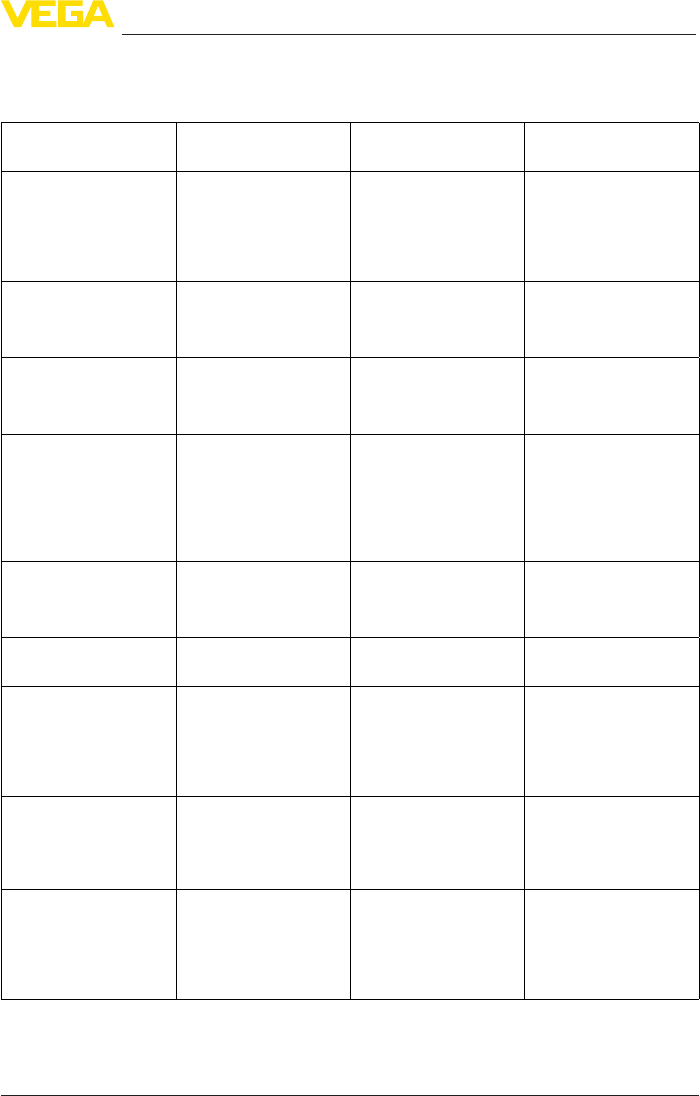
67
9 Diagnosis, asset management and service
VEGAPULS 62 • 4 … 20 mA/HART - two-wire
36503-EN-161221
The following table shows the error codes in the status message
"Failure"andgivesinformationonthereasonandrectication.Keep
in mind that some information is only valid with four-wire instruments.
Code
Text message
Cause Rectication DevSpec State in CMD
48
F013
no measured value avail-
able
•
Sensor does not detect
an echo during operation
•
Antenna system dirty or
defective
•
Check or correct instal-
lation and/or parameter
adjustment
•
Clean or exchange
process component or
antenna
Bit 0 of Byte 0…5
F017
Adjustment span too small
•
Adjustment not within
specication •
Change adjustment
according to the limit val-
ues(dierencebetween
min.andmax.≥10mm)
Bit 1 of Byte 0…5
F025
Errorinthelinearization
table
•
Index markers are not
continuously rising, for
example illogical value
pairs
•
Checklinearizationtable
•
Delete table/Create new
Bit 2 of Byte 0…5
F036
No operable software
•
Failed or interrupted
software update •
Repeat software update
•
Check electronics
version
•
Exchanging the electron-
ics
•
Send instrument for
repair
Bit 3 of Byte 0…5
F040
Error in the electronics
•
Hardware defect •
Exchanging the electron-
ics
•
Send instrument for
repair
Bit 4 of Byte 0…5
F080
General software error
•
General software error •
Disconnect operating
voltagebriey
Bit 5 of Byte 0…5
F105
Determine measured value
•
The instrument is still
in the start phase, the
measured value could
not yet be determined
•
Wait for the end of the
switch-on phase
•
Duration depending on
the version and param-
eter adjustment up to
approximately 3 min.
Bit 6 of Byte 0…5
F113
Communication error
•
EMC interference
•
Transmission error with
the external communica-
tion with 4-wire power
supply unit
•
RemoveEMCinuences
•
Exchange 4-wire power
supply unit or electronics
Bit 12 of Byte 0…5
F125
Impermissible electronics
temperature
•
Temperature of the
electronics in the non-
speciedrange
•
Check ambient tem-
perature
•
Isolate electronics
•
Use instrument with
higher temperature
range
Bit 7 of Byte 0…5
Failure

68
9 Diagnosis, asset management and service
VEGAPULS 62 • 4 … 20 mA/HART - two-wire
36503-EN-161221
Code
Text message
Cause Rectication DevSpec State in CMD
48
F260
Error in the calibration
•
Error in the calibration
carried out in the factory
•
Error in the EEPROM
•
Exchanging the electron-
ics
•
Send instrument for
repair
Bit 8 of Byte 0…5
F261
Error in the instrument set-
tings
•
Error during setup
•
False signal suppression
faulty
•
Error when carrying out
a reset
•
Repeat setup
•
Carry out a reset
Bit 9 of Byte 0…5
F264
Installation/Setup error
•
Adjustment not within the
vessel height/measuring
range
•
Max. measuring range
of the instrument not
sucient
•
Check or correct instal-
lation and/or parameter
adjustment
•
Use an instrument with
bigger measuring range
Bit 10 of Byte 0…5
F265
Measurement function dis-
turbed
•
Sensor no longer carries
out a measurement
•
Operating voltage too
low
•
Check operating voltage
•
Carry out a reset
•
Disconnect operating
voltagebriey
Bit 11 of Byte 0…5
The following table shows the error codes and text messages in the
status message "Function check" and provides information on causes
as well as corrective measures.
Code
Text message
Cause Rectication DevSpec State in CMD
48
C700
Simulation active
•
A simulation is active •
Finish simulation
•
Wait for the automatic
end after 60 mins.
"Simulation Active" in
"StandardizedStatus0"
The following table shows the error codes and text messages in the
status message "Outofspecication" and provides information on
causes as well as corrective measures.
Code
Text message
Cause Rectication DevSpec State in CMD
48
S600
Impermissible electronics
temperature
•
Temperature of the
electronics in the non-
speciedrange
•
Check ambient tem-
perature
•
Isolate electronics
•
Use instrument with
higher temperature
range
Bit 5 of Byte 14…24
S601
Overlling
•
Dangerofvesseloverll-
ing •
Make sure that there is
nofurtherlling
•
Check level in the vessel
Bit 6 of Byte 14…24
The following table shows the error codes and text messages in the
status message "Maintenance" and provides information on causes
as well as corrective measures.
Function check
Outofspecication
Maintenance

69
9 Diagnosis, asset management and service
VEGAPULS 62 • 4 … 20 mA/HART - two-wire
36503-EN-161221
Code
Text message
Cause Rectication DevSpec State in CMD
48
M500
Error with the reset deliv-
ery status
•
With the reset to delivery
status, the data could not
be restored
•
Repeat reset
•
LoadXMLlewithsen-
sor data into the sensor
Bit 0 of Byte 14…24
M501
Error in the non-active lin-
earizationtable
•
Hardware error
EEPROM •
Exchanging the electron-
ics
•
Send instrument for
repair
Bit 1 of Byte 14…24
M502
Error in the diagnosis
memory
•
Hardware error
EEPROM •
Exchanging the electron-
ics
•
Send instrument for
repair
Bit 2 of Byte 14…24
M503
Meas. reliability too low
•
The echo/noise ratio
is too small for reliable
measurement
•
Check installation and
process conditions
•
Clean the antenna
•
Change polarisation
direction
•
Use instrument with
higher sensitivity
Bit 3 of Byte 14…24
M504
Error on an device inter-
face
•
Hardware defect •
Check connections
•
Exchanging the electron-
ics
•
Send instrument for
repair
Bit 4 of Byte 14…24
M505
No echo available
•
Level echo can no longer
be detected •
Clean the antenna
•
Use a more suitable
antenna/sensor
•
Remove possible false
echoes
•
Optimizesensorposition
and orientation
Bit 7 of Byte 14…24
9.4 Rectify faults
The operator of the system is responsible for taking suitable meas-
ures to rectify faults.
Therstmeasuresare:
• Evaluation of fault messages, for example via the display and
adjustment module
• Checking the output signal
• Treatment of measurement errors
Further comprehensive diagnostics options are available with a PC
with PACTware and the suitable DTM. In many cases, the reasons can
bedeterminedinthiswayandfaultsrectied.
Connect a multimeter in the suitable measuring range according to
the wiring plan. The following table describes possible errors in the
current signal and helps to eliminate them:
Reaction when malfunc-
tion occurs
Procedure for fault recti-
cation
Check the 4 … 20 mA
signal
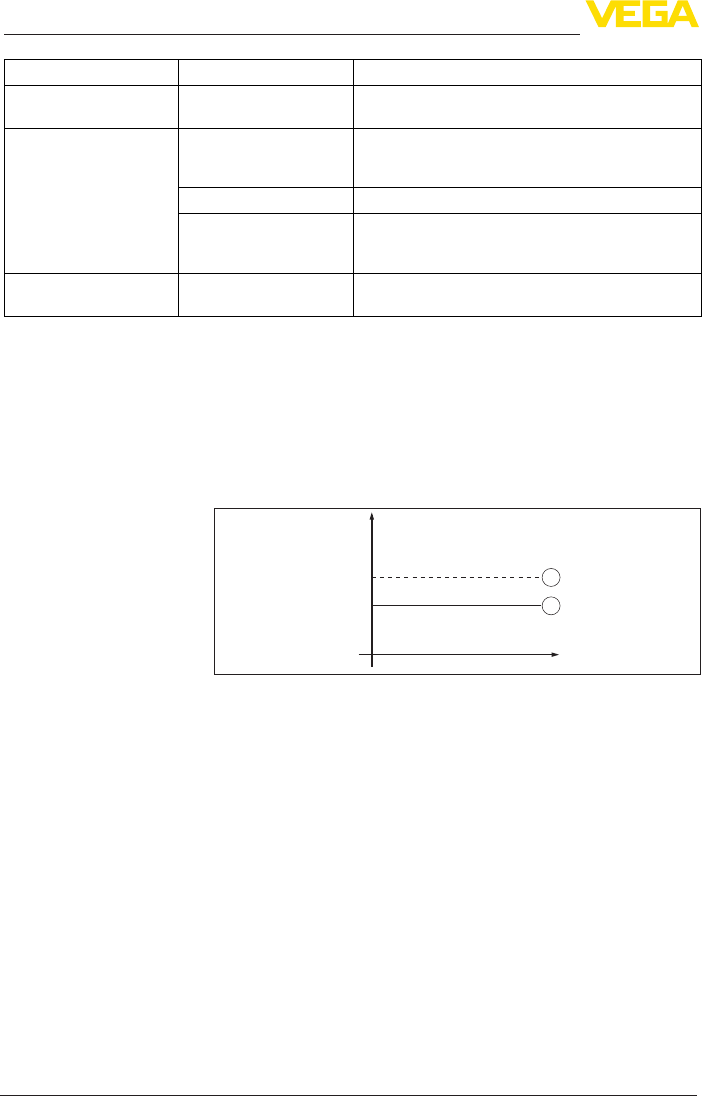
70
9 Diagnosis, asset management and service
VEGAPULS 62 • 4 … 20 mA/HART - two-wire
36503-EN-161221
Error Cause Rectication
4 … 20 mA signal not sta-
ble •
Fluctuations of the
measured variable •
Set damping appropriate to the instrument via the
display and adjustment module or PACTware/DTM
4 … 20 mA signal missing •
Electrical connection
faulty •
Check connection according to chapter "Connection
steps" and if necessary, correct according to chapter
"Wiring plan"
•
Voltage supply missing •
Check cables for breaks; repair if necessary
•
Operating voltage too
low or load resistance
too high
•
Check, adapt if necessary
Current signal greater than
22 mA or less than 3.6 mA •
Electronics module in the
sensor defective •
Exchange the instrument or send it in for repair
The below tables show typical examples of application-related meas-
urementerrorswithliquids.Themeasurementerrorsaredierentiated
according to the following:
• Constant level
• Filling
• Emptying
The images in column "Error pattern" show the real level as a broken
line and the level displayed by the sensor as a continuous line.
1
2
Level
time
0
1 Real level
2 Level displayed by the sensor
Notes:
• Wherever the sensor displays a constant value, the reason could
also be the fault setting of the current output to "Hold value"
• If the level indication is too low, the reason could be a line resist-
ance that is too high
Treatment of measure-
ment errors with liquids
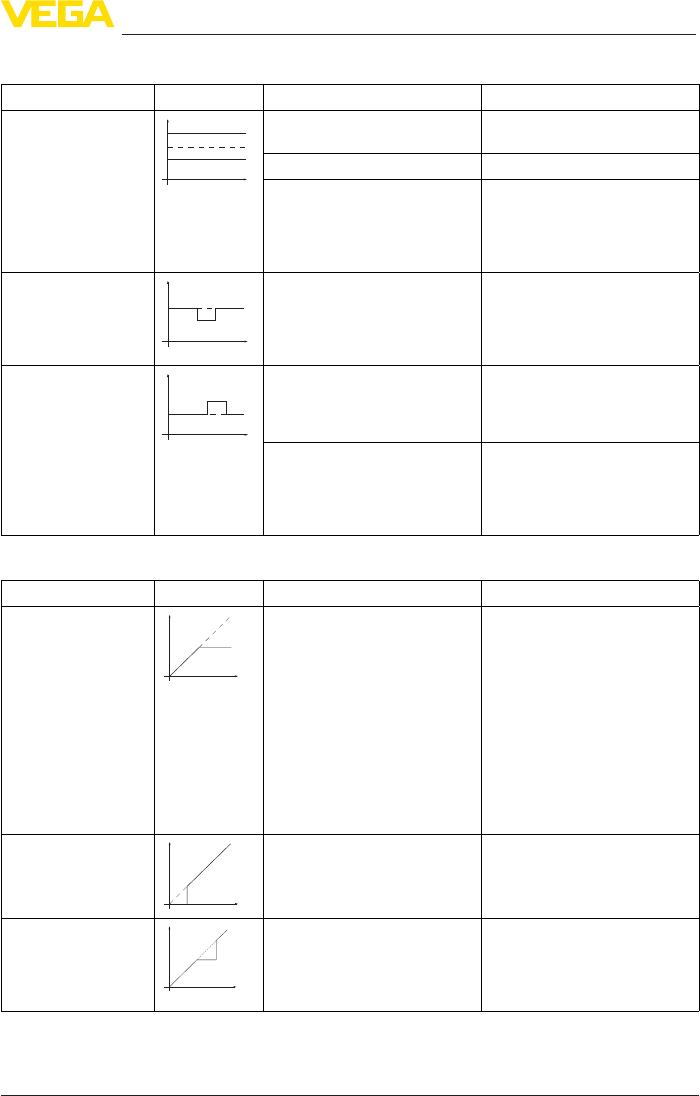
71
9 Diagnosis, asset management and service
VEGAPULS 62 • 4 … 20 mA/HART - two-wire
36503-EN-161221
Measurement error with constant level
Fault description Error pattern Cause Rectication
1. Measured value
shows a too low or too
high level
Level
time
0
•
Min./max. adjustment not
correct •
Adapt min./max. adjustment
•
Incorrectlinearizationcurve •
Adaptlinearizationcurve
•
Installation in a bypass tube or
standpipe, hence running time
error (small measurement error
close to 100 %/large error close
to 0 %)
•
Check parameter "Application"
with respect to vessel form,
adapt if necessary (bypass,
standpipe, diameter)
2. Measured value
jumps towards 0 %
Level
time
0
•
Multiple echo (vessel top,
product surface) with amplitude
higher than the level echo
•
Check parameter "Application",
especially vessel top, type of
medium, dished bottom, high
dielectric constant, and adapt if
necessary
3. Measured value
jumps towards 100 %
Level
time
0
•
Due to the process, the ampli-
tude of the level echo sinks
•
A false signal suppression was
not carried out
•
Carry out a false signal suppres-
sion
•
Amplitude or position of a false
signal has changed (e.g. con-
densation, buildup); false signal
suppression no longer matches
actual conditions
•
Determine the reason for the
changed false signals, carry out
false signal suppression, e.g.
with condensation
Measurementerrorduringlling
Fault description Error pattern Cause Rectication
4. Measured value re-
mains unchanged
duringlling
Level
time
0
•
False signals in the close range
too big or level echo too small
•
Strong foam or spout generation
•
Max. adjustment not correct
•
Eliminate false signals in the
close range
•
Check measurement situation:
Antenna must protrude out of
the socket, installations
•
Remove contamination on the
antenna
•
In case of interferences due to
installations in the close range:
Change polarisation direction
•
Create a new false signal sup-
pression
•
Adapt max. adjustment
5. Measured value re-
mains in the bottom
sectionduringlling
Level
time
0
•
Echo from the tank bottom
larger than the level echo, for
example, with products with
εr < 2.5 oil-based, solvents
•
Check parameters Medium,
Vessel height and Floor form,
adapt if necessary
6. Measured value re-
mains momentarily
unchangedduringll-
ing and then jumps to
the correct level
Level
time
0
•
Turbulence on the product
surface,quicklling •
Check parameters, change if
necessary, e.g. in dosing vessel,
reactor
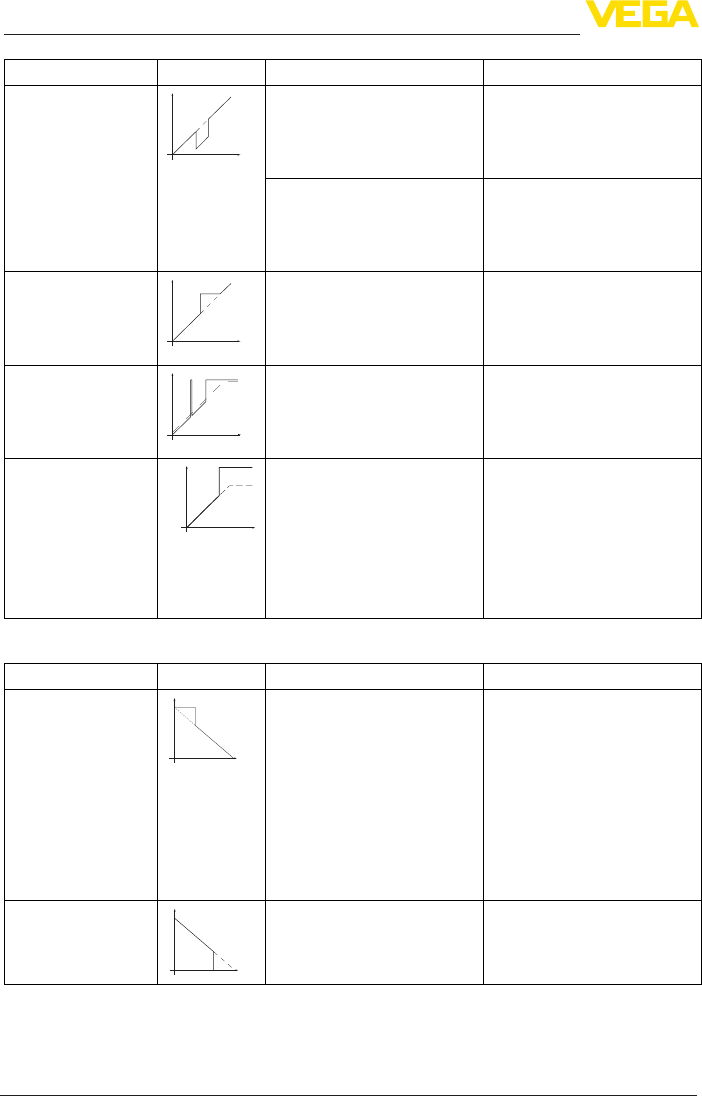
72
9 Diagnosis, asset management and service
VEGAPULS 62 • 4 … 20 mA/HART - two-wire
36503-EN-161221
Fault description Error pattern Cause Rectication
7. Measured value
jumps towards 0 %
duringlling
Level
time
0
•
Amplitude of a multiple echo
(vessel top - product surface) is
larger than the level echo
•
Check parameter "Application",
especially vessel top, type of
medium, dished bottom, high
dielectric constant, and adapt if
necessary
•
The level echo cannot be distin-
guished from the false signal at
a false signal position (jumps to
multiple echo)
•
In case of interferences due to
installations in the close range:
Change polarisation direction
•
Chose a more suitable installa-
tion position
8. Measured value
jumps towards 100 %
duringlling
Level
time
0
•
Due to strong turbulence and
foamgenerationduringlling,
the amplitude of the level echo
sinks. Measured value jumps to
false signal
•
Carry out a false signal suppres-
sion
9. Measured value
jumps sporadically to
100%duringlling
Level
time
0
•
Varying condensation or con-
tamination on the antenna •
Carry out a false signal suppres-
sion or increase false signal
suppression with condensation/
contamination in the close
range by editing
10. Measured value
jumpsto≥100%or
0 m distance
Level
time
0
•
Level echo is no longer
detected in the close range
due to foam generation or false
signals in the close range. The
sensorgoesintooverllprotec-
tion mode. The max. level (0 m
distance) as well as the status
message"Overllprotection"
are outputted.
•
Check measuring site: Antenna
must protrude out of the socket
•
Remove contamination on the
antenna
•
Use a sensor with a more suit-
able antenna
Measurement error during emptying
Fault description Error pattern Cause Rectication
11. Measured value re-
mains unchanged in
the close range during
emptying
Level
time
0
•
False signal larger than the level
echo
•
Level echo too small
•
Eliminate false signal in the
close range. Check: Antenna
must protrude from the socket
•
Remove contamination on the
antenna
•
In case of interferences due to
installations in the close range:
Change polarisation direction
•
After eliminating the false sig-
nals, the false signal suppres-
sion must be deleted. Carry out
a new false signal suppression
12. Measured value
jumps towards 0 %
during emptying
Level
time
0
•
Echo from the tank bottom
larger than the level echo, for
example, with products with
εr < 2.5 oil-based, solvents
•
Check parameters Medium
type, Vessel height and Floor
form, adapt if necessary
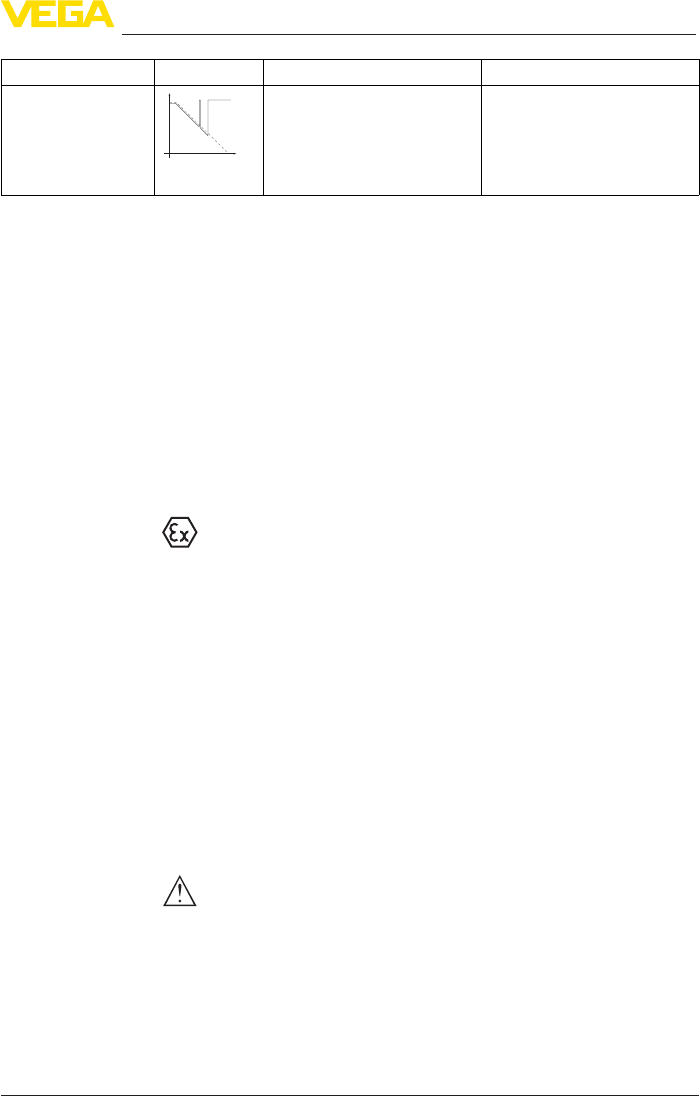
73
9 Diagnosis, asset management and service
VEGAPULS 62 • 4 … 20 mA/HART - two-wire
36503-EN-161221
Fault description Error pattern Cause Rectication
13. Measured value
jumps sporadically to-
wards 100 % during
emptying
Level
time
0
•
Varying condensation or con-
tamination on the antenna •
Carry out false signal suppres-
sion or increase false signal
suppression in the close range
by editing
•
With bulk solids, use radar sen-
sor with purging air connection
Depending on the reason for the fault and the measures taken, the
steps described in chapter "Setup" must be carried out again or must
be checked for plausibility and completeness.
Should these measures not be successful, please call in urgent cases
the VEGA service hotline under the phone no. +49 1805 858550.
The hotline is also available outside normal working hours, seven
days a week around the clock.
Sinceweoerthisserviceworldwide,thesupportisprovidedin
English. The service itself is free of charge, the only costs involved are
the normal call charges.
9.5 Exchanging the electronics module
If the electronics module is defective, it can be replaced by the user.
In Ex applications, only instruments and electronics modules with ap-
propriate Ex approval may be used.
If there is no electronics module available on site, the electronics
module can be ordered through the agency serving you. The electron-
icsmodulesareadaptedtotherespectivesensoranddierinsignal
output or voltage supply.
The new electronics module must be loaded with the default settings
of the sensor. These are the options:
• In the factory
• Or on site by the user
In both cases, the serial number of the sensor is needed. The serial
numbers are stated on the type label of the instrument, on the inside
of the housing as well as on the delivery note.
Whenloadingonsite,rstofalltheorderdatamustbedownloaded
from the Internet (see operating instructions manual "Electronics
module").
Caution:
Alluser-specicsettingsmustbeenteredagain.Hence,youhaveto
carry out a new setup after the electronics exchange.
If you have stored the data of the parameter adjustment during the
rstsetupofthesensor,youcantransferthesetothereplacement
electronics module. A new setup is no more necessary.
Reaction after fault recti-
cation
24 hour service hotline

74
9 Diagnosis, asset management and service
VEGAPULS 62 • 4 … 20 mA/HART - two-wire
36503-EN-161221
9.6 Software update
The following components are required to update the instrument
software:
• Instrument
• Voltage supply
• Interface adapter VEGACONNECT
• PC with PACTware
• Currentinstrumentsoftwareasle
Youcanndthecurrentinstrumentsoftwareaswellasdetailed
information on the procedure in the download area of our homepage:
www.vega.com.
Caution:
Instruments with approvals can be bound to certain software versions.
Thereforemakesurethattheapprovalisstilleectiveafterasoftware
update is carried out.
Youcannddetailedinformationinthedownloadareaat
www.vega.com.
9.7 How to proceed if a repair is necessary
Youcanndaninstrumentreturnformaswellasdetailedinforma-
tion about the procedure in the download area of our homepage:
www.vega.com.
By doing this you help us carry out the repair quickly and without hav-
ing to call back for needed information.
If a repair is necessary, please proceed as follows:
• Printandlloutoneformperinstrument
• Clean the instrument and pack it damage-proof
• Attach the completed form and, if need be, also a safety data
sheet outside on the packaging
• Please contact the agency serving you to get the address for
thereturnshipment.Youcanndtheagencyonourhomepage
www.vega.com.

75
10 Dismount
VEGAPULS 62 • 4 … 20 mA/HART - two-wire
36503-EN-161221
10 Dismount
10.1 Dismounting steps
Warning:
Before dismounting, be aware of dangerous process conditions such
as e.g. pressure in the vessel or pipeline, high temperatures, cor-
rosive or toxic products etc.
Take note of chapters "Mounting" and "Connecting to power supply"
and carry out the listed steps in reverse order.
10.2 Disposal
The instrument consists of materials which can be recycled by spe-
cialised recycling companies. We use recyclable materials and have
designed the parts to be easily separable.
Correctdisposalavoidsnegativeeectsonhumansandtheenviron-
ment and ensures recycling of useful raw materials.
Materials: see chapter "Technical data"
If you have no way to dispose of the old instrument properly, please
contact us concerning return and disposal.
WEEE directive 2002/96/EG
This instrument is not subject to the WEEE directive 2002/96/EG and
the respective national laws. Pass the instrument directly on to a spe-
cialised recycling company and do not use the municipal collecting
points. These may be used only for privately used products according
to the WEEE directive.

76
11 Supplement
VEGAPULS 62 • 4 … 20 mA/HART - two-wire
36503-EN-161221
11 Supplement
11.1 Technical data
General data
316L corresponds to 1.4404 or 1.4435
Materials, wetted parts
Ʋ Processtting 316L, Alloy C22 (2.4602), Alloy 400 (2.4360)
ƲProcess seal On site (instruments with thread: Klingersil C-4400 is
attached)
ƲAntenna 316L,Alloy C22 (2.4602), Tantalum, 316L electropol-
ished, stainless steel investment casting 1.4848, Alloy
400 (2.4360), 316L Safecoat coated
ƲAntenna impedance cone PTFE, PP, PEEK, ceramic (99.7 % Al2O3)
Ʋseal, antenna system FKM(SHSFPM70C3GLT),FFKM(Kalrez6375),FFKM
(Kalrez6230-FDA),graphite(99.9%)
Materials, non-wetted parts
ƲPlastic housing plastic PBT (Polyester)
ƲAluminium die-casting housing Aluminium die-casting AlSi10Mg, powder-coated - basis:
Polyester
ƲStainless steel housing 316L
ƲCable gland PA, stainless steel, brass
ƲSealing, cable gland NBR
ƲBlind plug, cable gland PA
ƲSeal between housing and housing lid Silicone SI 850 R, NBR silicone-free
ƲInspection window in housing cover
(optional)
Polycarbonate
ƲGround terminal 316L
Ohmic contact Betweengroundterminal,processttingandantenna
Processttings
ƲPipe thread, cylindrical (ISO 228 T1) G1½ according to DIN 3852-A
ƲAmerican pipe thread, conically 1½ NPT, 2 NPT
ƲFlanges DIN from DN 25, ASME from 1"
Weights
ƲInstrument (depending on housing,
processttingandantenna)
approx. 2 … 17.2 kg (4.409 … 37.92 lbs)
ƲAntenna extension 1.6 kg/m (1.157 lbs/ft)
Length antenna extension max. 5.85 m (19.19 ft)
Torques
Max. torques, threaded version
ƲG1½ 200 Nm (147.5 lbf ft)
Max. torques, antenna system
ƲMounting screws, antenna cone 2,5 Nm (1.8 lbf ft)
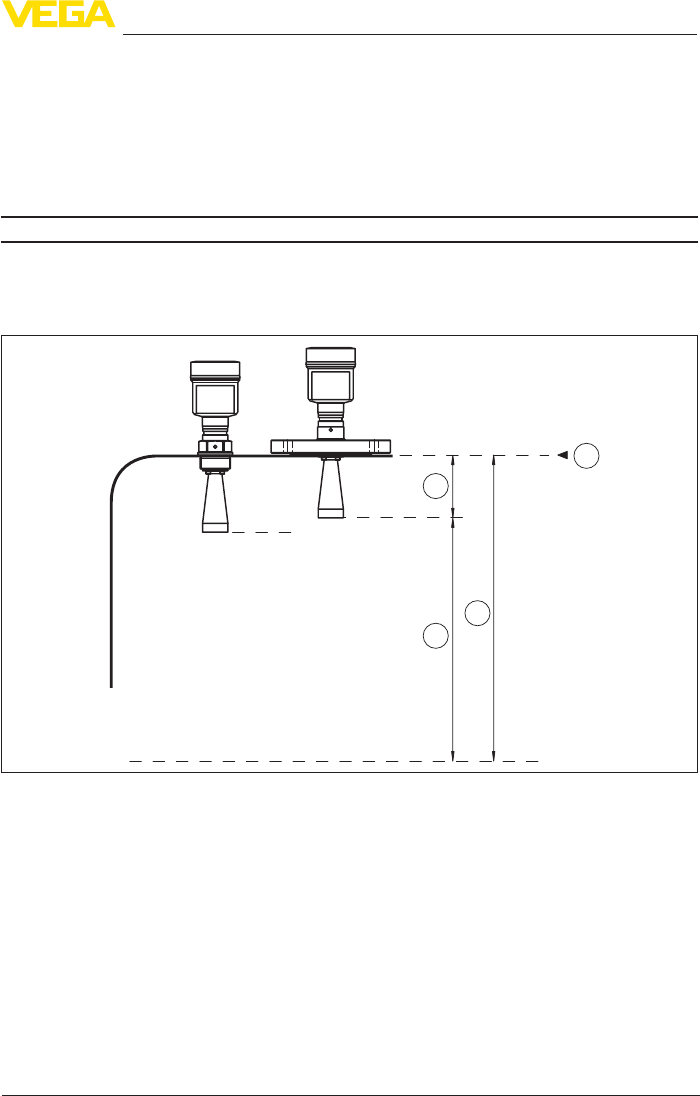
77
11 Supplement
VEGAPULS 62 • 4 … 20 mA/HART - two-wire
36503-EN-161221
ƲCompression nut, parabolic antenna 50 Nm (36.89 lbf ft)
ƲCounter nut, parabolic antenna 40 Nm (29.50 lbf ft)
ƲTerminal screws, swivelling holder 20 Nm (14.75 lbf ft)
Max. torques for NPT cable glands and Conduit tubes
ƲPlastic housing 10 Nm (7.376 lbf ft)
ƲAluminium/Stainless steel housing 50 Nm (36.88 lbf ft)
Input variable
Measured variable The measured quantity is the distance between the end
of the sensor antenna and the product surface. The ref-
erence plane for the measurement is the sealing surface
onthehexagonorthelowersideoftheange.
3
4
2
1
Fig. 56: Data of the input variable
1 Reference plane
2 Measured variable, max. measuring range
3 Antenna length
4 Utilisable measuring range
Standard electronics
Max. measuring range 35 m (114.83 ft)
Recommended measuring range
ƲAntenna ø 40 mm (1.575 in) up to 15 m (49.21 ft)
ƲAntenna ø 48 mm (1.89 in) up to 20 m (65.62 ft)
ƲAntenna ø 75 mm (2.953 in), ø 95 mm
(3.74 in), parabolic antenna
up to 35 m (114.83 ft)

78
11 Supplement
VEGAPULS 62 • 4 … 20 mA/HART - two-wire
36503-EN-161221
Electronics with increased sensitivity
Max. measuring range 75 m (246.1 ft)
Recommended measuring range
ƲAntenna ø 40 mm (1.575 in) up to 15 m (49.21 ft)
ƲAntenna ø 48 mm (1.89 in) up to 20 m (65.62 ft)
ƲAntenna ø 75 mm (2.953 in) up to 40 m (131.23 ft)
ƲAntenna ø 95 mm (3.74 in) up to 50 m (164 ft)
ƲParabolic antenna up to 75 m (246.1 ft)
Output variable
Output signal 4 … 20 mA/HART
Range of the output signal 3.8 … 20.5 mA/HART (default setting)
Signal resolution 0.3 µA
Resolution, digital < 1 mm (0.039 in)
Failure signal current output (adjustable) mA-value unchanged 20.5 mA, 22 mA, < 3.6 mA
Max. output current 22 mA
Starting current ≤3.6mA;≤10mAfor5msafterswitchingon
Load see load diagram under Power supply
Damping (63 % of the input variable),
adjustable
0 … 999 s
HART output values according to HART 7.02)
ƲPV (Primary Value) Distance
ƲSV (Secondary Value) Percent
ƲTV (Third Value) Lin. percent
ƲQV (Fourth Value) Scaled
FullledHARTspecication 7.0
Further information on Manufacturer ID,
Device ID, Device Revision
See website of HART Communication Foundation
Accuracy (according to DIN EN 60770-1)
Process reference conditions according to DIN EN 61298-1
ƲTemperature +18 … +30 °C (+64 … +86 °F)
ƲRelative humidity 45 … 75 %
ƲAir pressure 860 … 1060 mbar/86 … 106 kPa (12.5 … 15.4 psig)
Installation reference conditions
ƲMin. distance to internal installations > 200 mm (7.874 in)
Ʋ Reector Flatplatereector
Ʋ Falsereections Biggest false signal, 20 dB smaller than the useful signal
Deviation with liquids See following diagrams
2) Default values can be assigned individually
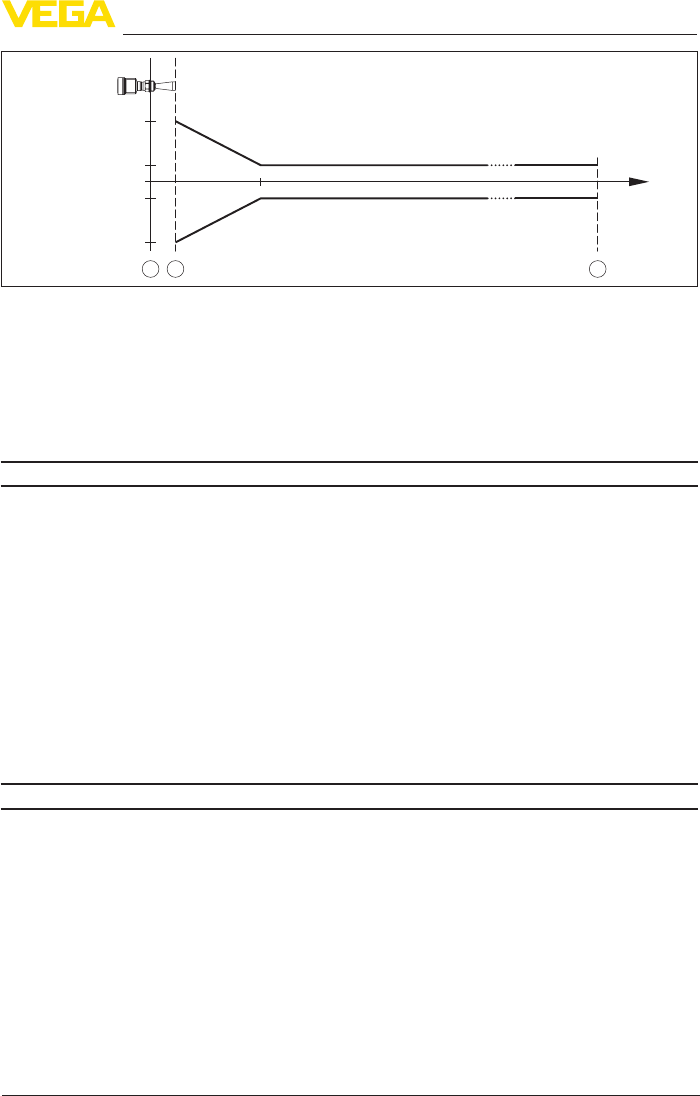
79
11 Supplement
VEGAPULS 62 • 4 … 20 mA/HART - two-wire
36503-EN-161221
0,5 m (1.6 ft)
10 mm (0.394 in)
2 mm (0.079 in)
- 2 mm (- 0.079 in)
- 10 mm (- 0.394 in)
0
1 2 3
Fig. 57: Deviation under reference conditions
1 Reference plane
2 Antenna edge
3 Recommended measuring range
Repeatability ≤±1mm
Deviation with bulk solids The values depend to a great extent on the application.
Bindingspecicationsarethusnotpossible.
Variablesinuencingmeasurementaccuracy
Specicationsapplytothedigitalmeasuredvalue
Temperature drift - Digital output ±3mm/10K,max.10mm
Additional deviation through electromag-
netic interference acc. to EN 61326
<±50mm
Specicationsapplyalsotothecurrentoutput
Temperature drift - Current output ±0.03%/10Krelatingtothe16mAspanmax.±0.3%
Deviation on the current output through analogue/digital conversion
ƲNon-Ex and Ex-ia version <±15µA
ƲEx-d-ia version <±40µA
Deviation in the current output due to
strong, high-frequency electromagnetic
eldsacc.toEN61326
<±150µA
Inuenceofthesuperimposedgasandpressuretotheaccuracy
The propagation speed of the radar impulses in gas or vapour above the medium is reduced by
highpressure.Thiseectdependsonthesuperimposedgasorvapourandisespeciallylargeat
low temperatures.
Thefollowingtableshowstheresultingdeviationforsometypicalgasesandvapours.Thespecied
values refer to the distance. Positive values mean that the measured distance is too large, negative
values that the measured distance is too small.
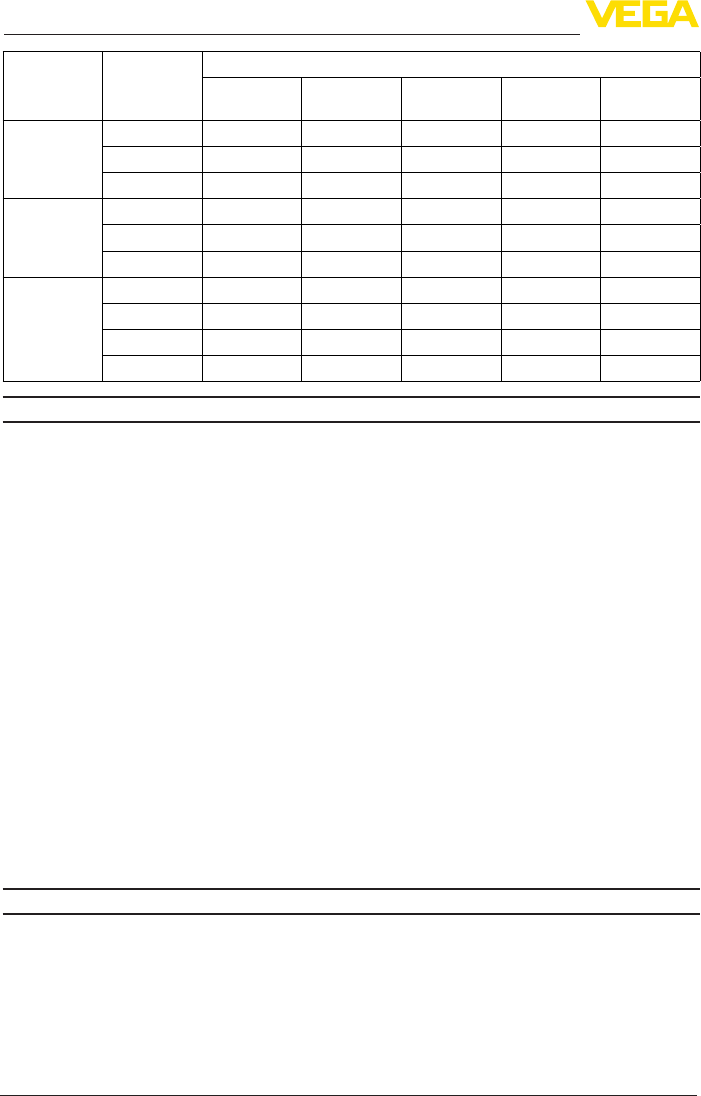
80
11 Supplement
VEGAPULS 62 • 4 … 20 mA/HART - two-wire
36503-EN-161221
Gas phase Temperature Pressure
1 bar
(14.5 psig)
10 bar
(145 psig)
50 bar
(725 psig)
100 bar
(1450 psig)
200 bar
(2900 psig)
Air 20 °C/68 °F 0.00 % 0.22 % 1.2 % 2.4 % 4.9 %
200 °C/392 °F -0.01 % 0.13 % 0.74 % 1.5 % 3.0 %
400 °C/752 °F -0.02 % 0.08 % 0.52 % 1.1 % 2.1 %
Hydrogen 20 °C/68 °F -0.01 % 0.10 % 0.61 % 1.2 % 2.5 %
200 °C/392 °F -0.02 % 0.05 % 0.37 % 0.76 % 1.6 %
400 °C/752 °F -0.02 % 0.03 % 0.25 % 0.53 % 1.1 %
Steam (satu-
rated steam)
100 °C/212 °F 0.26 % - - - -
180 °C/356 °F 0.17 % 2.1 % - - -
264 °C/507 °F 0.12 % 1.44 % 9.2 % - -
366 °C/691 °F 0.07 % 1.01 % 5.7 % 13.2 % 76 %
Characteristics and performance data
Measuring frequency K-band(26GHztechnology)
Measuring cycle time
ƲStandard electronics approx. 450 ms
ƲElectronics with increased sensitivity
approx.
700 ms
Step response time3) ≤3s
Beam angle4)
ƲHorn antenna ø 40 mm (1.575 in) 20°
ƲHorn antenna ø 48 mm (1.89 in) 15°
ƲHorn antenna ø 75 mm (2.953 in) 10°
ƲHorn antenna ø 95 mm (3.74 in) 8°
ƲParabolic antenna 3°
Emitted HF power (depending on the parameter adjustment)5)
ƲAverage spectral transmission power
density
-14dBm/MHzEIRP
ƲMax. spectral transmission power
density
+43dBm/50MHzEIRP
ƲMax. power density at a distance of
1 m
< 1 µW/cm²
Ambient conditions
Ambient, storage and transport tempera-
ture
-40 … +80 °C (-40 … +176 °F)
3) Time span after a sudden measuring distance change by max. 0.5 m in liquid applications, max 2 m with bulk
solidsapplications,untiltheoutputsignalhastakenforthersttime90%ofthenalvalue(IEC61298-2).
4) Outsidethespeciedbeamangle,theenergyleveloftheradarsignalis50%(-3dB)less.
5) EIRP: Equivalent Isotropic Radiated Power.
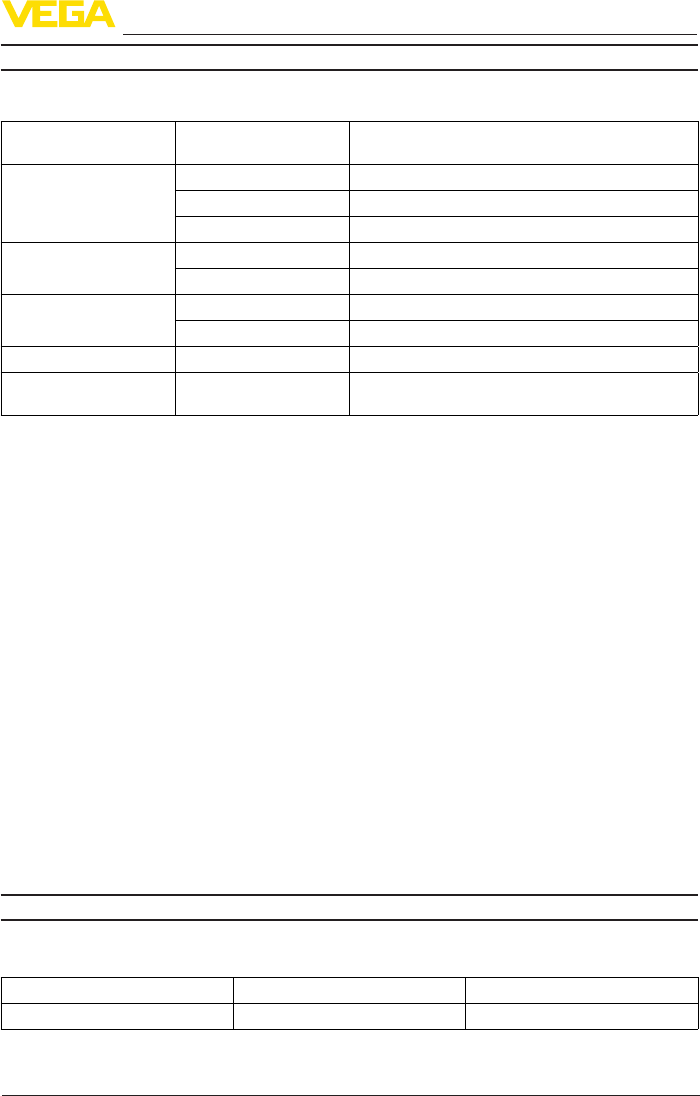
81
11 Supplement
VEGAPULS 62 • 4 … 20 mA/HART - two-wire
36503-EN-161221
Process conditions
Fortheprocessconditions,pleasealsonotethespecicationsonthetypelabel.Thelowestvalue
always applies.
Seal Antenna impedance
cone
Process temperature (measured on the process
tting)
FKM (SHS FPM 70C3
GLT)
PTFE -40 … +130 °C (-40 … +266 °F)
PTFE6) -40 … +200 °C (-40 … +392 °F)
PEEK7) -40 … +200 °C (-40 … +392 °F)
FFKM(Kalrez6375) PTFE -20 … +130 °C (-4 … +266 °F)
PEEK -20 … +250 °C (-4 … +482 °F)
FFKM(Kalrez6230) PTFE -15 … +130 °C (5 … +266 °F)
PEEK -15 … +250 °C (5 … +482 °F)
Graphite Ceramic -196 … +450 °C (-321 … +842 °F)
Graphite(processtting
Alloy C22)
Ceramic -196 … +400 °C (-321 … +752 °F)
Vessel pressure - horn antenna
ƲAntenna impedance cone PTFE -1 … 40 bar (-100 … 4000 kPa/-14.5 … 580 psig)
ƲAntenna impedance cone PP -1 … 3 bar (-100 … 300 kPa/-14.5 … 43.5 psig)
ƲAntenna impedance cone PEEK -1 … 100 bar (-100 … 10000 kPa/-14.5 … 1450 psig)
ƲAntenna impedance cone ceramic -1 … 160 bar (-100 … 16000 kPa/-14.5 … 2320 psig)
Vessel pressure - parabolic antenna -1 … 6 bar (-100 … 6000 kPa/-14.5 … 870 psig)
Vessel pressure with swivelling holder -1 … 1 bar (-100 … 100 kPa/-14.5 … 14.5 psig)
Vesselpressurerelatingtotheange
nominal pressure stage
see supplementary instructions manual "Flanges ac-
cording to DIN-EN-ASME-JIS"
Vibration resistance
ƲHorn antenna 4gat5…200HzaccordingtoEN60068-2-6(vibration
with resonance)
ƲParabolic antenna 1gat5…200HzaccordingtoEN60068-2-6(vibration
with resonance)
Shock resistance
ƲHorn antenna 100 g, 6 ms according to EN 60068-2-27 (mechanical
shock)
ƲParabolic antenna 25 g, 6 ms according to EN 60068-2-27 (mechanical
shock)
Data on rinsing air connection
Max. permissible pressure 6 bar (87.02 psig)
Air volume with horn antenna, depending on pressure (recommended area)
Pressure Withoutreuxvalve Withreuxvalve
0.5 bar (7.25 psig) 3.3 m3/h 1.2 m3/h
6) Not with steam
7) Not with steam
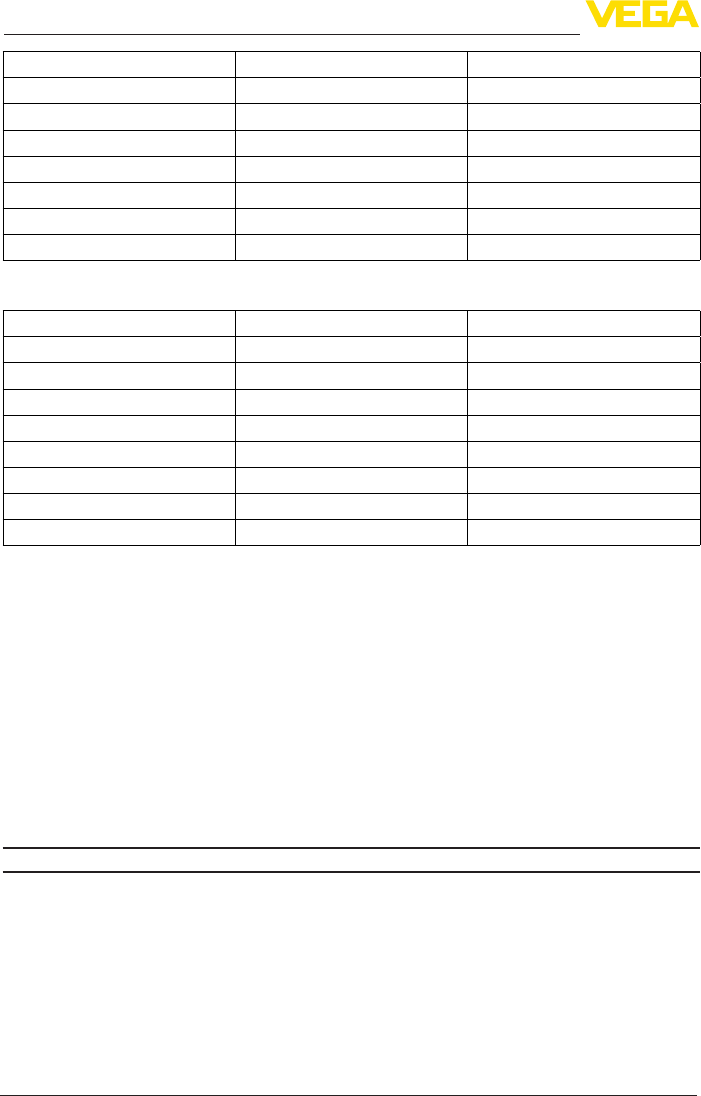
82
11 Supplement
VEGAPULS 62 • 4 … 20 mA/HART - two-wire
36503-EN-161221
Pressure Withoutreuxvalve Withreuxvalve
0.6 bar (8.70 psig) 3.5 m3/h 1.4 m3/h
0.7 bar (10.15 psig) 3.7 m3/h 1.7 m3/h
0.8 bar (11.60 psig) 3.9 m3/h 1.8 m3/h
0.9 bar (13.05 psig) 4.0 m3/h 2.1 m3/h
1 bar (14.5 psig) 4.2 m3/h 2.2 m3/h
1.5 bar (21.76 psig) 5.0 m3/h 3.2 m3/h
2 bar (29.0 psig) 5.5 m3/h 4.5 m3/h
Air volume with parabolic antenna, depending on pressure (recommended area)
Pressure Withoutreuxvalve Withreuxvalve
0.5 bar (7.25 psig) 3.0 m3/h 1.2 m3/h
0.6 bar (8.70 psig) 3.2 m3/h 1.4 m3/h
0.7 bar (10.15 psig) 3.4 m3/h 1.7 m3/h
0.8 bar (11.60 psig) 3.5 m3/h 1.9 m3/h
0.9 bar (13.05 psig) 3.6 m3/h 2.0 m3/h
1 bar (14.5 psig) 3.8 m3/h 2.2 m3/h
1.5 bar (21.76 psig) 4.3 m3/h 3.5 m3/h
2 bar (29.0 psig) 4.8 m3/h 4.0 m3/h
Thread G⅛
Closure with
ƲNon-Ex Dust protection cover of PE
ƲEx Threaded plug of 316Ti
Reuxvalve-unmounted(asoptionwithnon-Exversion,includedinthescopeofdeliverywithEx
version)
ƲMaterial 316Ti
ƲSeal FKM(SHSFPM70C3GLT),FFKM(Kalrez6375)
Ʋfor tube diameter 6 mm
ƲOpening pressure 0.5 bar (7.25 psig)
ƲNominal pressure stage PN 250
Electromechanical data - version IP 66/IP 67 and IP 66/IP 68; 0.2 bar
Options of the cable entry
ƲCable entry M20 x 1.5, ½ NPT
ƲCable gland M20 x 1,5; ½ NPT (cable ø see below table)
ƲBlind plug M20 x 1.5; ½ NPT
ƲClosing cap ½ NPT

83
11 Supplement
VEGAPULS 62 • 4 … 20 mA/HART - two-wire
36503-EN-161221
Material ca-
ble gland
Material seal
insert
Cable diameter
4.5 … 8.5 mm 5 … 9 mm 6 … 12 mm 7 … 12 mm 10 … 14 mm
PA NBR – ● ● –●
Brass, nickel-
plated
NBR ● ● ● – –
Stainless
steel
NBR –● ● –●
Wire cross-section (spring-loaded terminals)
ƲMassive wire, stranded wire 0.2 … 2.5 mm² (AWG 24 … 14)
ƲStranded wire with end sleeve 0.2 … 1.5 mm² (AWG 24 … 16)
Electromechanical data - version IP 66/IP 68 (1 bar)
Options of the cable entry
ƲCable gland with integrated connec-
tion cable
M20 x 1.5 (cable: ø 5 … 9 mm)
ƲCable entry ½ NPT
ƲBlind plug M20 x 1.5; ½ NPT
Connection cable
ƲWire cross-section 0.5 mm² (AWG 20)
ƲWire resistance <0.036Ω/m
ƲTensile strength < 1200 N (270 lbf)
ƲStandard length 5 m (16.4 ft)
ƲMax. length 180 m (590.6 ft)
ƲMin. bending radius 25 mm (0.984 in) with 25 °C (77 °F)
ƲDiameter approx. 8 mm (0.315 in)
ƲColour - Non-Ex version Black
ƲColour - Ex-version Blue
Display and adjustment module
Display element Display with backlight
Measured value indication
ƲNumber of digits 5
Ʋ Sizeofdigits W x H = 7 x 13 mm
Adjustment elements 4 keys
Protection rating
Ʋunassembled IP 20
Ʋmounted in the housing without lid IP 40
Materials
ƲHousing ABS
ƲInspection window Polyester foil

84
11 Supplement
VEGAPULS 62 • 4 … 20 mA/HART - two-wire
36503-EN-161221
Interface to the external display and adjustment unit
Data transmission Digital (I²C-Bus)
Connection cable Four-wire
Sensor version Conguration,connectioncable
Cable length Standard cable Special cable Screened
4 … 20 mA/HART 50 m ●– –
ProbusPA,Founda-
tion Fieldbus 25 m – ● ●
Integrated clock
Date format Day.Month.Year
Time format 12 h/24 h
TimezoneExfactory CET
Rate deviation max. 10.5 min/year
Additional output parameter - Electronics temperature
Output of the temperature values
ƲAnalogue Via the current output
ƲDigital Via the digital output signal - depending on the electron-
ics version
Range -40 … +85 °C (-40 … +185 °F)
Resolution < 0.1 K
Accuracy ±3K
Voltage supply
Operating voltage UB
ƲNon-Ex instrument 9.6 … 35 V DC
ƲEx ia instrument 9.6 … 30 V DC
ƲEx-d-ia instrument 14 … 35 V DC
ƲEx-d-ia instrument with ship approval 15 … 35 V DC
Operating voltage UB - illuminated display and adjustment module
ƲNon-Ex instrument 16 … 35 V DC
ƲEx ia instrument 16 … 30 V DC
ƲEx-d-ia instrument No lighting (integrated ia barrier)
Reverse voltage protection Integrated
Permissible residual ripple - Non-Ex, Ex-ia instrument
Ʋfor 9.6 V< UB < 14 V ≤0.7Ve(16…400Hz)
Ʋfor 18 V< UB < 36 V ≤1.0Ve(16…400Hz)
Permissible residual ripple - Ex-d-ia instrument
Ʋfor 18 V< UB < 36 V ≤1Ve(16…400Hz)
Load resistor
ƲCalculation (UB - Umin)/0.022 A

85
11 Supplement
VEGAPULS 62 • 4 … 20 mA/HART - two-wire
36503-EN-161221
ƲExample - Non-Ex instrument with
UB= 24 V DC
(24V-9.6V)/0.022A=655Ω
Electrical protective measures
Protection rating
Housing material Version IP-protection class NEMA protection
Plastic Single chamber IP 66/IP 67 Type4X
Double chamber IP 66/IP 67 Type4X
Aluminium Single chamber IP 66/IP 68 (0.2 bar)
IP 68 (1 bar)
Type 6P
Type 6P
Double chamber IP 66/IP 67
IP 66/IP 68 (0.2 bar)
IP 68 (1 bar)
Type4X
Type 6P
Type 6P
Stainless steel, electro-
polished
Single chamber IP 66/IP 68 (0.2 bar) Type 6P
Stainless steel, precision
casting
Single chamber IP 66/IP 68 (0.2 bar)
IP 68 (1 bar)
Type 6P
Type 6P
Double chamber IP 66/IP 67
IP 66/IP 68 (0.2 bar)
IP 68 (1 bar)
Type4X
Type 6P
Type 6P
Protection rating (IEC 61010-1) III
Approvals
Instrumentswithapprovalscanhavedierenttechnicalspecicationsdependingontheversion.
For that reason the associated approval documents of these instruments have to be carefully
noted. They are part of the delivery or can be downloaded under www.vega.com, "VEGA Tools"
and "Instrument search" as well as in the download area.
11.2 Dimensions
The following dimensional drawings represent only an extract of all possible versions. Detailed
dimensional drawings can be downloaded at www.vega.com/downloads under "Drawings".
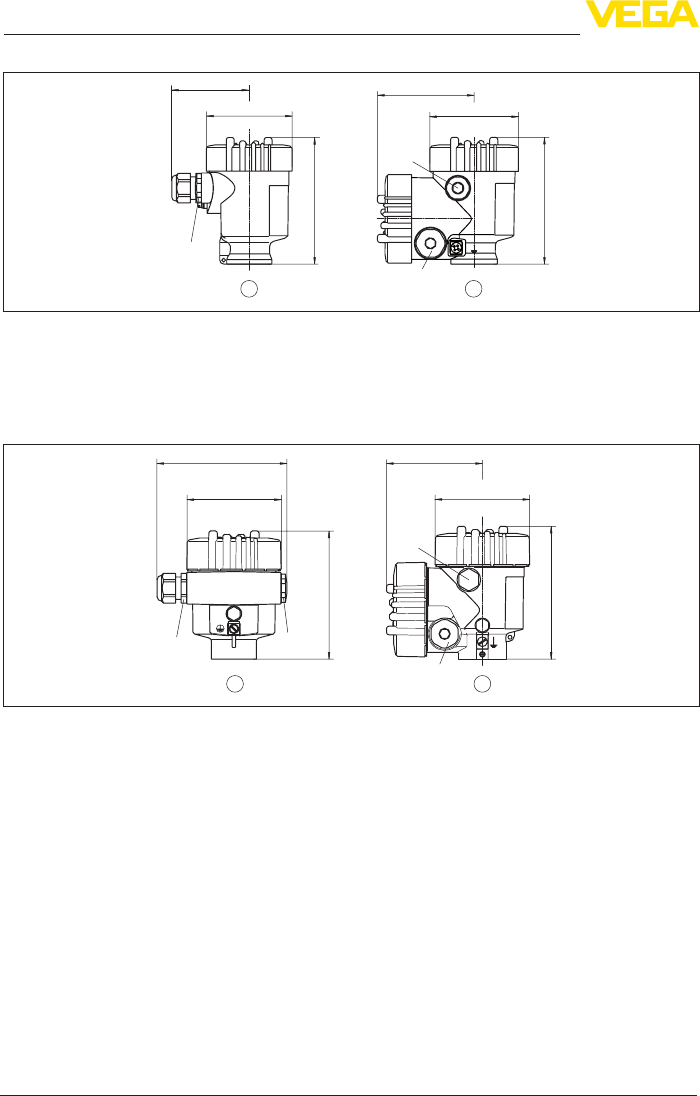
86
11 Supplement
VEGAPULS 62 • 4 … 20 mA/HART - two-wire
36503-EN-161221
Plastic housing
~ 69 mm
(2.72")
ø 79 mm
(3.11")
112 mm
(4.41")
M20x1,5/
½ NPT
~ 84 mm
(3.31")
M16x1,5
112 mm
(4.41")
M20x1,5/
½ NPT
12
ø 79 mm
(3.11")
Fig. 58: Housing versions with protection rating IP 66/IP 67 - with integrated display and adjustment module the
housing is 9 mm/0.35 in higher
1 Single chamber version
2 Double chamber version
Aluminium housing
21
ø 86 mm
(3.39")
~ 116 mm
(4.57")
116 mm
(4.57")
M20x1,5
M20x1,5/
½ NPT
~ 87 mm
(3.43")
M16x1,5
ø 86 mm
(3.39")
120 mm
(4.72")
M20x1,5/
½ NPT
Fig. 59: Housing versions with protection rating IP 66/IP 68 (0.2 bar) - with integrated display and adjustment
module the housing is 9 mm/0.35 in higher
1 Single chamber version
2 Double chamber version
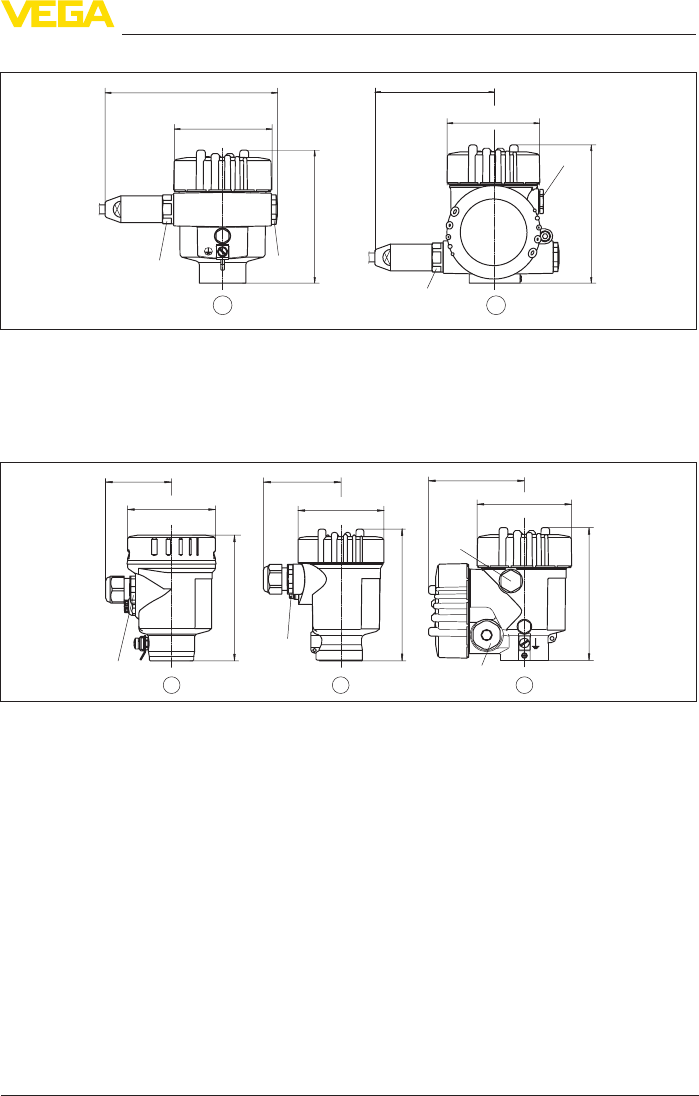
87
11 Supplement
VEGAPULS 62 • 4 … 20 mA/HART - two-wire
36503-EN-161221
Aluminium housing with protection rating IP 66/IP 68 (1 bar)
120 mm
(4.72")
~ 105 mm
(4.13")
116 mm
(4.57")
~ 150 mm
(5.91")
ø 86 mm
(3.39")
ø 86 mm
(3.39")
M20x1,5/
½ NPT
M16x1,5
2
M20x1,5
M20x1,5
1
Fig. 60: Housing version with protection rating IP 66/IP 68 (1 bar) - with integrated display and adjustment module
the housing is 9 mm/0.35 in higher
1 Single chamber version
2 Double chamber version
Stainless steel housing
~ 69 mm
(2.72")
ø 79 mm
(3.11")
117 mm
(4.61")
M20x1,5/
½ NPT
~ 59 mm
(2.32")
ø 80 mm
(3.15")
112 mm
(4.41")
M20x1,5/
½ NPT
~ 87 mm
(3.43") ø 86 mm
(3.39")
120 mm
(4.72")
M20x1,5/
½ NPT
M16x1,5
321
Fig. 61: Housing versions with protection rating IP 66/IP 68 (0.2 bar) - with integrated display and adjustment
module the housing is 9 mm/0.35 in higher
1 Single chamber version, electropolished
2 Single chamber version, precision casting
3 Double chamber version, precision casting
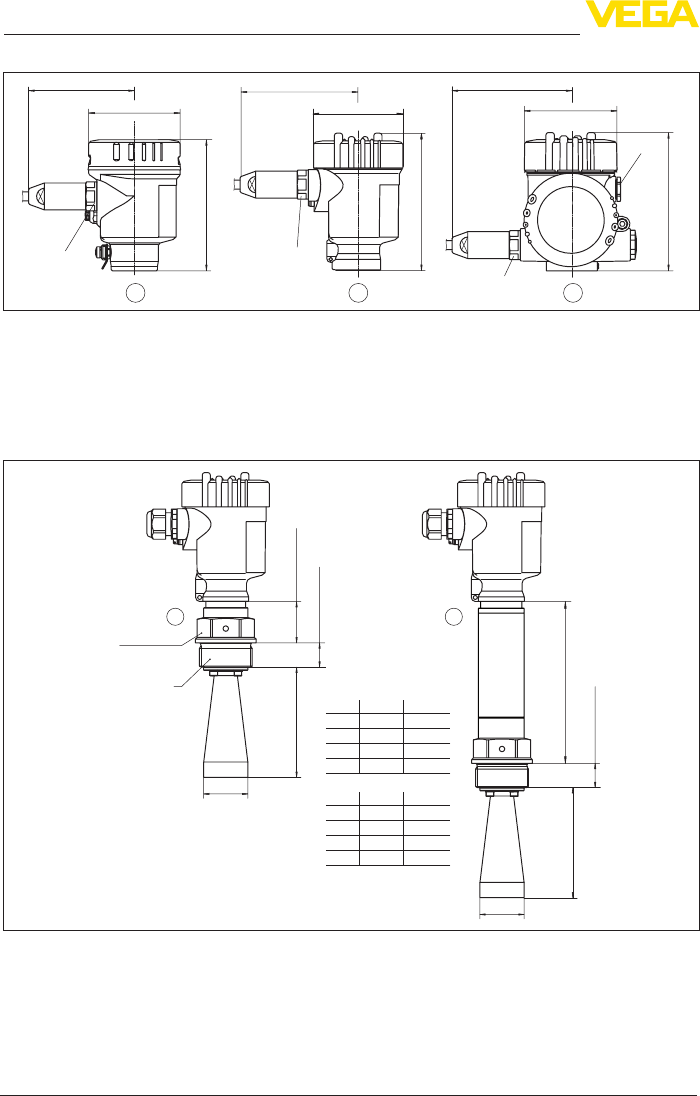
88
11 Supplement
VEGAPULS 62 • 4 … 20 mA/HART - two-wire
36503-EN-161221
Stainless steel housing with protection rating IP 66/IP 68, 1 bar
117 mm
(4.61")
~ 103 mm
(4.06") ø 79 mm
(3.11")
120 mm
(4.72")
~ 105 mm
(4.13") ø 86 mm
(3.39")
M20x1,5
M20x1,5/
½ NPT
M16x1,5
~ 93 mm
(3.66") ø 80 mm
(3.15")
112 mm
(4.41")
M20x1,5/
½ NPT
3
21
Fig. 62: Housing version with protection rating IP 66/IP 68 (1 bar) - with integrated display and adjustment module
the housing is 9 mm/0.35 in higher
1 Single chamber version, electropolished
2 Single chamber version, precision casting
3 Double chamber version, precision casting
VEGAPULS 62, horn antenna in threaded version
mm
inch
38 mm (1.50")
22 mm (0.87")
22 mm (0.87")
SW 46 mm
(1.81")
8.50"
16.93"
3.94" ø1.58"
ø1.89"
ø2.95"
ø3.74"
4.72"
x y
100 ø40
120 ø48
216 ø75
430 ø95
1½"
2"
3"
4"
x y
1½"
2"
3"
4"
x
y
G1½A / 1½ NPT
x
y
2 1
144 mm (5.67")
Fig. 63: VEGAPULS 62, horn antenna in threaded version
1 Standard
2 With temperature adapter up to 250 °C
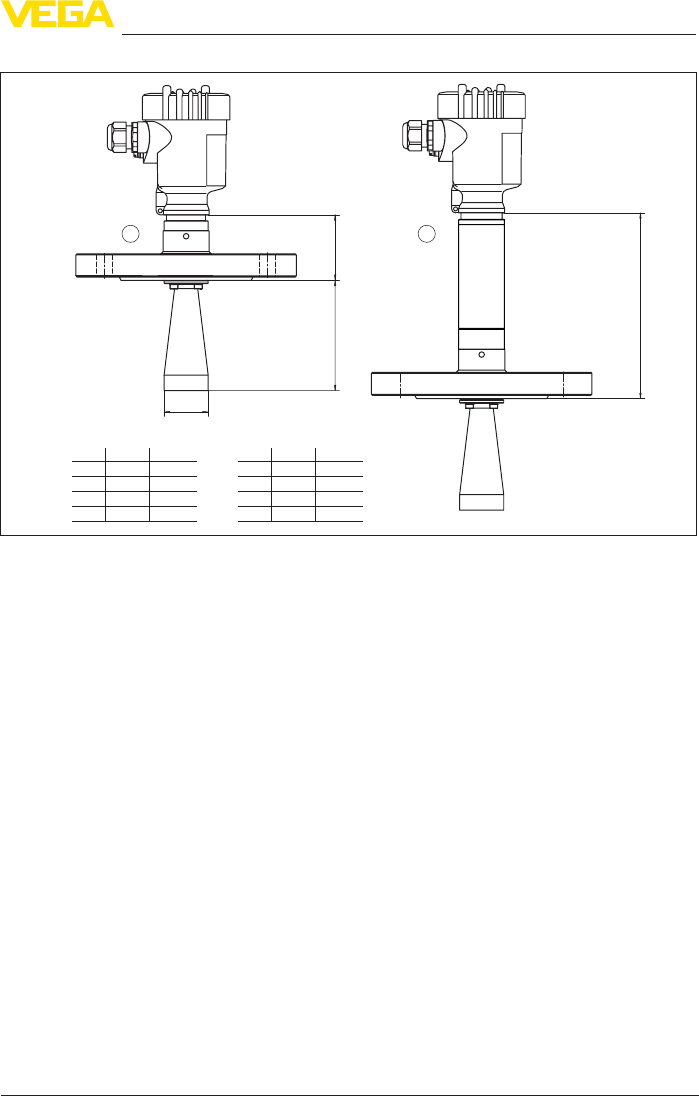
89
11 Supplement
VEGAPULS 62 • 4 … 20 mA/HART - two-wire
36503-EN-161221
VEGAPULS62,hornantennainangeversion
x
y
21
165 mm (6.5")
60 mm
(2.36")
mm inch
8.50"
16.93"
3.94" ø1.58"
ø1.89"
ø2.95"
ø3.74"
4.72"
xy
100 ø40
120 ø48
216 ø75
430 ø95
1½"
2"
3"
4"
xy
1½"
2"
3"
4"
Fig.64:VEGAPULS62,hornantennainangeversion
1 Standard
2 With temperature adapter up to 250 °C
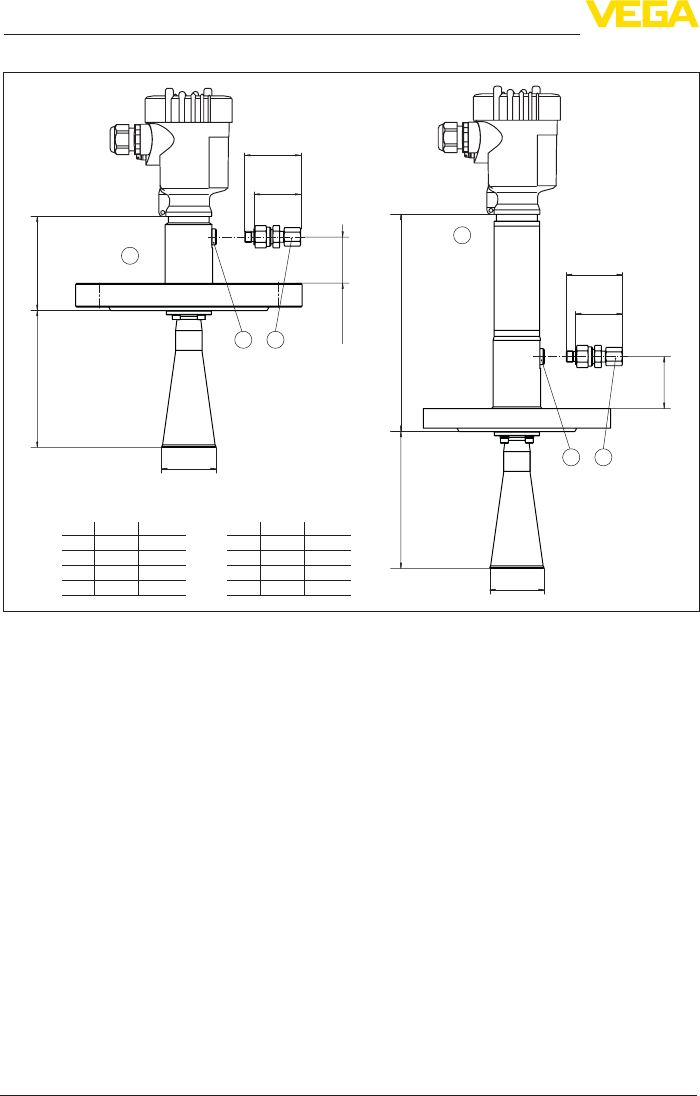
90
11 Supplement
VEGAPULS 62 • 4 … 20 mA/HART - two-wire
36503-EN-161221
VEGAPULS62,hornantennainangeversionwithpurgingairconnection
x
y
x
y
2
1
3 4
3 4
41,5 mm
(1.63")
83 mm
(3.27")
190 mm
(7.48")
49 mm
(1.93")
41 mm
(1.61")
mm inch
8.50"
16.93"
3.94" ø1.58"
ø1.89"
ø2.95"
ø3.74"
4.72"
xy
100 ø40
120 ø48
216 ø75
430 ø95
1½"
2"
3"
4"
xy
1½"
2"
3"
4"
45,5 mm
(1.79")
49 mm
(1.93")
41 mm
(1.61")
Fig.65:VEGAPULS62,hornantennainangeversionwithpurgingairconnection
1 Standard
2 With temperature adapter up to 250 °C
3 Blind plug
4 Reuxvalve
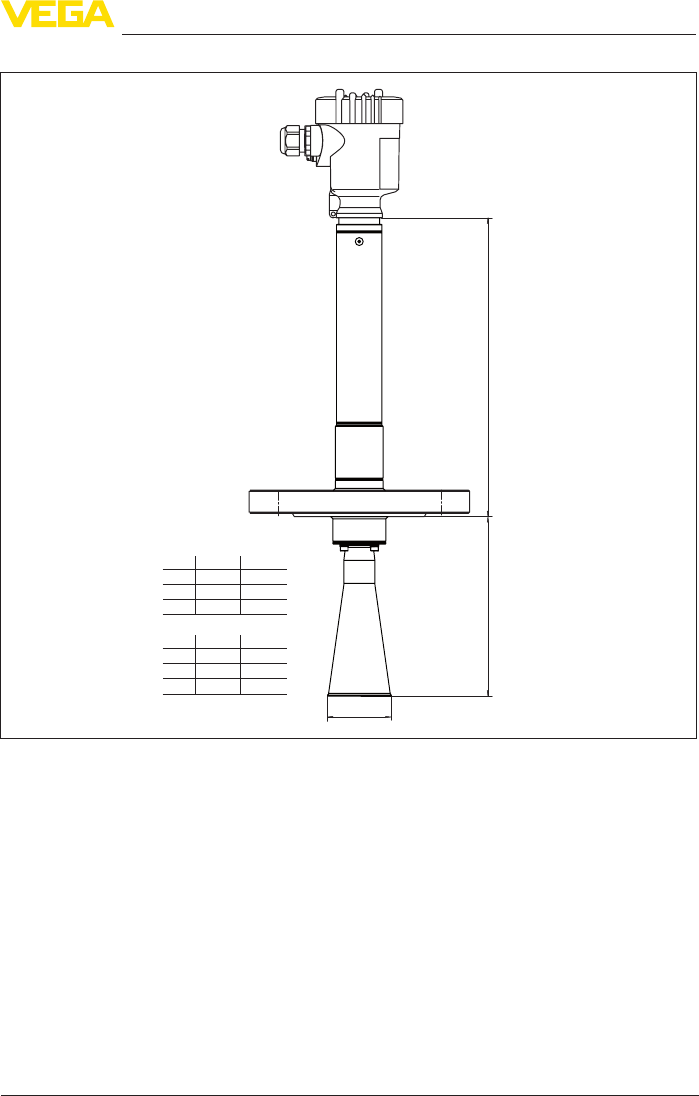
91
11 Supplement
VEGAPULS 62 • 4 … 20 mA/HART - two-wire
36503-EN-161221
VEGAPULS62,hornantennainangeversion450°C
y
x
inch
8.50"
11.30"
ø 1.89"
ø 2.95"
ø 3.74"
4.72"
mm xy
120 ø 48
216 ø 75
287 ø 95
2"
3"
4"
xy
2"
3"
4"
260 mm (10.24")
Fig.66:VEGAPULS62,hornantennainangeversionwithtemperatureadapterupto450°C
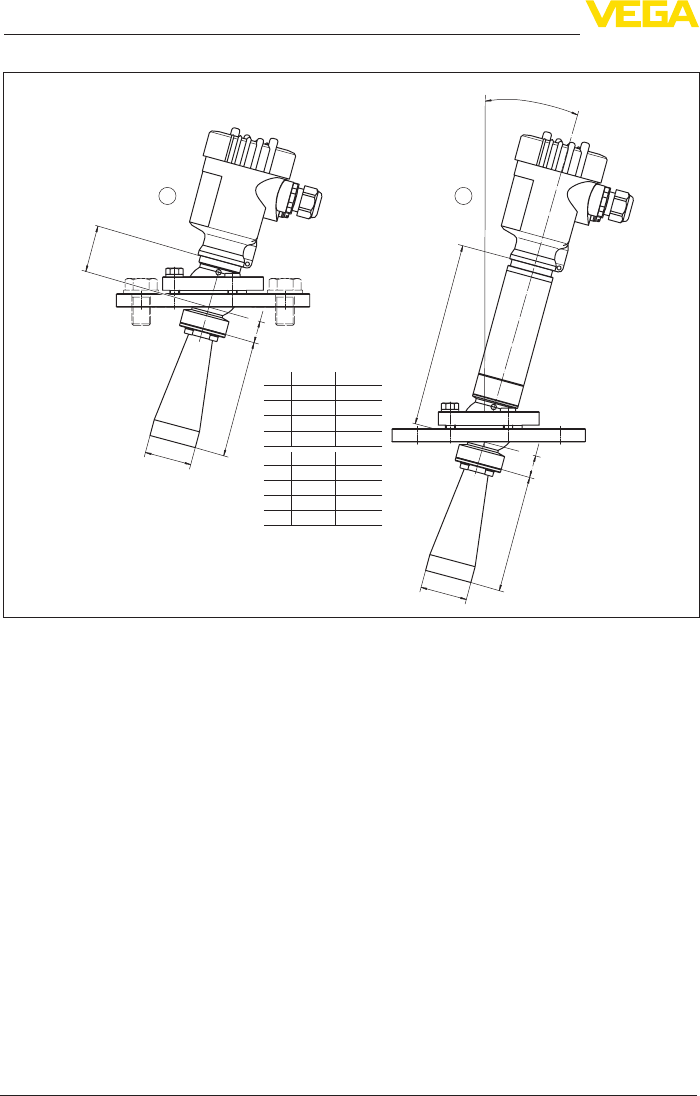
92
11 Supplement
VEGAPULS 62 • 4 … 20 mA/HART - two-wire
36503-EN-161221
VEGAPULS 62, horn antenna and swivelling holder
20 mm
(0.79")
20 mm
(0.79")
max. 15°
(0.59")
40 mm
(1.58")
146 mm (5.75")
x
y
x
y
3.94" ø 1.58"
ø 1.89"
ø 2.95"
ø 3.74"
4.72"
8.50"
16.93"
x y
100 ø 40
120 ø 48
216 ø 75
430 ø 95
1½"
2"
3"
4"
x y
1½"
2"
3"
4"
mm
inch
21
Fig. 67: VEGAPULS 62, horn antenna and swivelling holder
1 Standard
2 With temperature adapter up to 250 °C
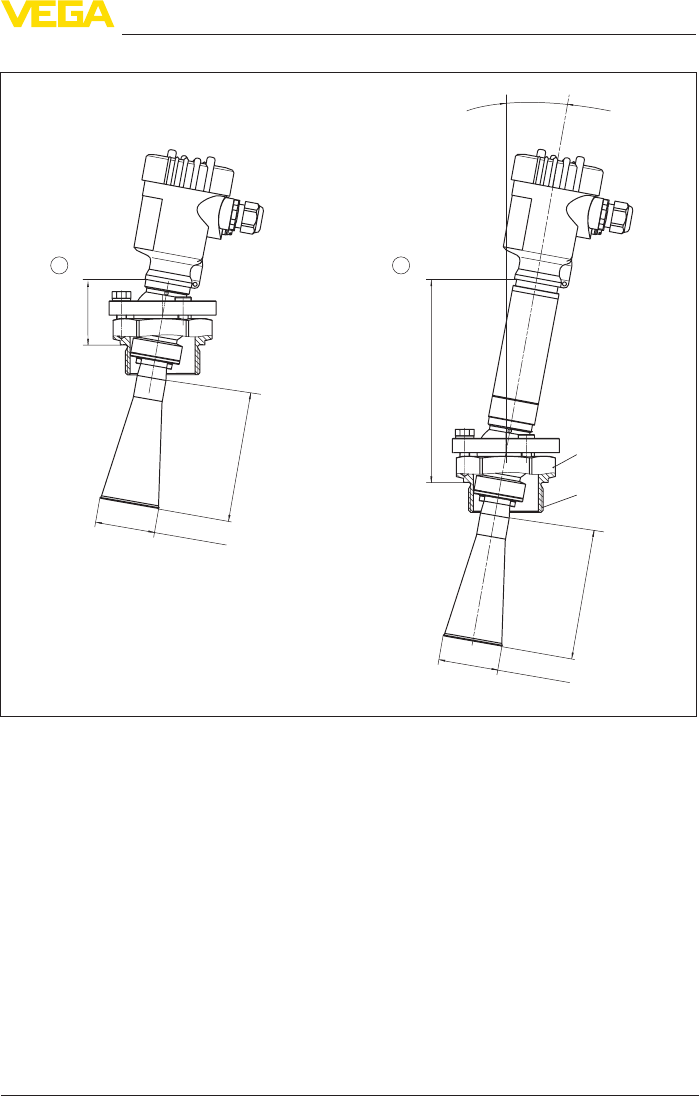
93
11 Supplement
VEGAPULS 62 • 4 … 20 mA/HART - two-wire
36503-EN-161221
VEGAPULS62,hornantennaandswivellingholder,threadedtting
max. 10°
(0.39")
53,6 mm
(2.11")
159,6 mm
(6.28")
102,2 mm
(4.02")
ø 40 / 48 mm
(1.57" / 1.89")
G2 / 2NPT
SW 70 mm
(2.76")
102,2 mm
(4.02")
ø 40 / 48 mm
(1.57" / 1.89")
21
Fig.68:VEGAPULS62,hornantennaandswivellingholder,threadedtting
1 Standard
2 With temperature adapter up to 250 °C
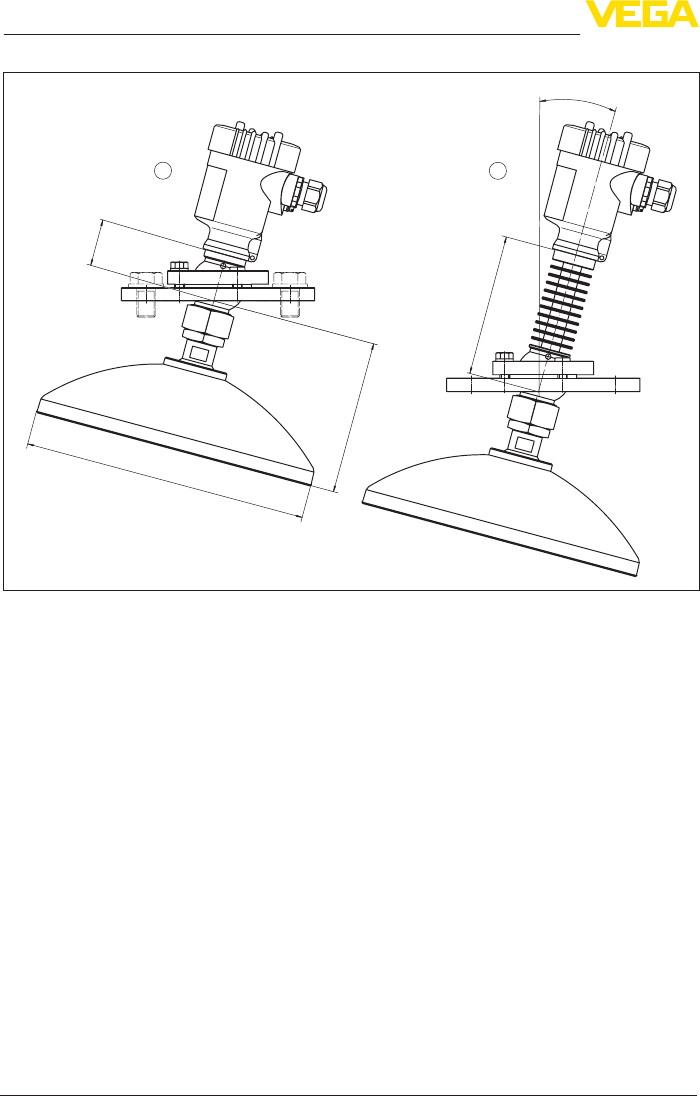
94
11 Supplement
VEGAPULS 62 • 4 … 20 mA/HART - two-wire
36503-EN-161221
VEGAPULS 62, parabolic antenna and swivelling holder
130 mm (5.12")
ø 243 mm (9.57")
1
40 mm
(1.58")
max. 15°
(0.59")
120 mm (4.72")
2
Fig. 69: VEGAPULS 62, parabolic antenna and swivelling holder
1 Standard
2 With temperature adapter up to 200 °C

95
11 Supplement
VEGAPULS 62 • 4 … 20 mA/HART - two-wire
36503-EN-161221
11.3 Industrial property rights
VEGA product lines are global protected by industrial property rights. Further information see
www.vega.com.
VEGA Produktfamilien sind weltweit geschützt durch gewerbliche Schutzrechte.
Nähere Informationen unter www.vega.com.
Les lignes de produits VEGA sont globalement protégées par des droits de propriété intellec-
tuelle. Pour plus d'informations, on pourra se référer au site www.vega.com.
VEGA lineas de productos están protegidas por los derechos en el campo de la propiedad indus-
trial. Para mayor información revise la pagina web www.vega.com.
Линии продукции фирмы ВЕГА защищаются по всему миру правами на интеллектуальную
собственность. Дальнейшую информацию смотрите на сайте www.vega.com.
VEGA系列产品在全球享有知识产权保护。
进一步信息请参见网站<www.vega.com。
11.4 Trademark
All the brands as well as trade and company names used are property of their lawful proprietor/
originator.

96
INDEX
VEGAPULS 62 • 4 … 20 mA/HART - two-wire
36503-EN-161221
INDEX
A
Adjustment 49, 50
Agitator 23
Application area 12
B
Backlight 52
C
Check output signal 69
Connection 32
– Cable 31
Copy sensor settings 59
Current output Min./Max. 51
Current output mode 51
D
Damping 50
Date/Time 57
Default values 57
Deviation 70
E
Echo curve
– Memory 65
– of the setup 54
EDD (Enhanced Device Description) 64
Electronics and terminal compartment 34
Electronics temperature 53
Error codes 68
Event memory 65
F
False signal suppression 55
Faultrectication69
Flow measurement 29, 30
Foam generation 23
Functional principle 13
G
Grounding 32
H
HART
– Resistor 61
HART mode 58
I
Inowingmedium20
Installation position 19
Instrument units 54
Instrument version 59
L
Language 51
Linearisation curve 56
Lock adjustment 51
M
Main menu 42
Meas. certainty 53
Measured value memory 65
Measurement in a surge pipe 24
Measurement in the bypass tube 27
Measurement loop name 42
Mounting socket 20
N
NAMUR NE 107 66, 67, 68
O
Operation 41
OverllprotectionaccordingtoWHG56
P
Peak value indicator 52
PIN 56
Polarisation 19
R
Reectionproperties,level43
Repair 74
Reset 57
S
Sensor orientation 22
Sensor status 52
Service hotline 73
Simulation 53
V
Vessel
– insulation 24
Vessel form 48
Vessel height 48
Vessel installations 23
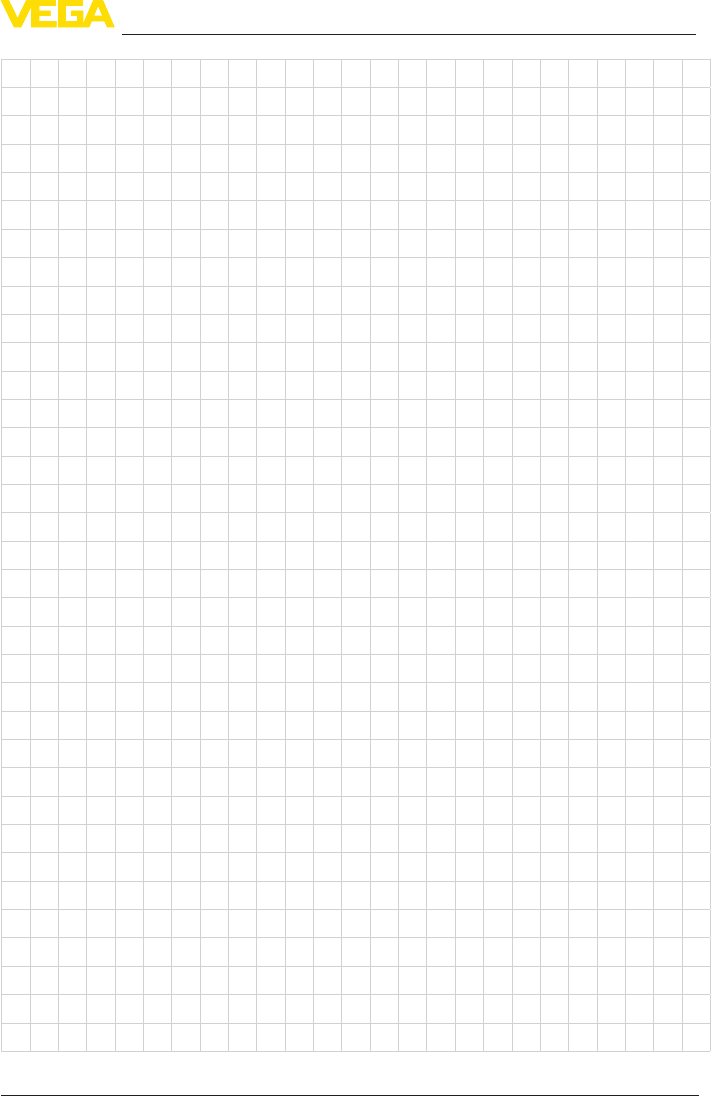
97
Notes
VEGAPULS 62 • 4 … 20 mA/HART - two-wire
36503-EN-161221
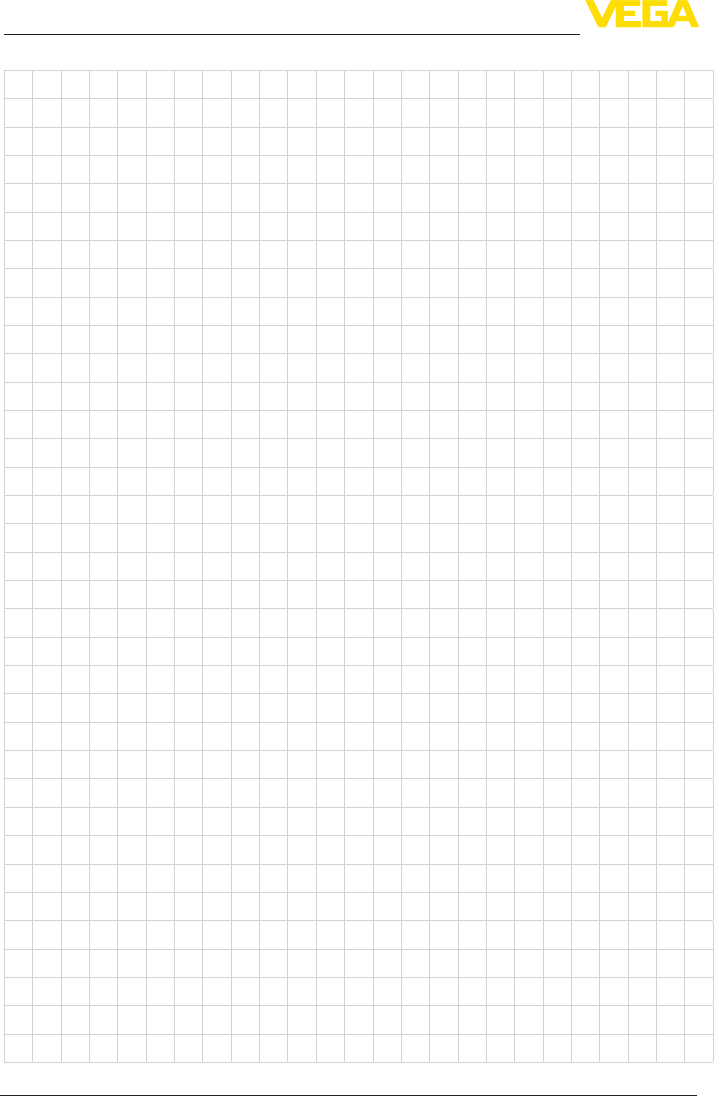
98
Notes
VEGAPULS 62 • 4 … 20 mA/HART - two-wire
36503-EN-161221
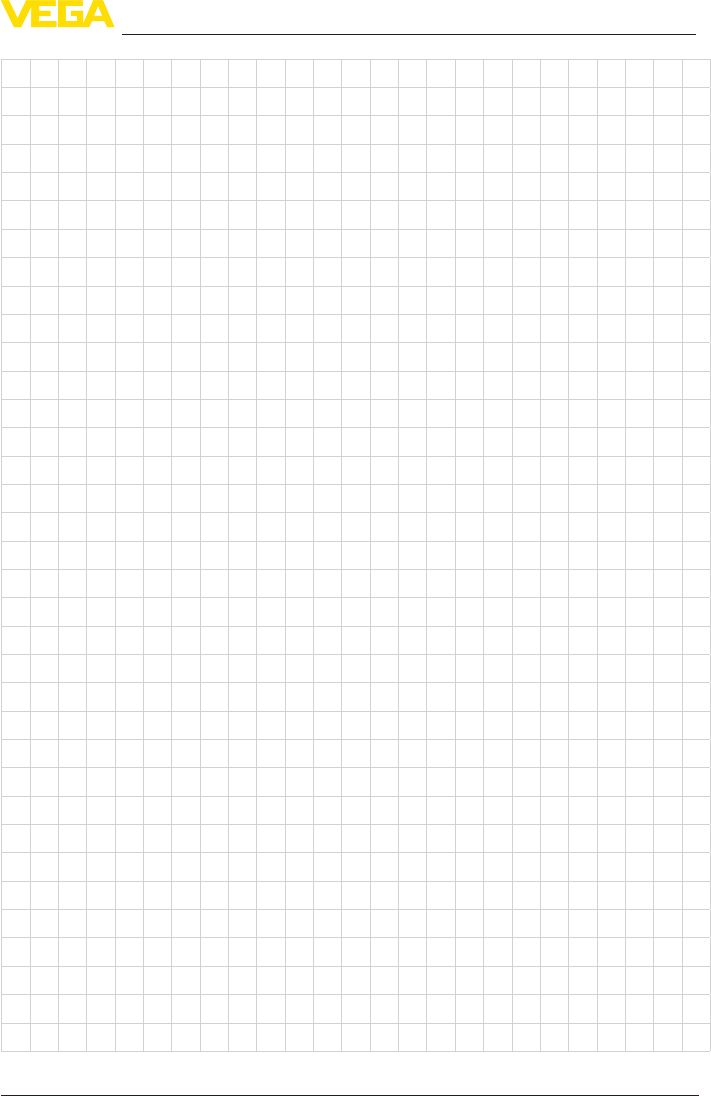
99
Notes
VEGAPULS 62 • 4 … 20 mA/HART - two-wire
36503-EN-161221

Printing date:
VEGA Grieshaber KG
Am Hohenstein 113
77761 Schiltach
Germany
36503-EN-161221
All statements concerning scope of delivery, application, practical use and operat-
ing conditions of the sensors and processing systems correspond to the information
available at the time of printing.
Subject to change without prior notice
© VEGA Grieshaber KG, Schiltach/Germany 2016
Phone +49 7836 50-0
Fax +49 7836 50-201
E-mail: info.de@vega.com
www.vega.com
